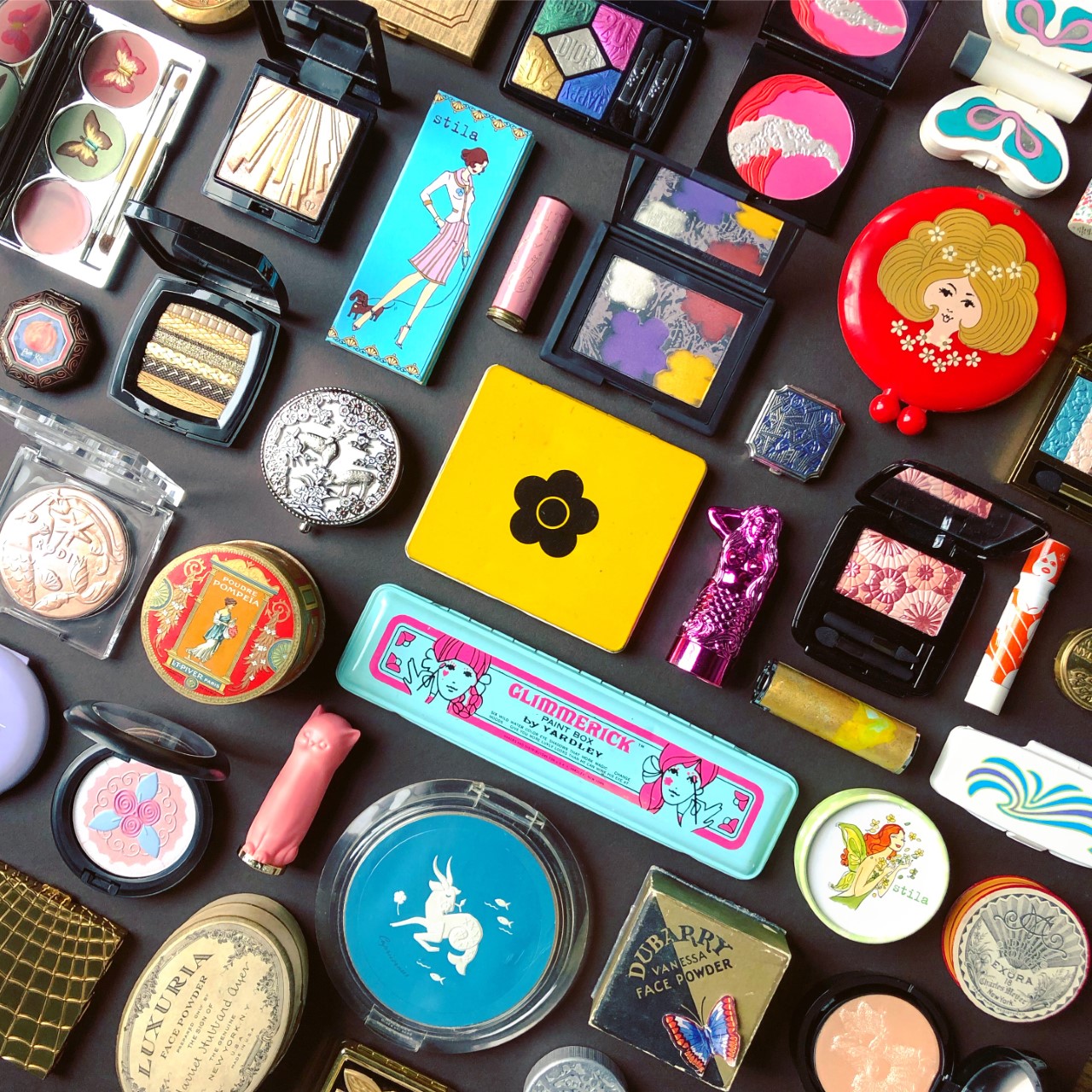This post is a result of my very kind mother-in-law gifting me some vintage DuBarry items, which she found while cleaning out her deceased mother's belongings. She knew I would appreciate them and give them a good home, and I'm really pleased to have vintage makeup that came from a family member. I'm okay with buying vintage items without knowing anything about who they belonged to, but obviously I feel more of a connection to the object when they come from someone I actually know. Anyway, these items inspired me to learn a little more about the DuBarry line and, of course, purchase some other items so they didn't feel so alone. 😉
I'm not going to rehash the entire history of the line, as both Cosmetics and Skin and Collecting Vintage Compacts have excellent, thorough histories of both DuBarry and Richard Hudnut, the founder of the line (along with many other brands.) The story in a nutshell: DuBarry originally started as a fragrance developed by Hudnut in 1902. In 1929 a makeup and skincare line was spun off the fragrance as an additional revenue source. The line wasn't doing so well by the late 1930s; however, ever the businessman, Hudnut expanded his lucrative "Success School" (a charm school to prepare young debutantes for their coming out events) to include a new DuBarry "Success Course" that borrowed many of the same principles but without the debutante focus. Part fat camp, part beauty and fashion tips, the Success Course earned the company over $4 million in a little over 3 years. Not only was it a major money-maker, the course also helped the DuBarry makeup line gain significant brand recognition. Since the 1960s the company passed through many owners but is still being sold today.
Without further ado, let's take a peek at some notable DuBarry items from their golden age (roughly 1940s-60s). I found this beautiful fan-shaped color guide over at the Baltimore Shoeseum, an online museum that specializes in swing era artifacts. Let's hear it for another Baltimore-based online museum! I'm sort of tempted to call and ask if they'd be willing to deaccession it to me, as I think the Makeup Museum would be a better fit. ;) I think this is from the early '30s.
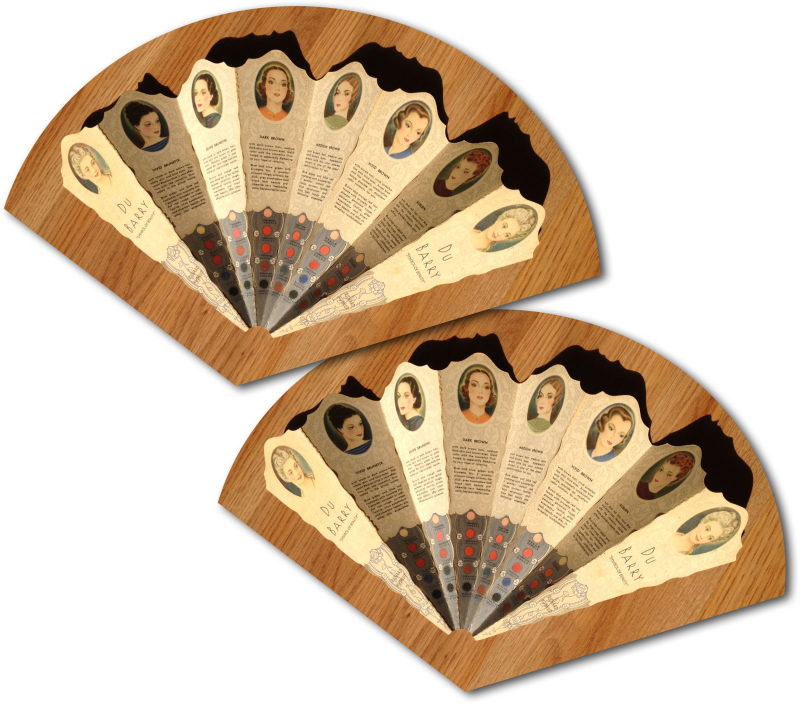 (image from baltimoreshoeseum.com)
(image from baltimoreshoeseum.com)
But what DuBarry was particularly known for was the use of an image of Madame du Barry, a.k.a. the last mistress of Louis XV who, along with rival Marie Antoinette, lost her head in 1793. Collecting Vintage Compacts' entry notes that Hudnut named the line after Madame du Barry, but I'm curious to know what the source is on that and why Hudnut chose her. In any case, there is no fabled tale of how Hudnut arrived at using Madame du Barry as inspiration the way there was with Harriet Hubbard Ayer's Madame Recamier skincare. And it shows: the company came up with vague likenesses of Madame du Barry for the product packaging rather than borrowing a real portrait.
The powder box below looks quite early and also resembles this etching.
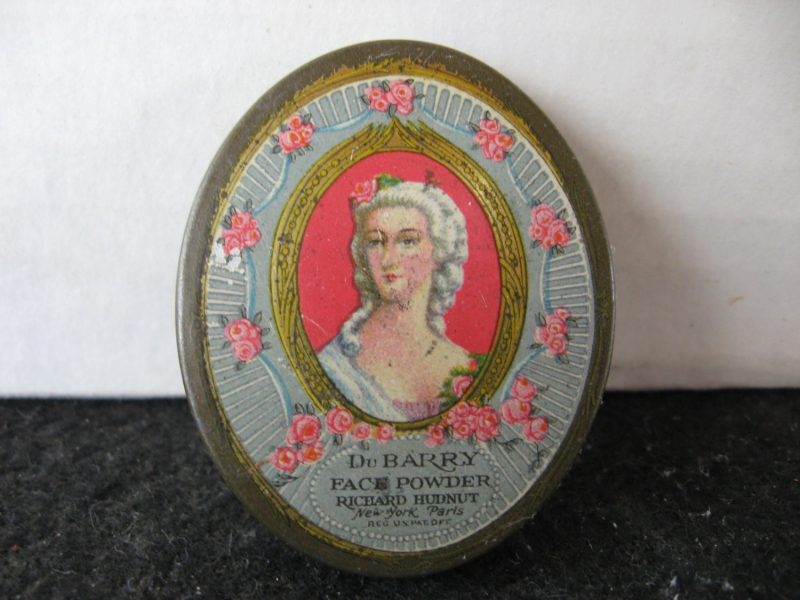 (image from etsy.com)
(image from etsy.com)
This box also appears to be very early and is somewhat similar to this portrait. These two boxes are the only ones I've seen with these particular designs, so I wonder if they were samples or prototypes not actually put into mass production.
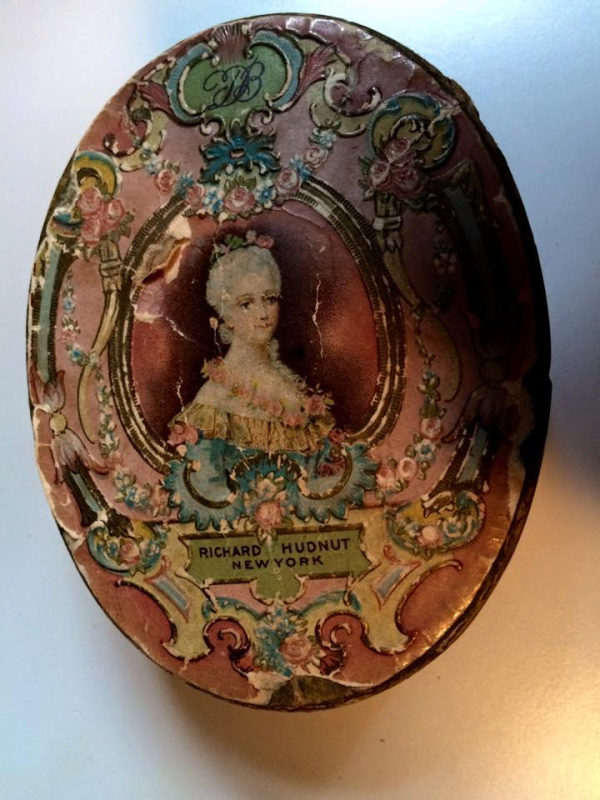 (image from etsy.com)
(image from etsy.com)
The only exception to DuBarry's lack of faithful reproductions of the Comtesse was a sketch of a sculpture by Augustin Pajou.
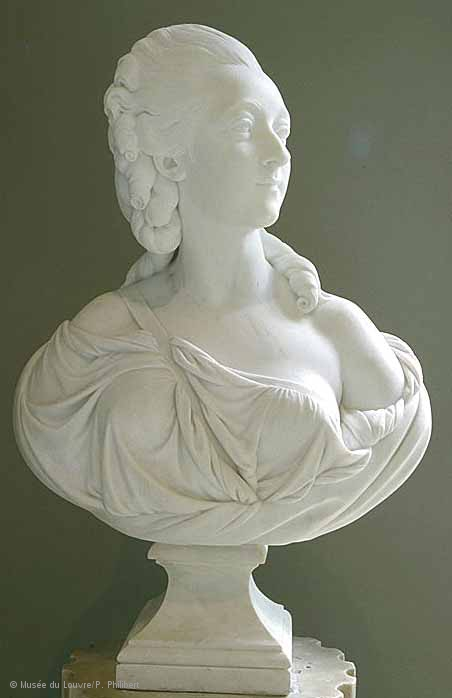
(image from louvre.fr)
Roughly from the start of the line in 1929, DuBarry utilized a drawing of the sculpture for ads and powder boxes and continued to use it up until the early to mid '40s.
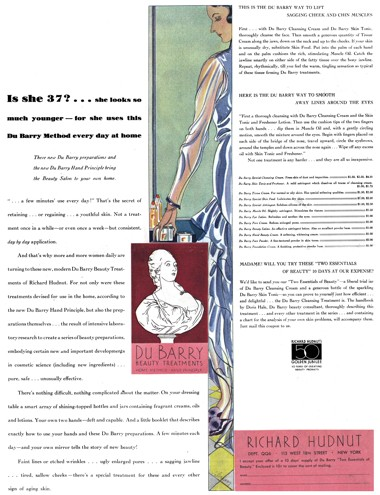
(image from cosmeticsandskin.com)
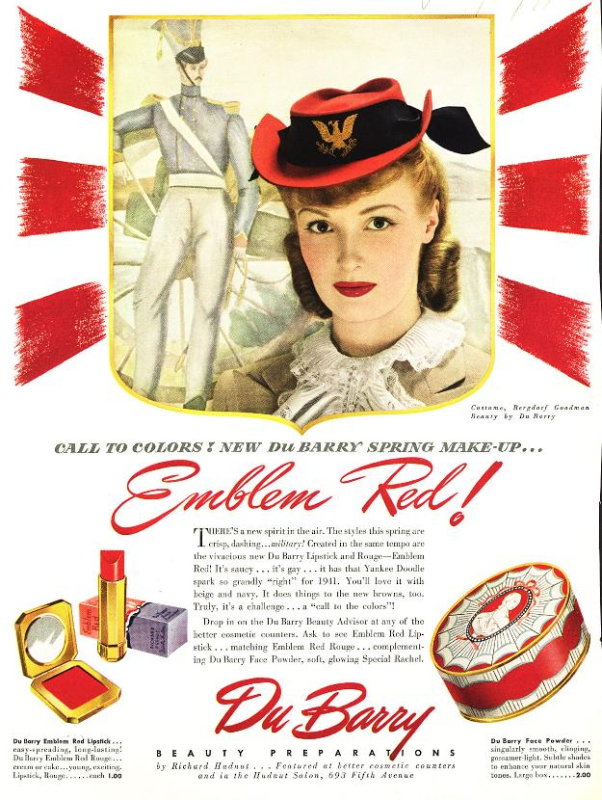 (image from library.duke.edu)
(image from library.duke.edu)
Naturally I had to get one to add to the Museum's collection.
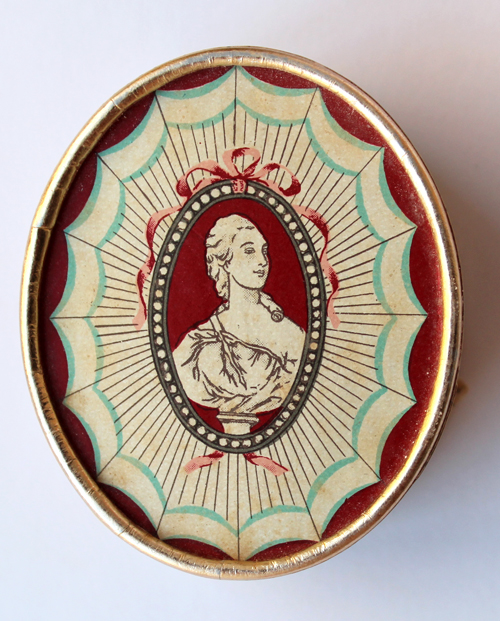
Okay, maybe I got 2! But the design was a little different and I figured variety couldn't hurt.
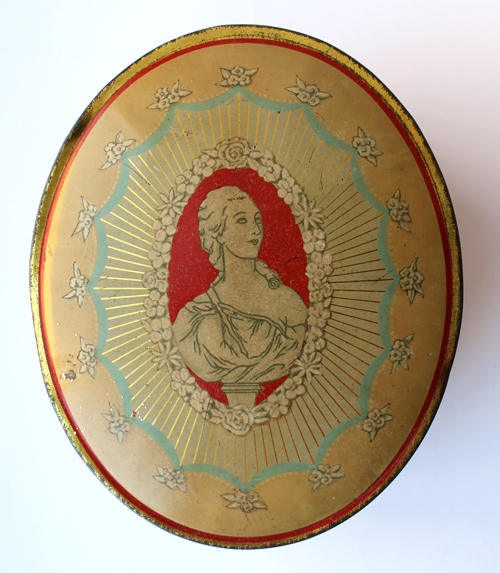
I also liked the pattern on the sides.
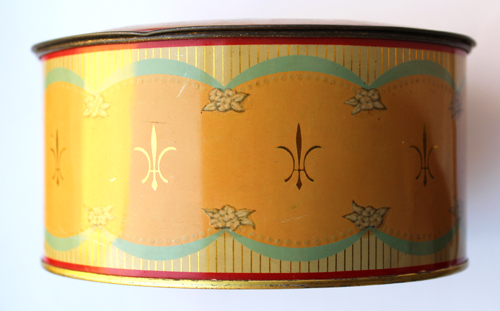
Just to give you a sense of the size, that 2nd box is body powder and way bigger than the face powder pox.
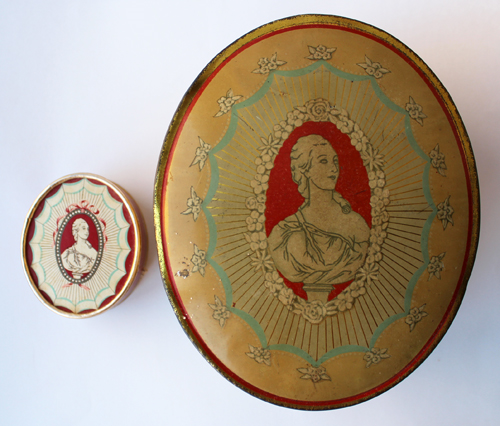
But starting around 1935 (at least according to the ad below), DuBarry displayed a different, completely imaginary representation of Madame du Barry, and it appears that in 1942 they began adding her to their packaging and phasing out the other, accurate Madame du Barry depiction. I've looked everywhere online and there is no portrait of Madame du Barry that even remotely resembles this one.
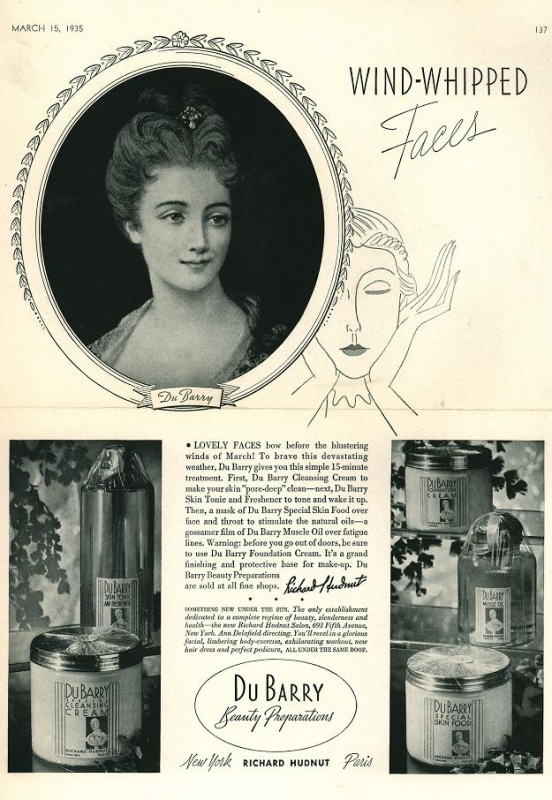 (image from library.duke.edu)
(image from library.duke.edu)
It appears to be an amalgam of the Pajou sculpture (the asymmetrical, drapey neckline), this 1770 portrait by François-Hubert Drouais (hair is up with one lone curl around the neck), and this 1771 portrait, also by Drouais (hairstyle is similar, although DuBarry seems to have swapped out the blue ribbon for a blue jewel on the packaging). You can see, however, that the woman on the box is not a direct copy of any portrait, as was the case with the Pajou sculpture.
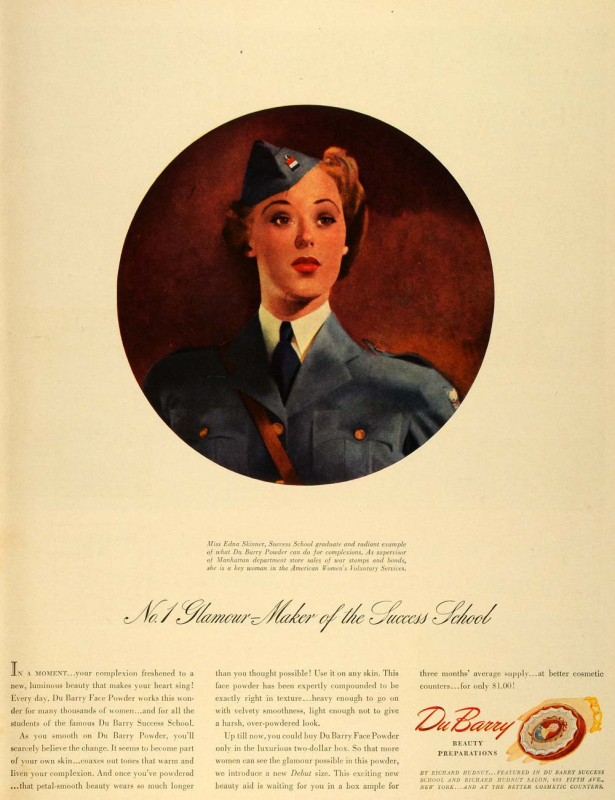 (image from periodpaper.com)
(image from periodpaper.com)
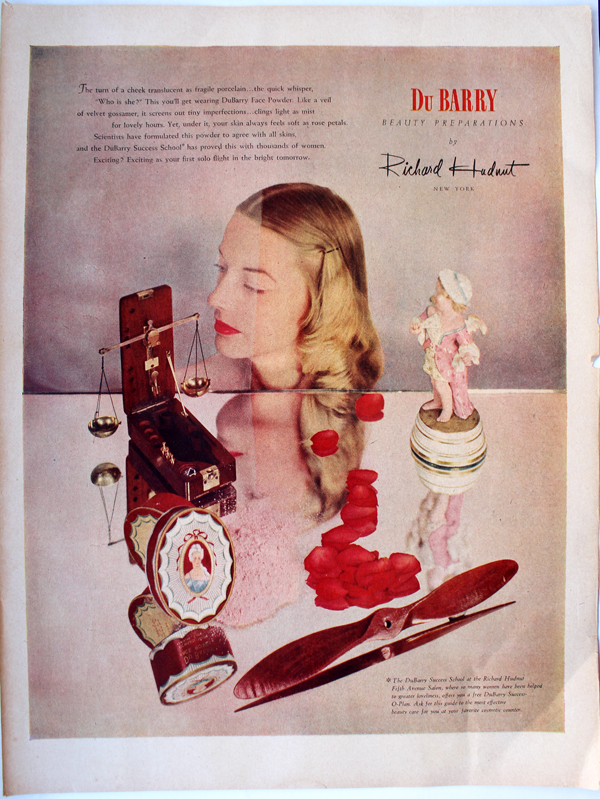
I bought this one too, along with the ad above. 🙂
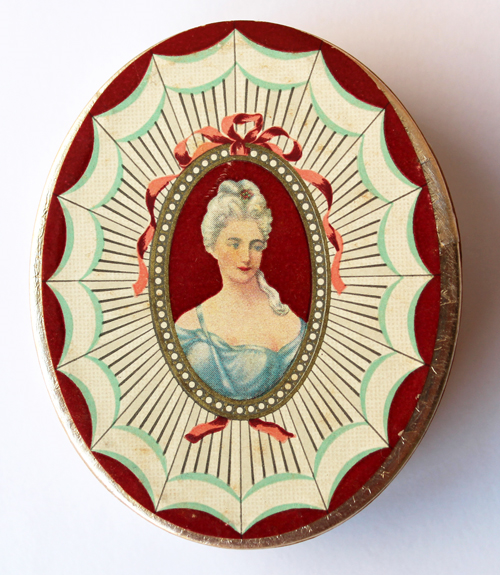
Then in 1949 DuBarry changed the likeness on the packaging yet again. This time Madame du Barry appears with the ridiculously high powdered wig hairstyle that we associate with the French Revolution era. Again, as far as I could tell, there is no portrait of Madame du Barry that resembles this – here's the closest one I found – but even the face on this DuBarry packaging looks nothing like her!
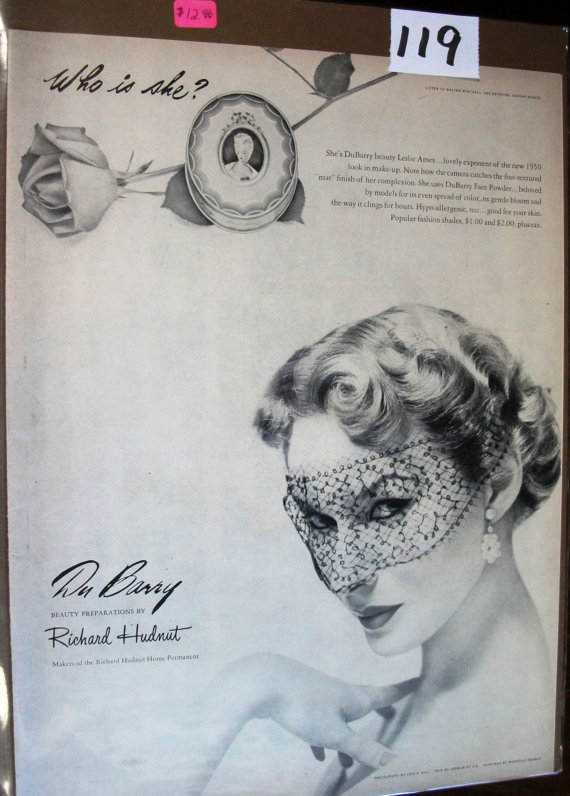 (image from etsy.com)
(image from etsy.com)
This image was used through the mid 1950s.
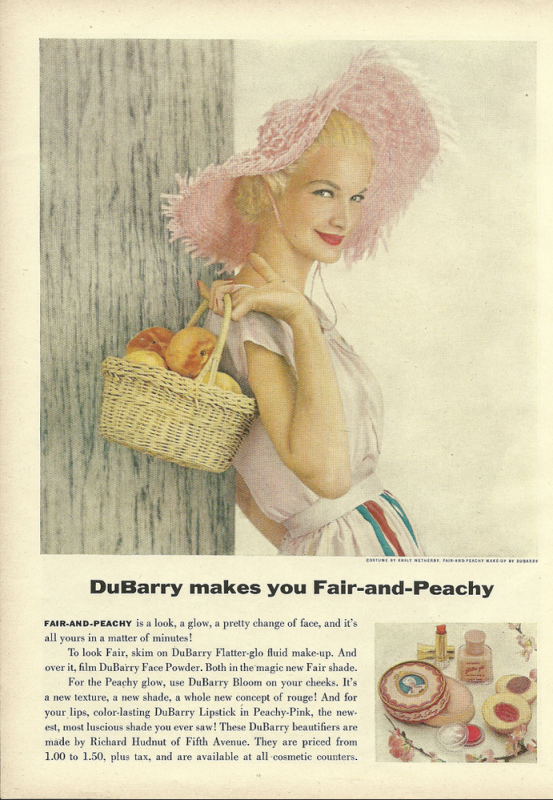 (image from flickr.com)
(image from flickr.com)
To round out the Madame du Barry representations I had to get this one too. This is probably the most common DuBarry box I came across.
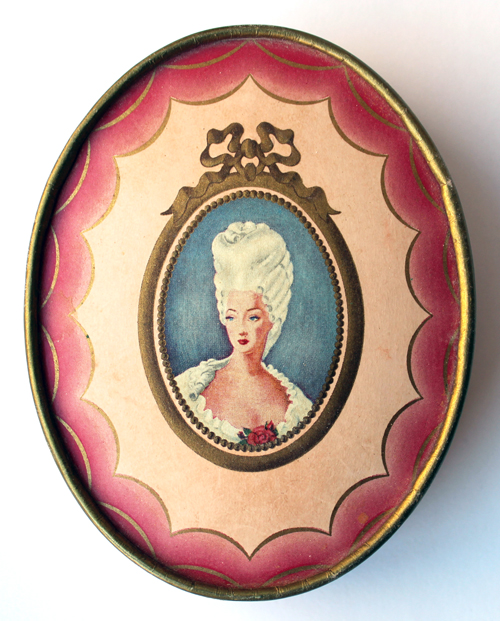
The next item I thought would be a nice addition to the Museum's DuBarry holdings were these lipstick blotting sheets. Clearly men are the only ones who are affected by lipstick transfer and it's their comfort we have to worry about most, not the simple fact that women would just like a lipstick that stays put so we're not constantly touching up. *eyeroll* Still, I thought it was amusing that they put a cartoon man on the case and I don't have any vintage lipstick blotters in the Museum's collection. (And like the DuBarry powder boxes it was super cheap, which is always a plus.)

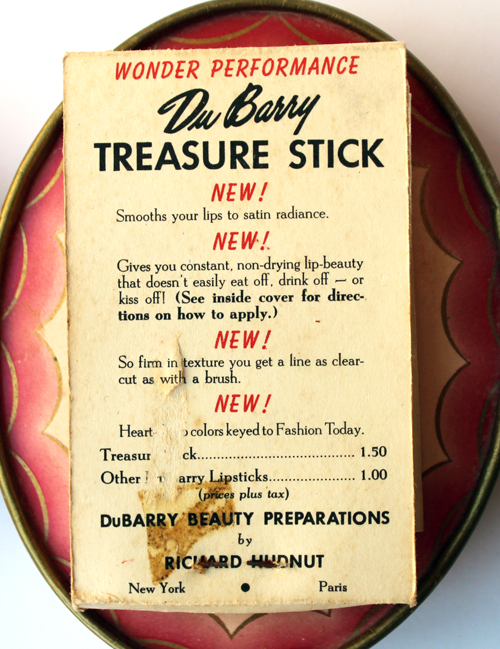
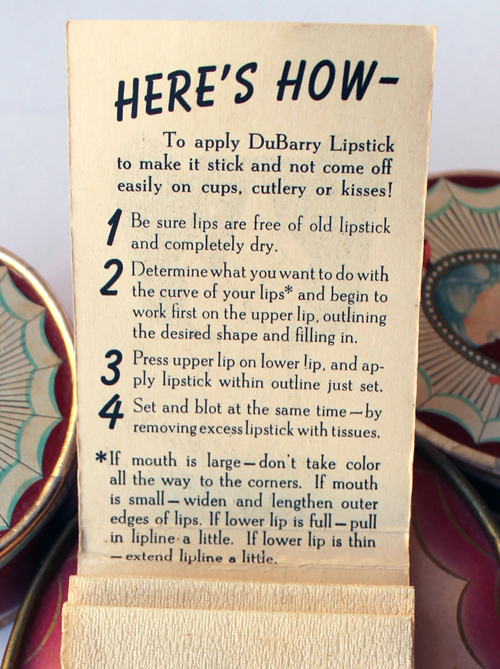
Based on the graphics I really thought this was from the early '60s, but I was way off. Turns out DuBarry's "Treasure Stick" lipstick was introduced in 1947 and was sold at least through 1951, according to the ads below, so these blotting sheets are from around then as well.
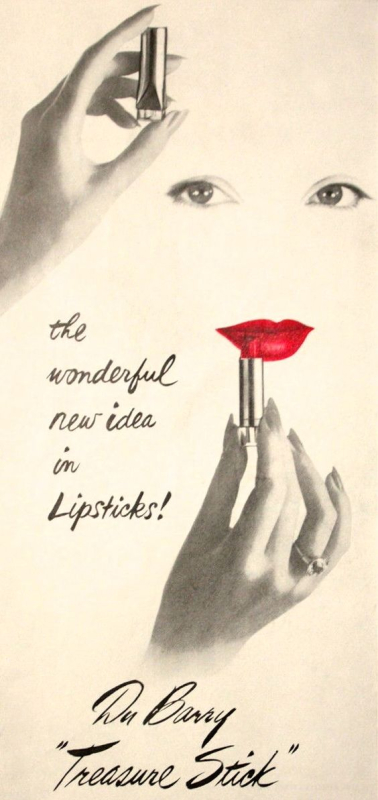
(image from pinterest.com)
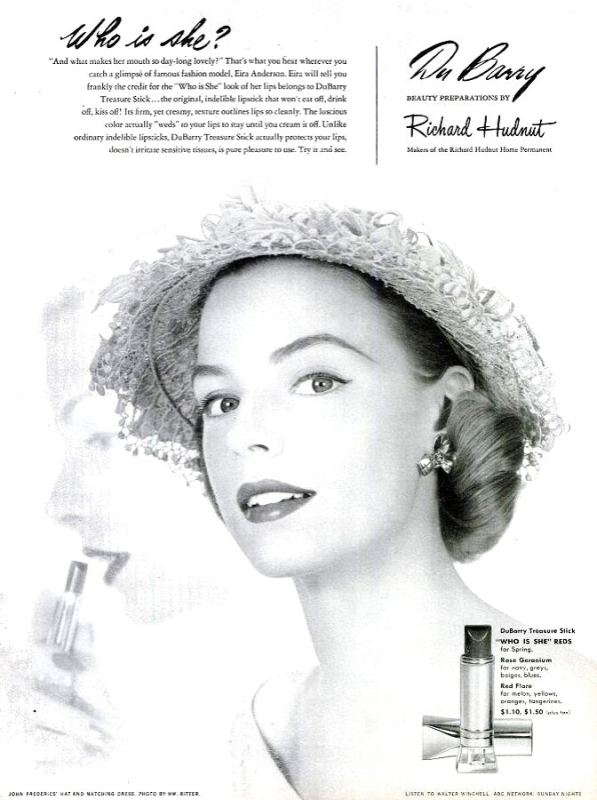 (image from etsy.com)
(image from etsy.com)
Finally, here are the items that once belonged to the husband's grandmother which my mother-in-law kindly passed along to me. Thanks, M.!
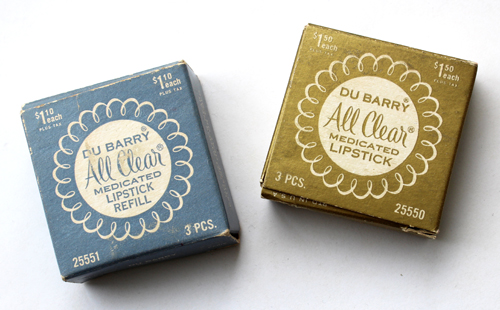
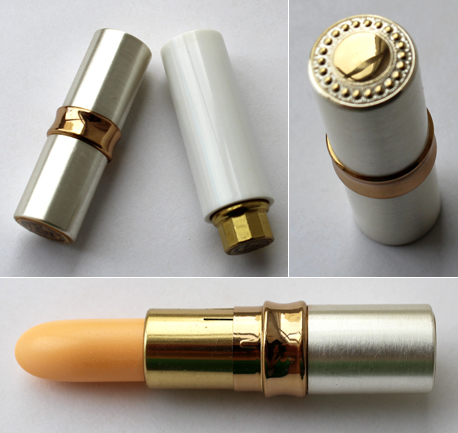
Naturally I was eager to find out approximately when they were from. Just at first glance they appeared to be early '60s to me, but I couldn't say so with any certainty, so off I went to search for clues. Based on the ads below it didn't look like the lipsticks I have are from the '40s.
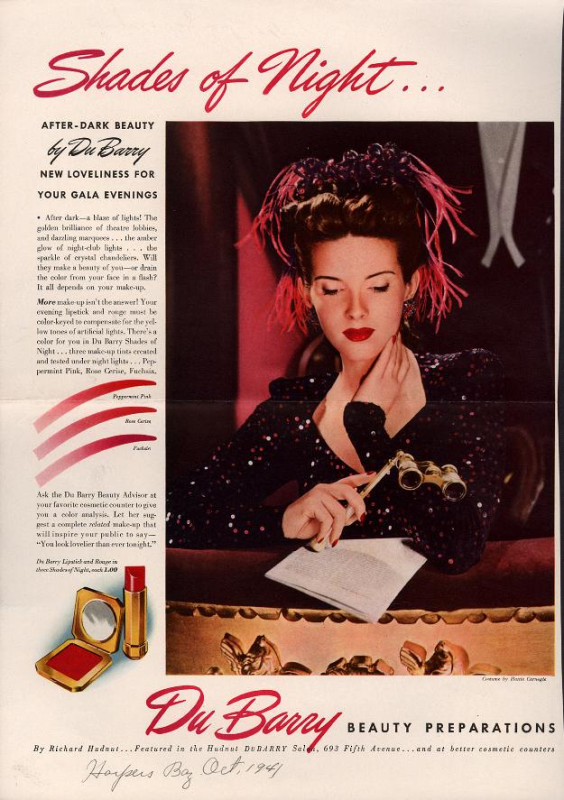 (image from library.duke.edu)
(image from library.duke.edu)
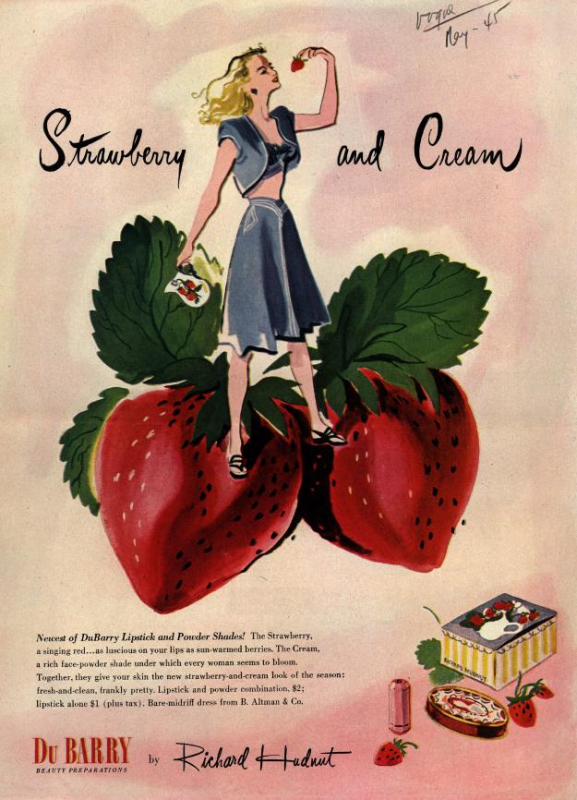 (image from library.duke.edu)
(image from library.duke.edu)
It wasn't from the mid-'50s either.
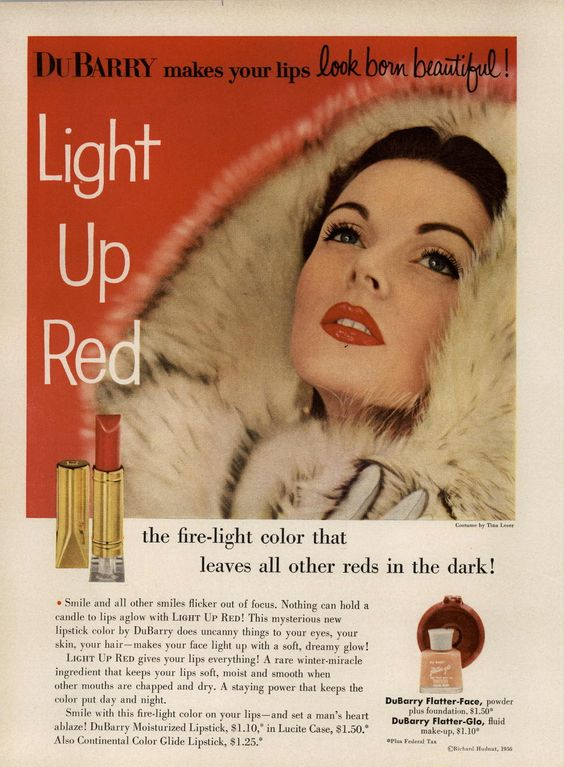 (image from pinterest.com)
(image from pinterest.com)
Low and behold, in 1958 we see a new lipstick tube and bullet that are very similar to those bestowed upon the Museum. With the debut of the "Royal" lipstick (you've seen this ad before), there also came a new case. However, it's gold-toned and not silver like the ones I have. Hmmm…
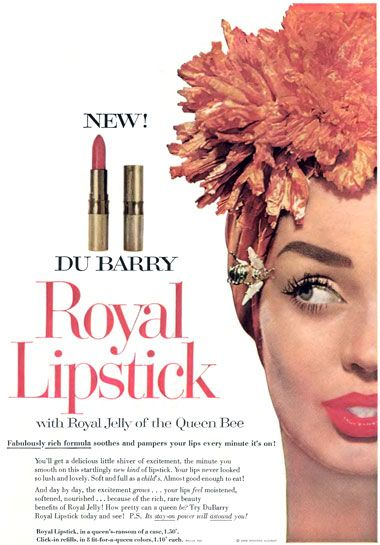
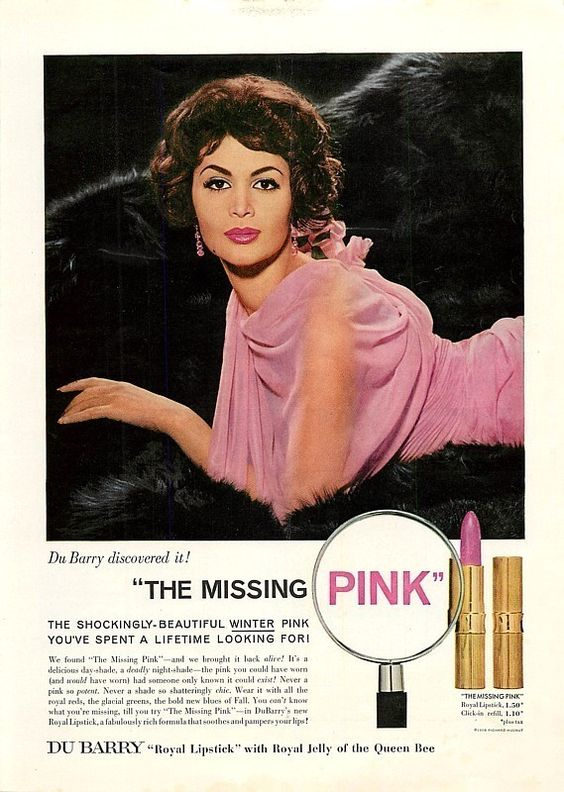
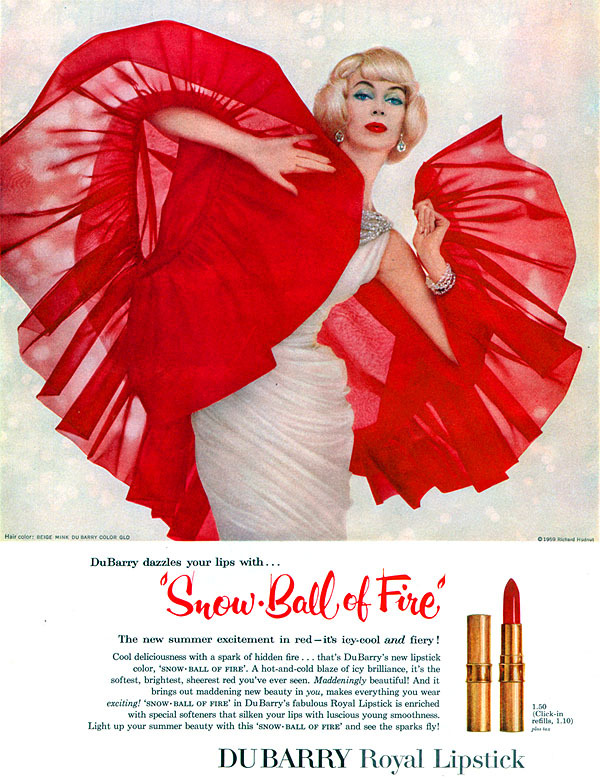 (image from mudwerks.tumblr.com)
(image from mudwerks.tumblr.com)
It's hard to tell, but judging from this 1961 ad below, it looks like DuBarry made the switch to the silver casing by then.
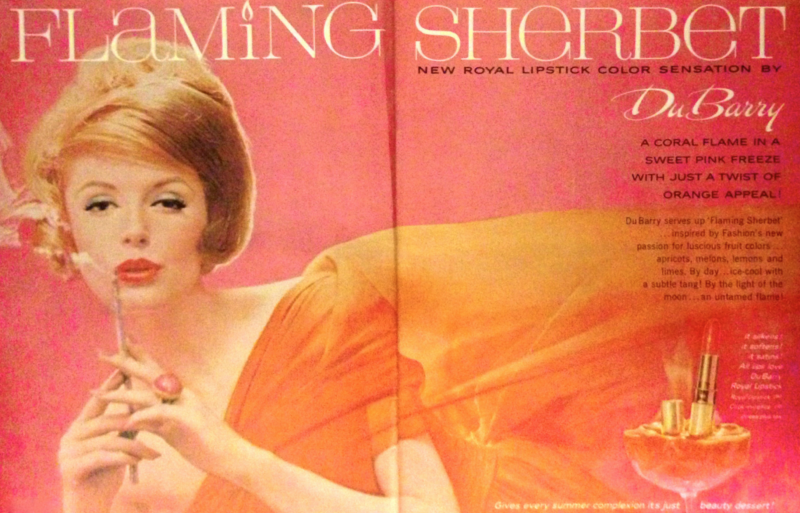 (image from pinterest.com)
(image from pinterest.com)
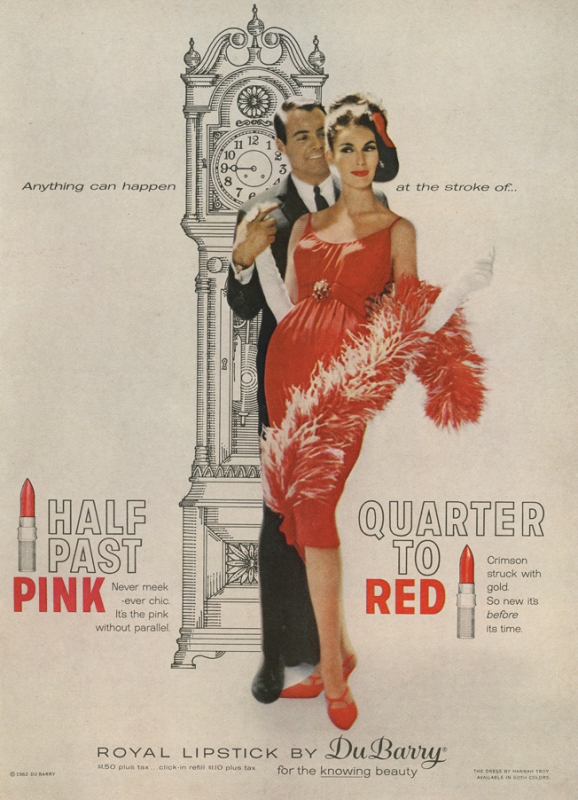 (image from adweek.com)
(image from adweek.com)
So while I'm still not 100% sure, I can say with confidence that the lipsticks I was given date from the late '50s or early '60s, especially given that the prices are the same on the refill boxes and in the ads.
Just for fun, how cute is this "Morning Noon and Night" set? Now that would be quite a find!
 (image from pinterest.com)
(image from pinterest.com)
DuBarry went on to launch a pretty interesting campaign for their Glissando range starting in 1964 – at least, from an advertising point of view. Since there were so many ads I simply couldn't narrow it down, but they were a good representation of mid to late '60s style. As noted earlier, the brand changed hands several times over the years but is still around today. I kind of wish they would look to their golden age and re-introduce packaging with an updated (and accurate) depiction of Madame du Barry. As Collecting Vintage Compacts points out, the Comtesse's consumer appeal cannot be denied: "[The DuBarry] fragrance could not have failed to be recognized by the buying public as representing the essence of feminine beauty, intrigue and even a hint of scandal." Indeed, I can see many people buying makeup with the King's favorite adorning the packaging. 🙂
So those are some highlights from DuBarry when they were in their prime. Which ones did you like best?
Save
Save
You might remember this neat ad for Max Factor's Italian Touch that I featured in the summer exhibition.
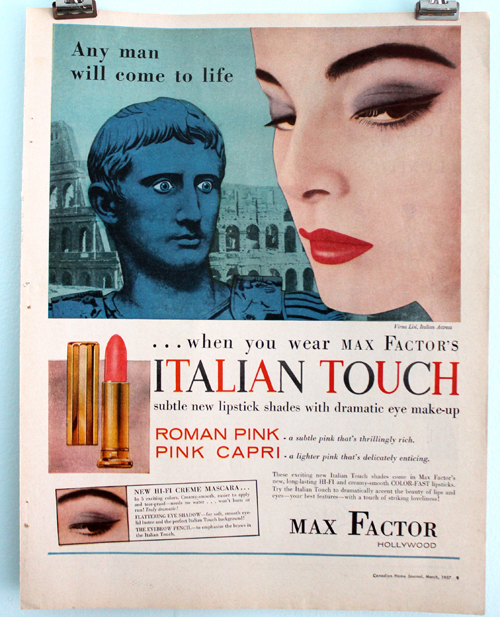
I also mentioned there was a really cool bust used as a store prop floating about on E-bay, but that it was pricey. Well, as it turns out I didn't have to worry about the cost because a certain very thoughtful and generous husband purchased it for me! I really don't have anything like this in the Museum's collection and I was so happy he snagged it for me. As far as store advertising goes it's pretty unique.
I've named him Enrico. 🙂
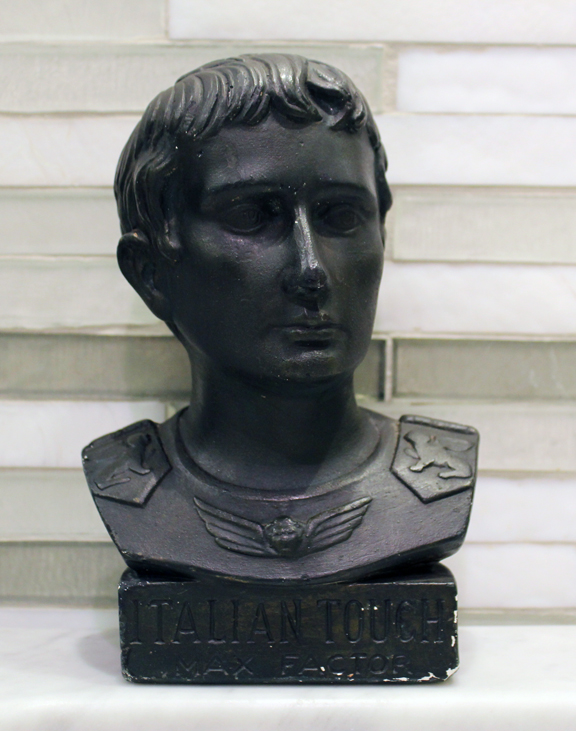
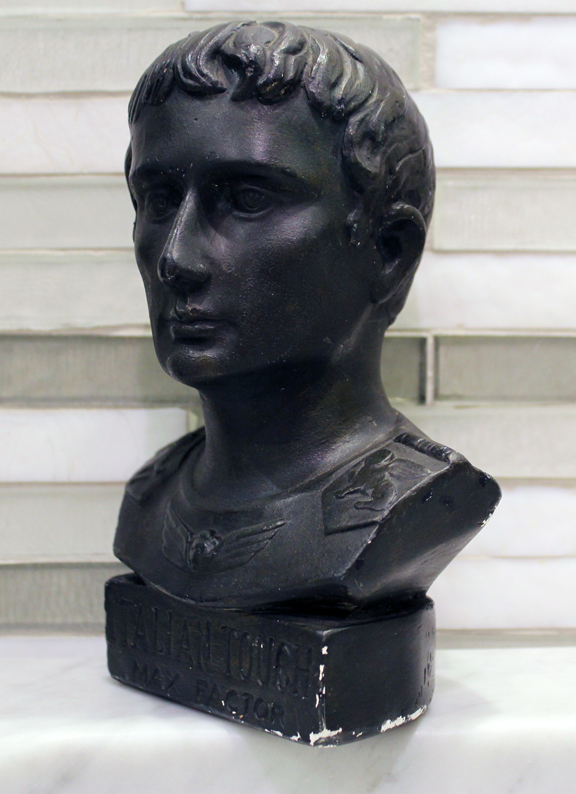
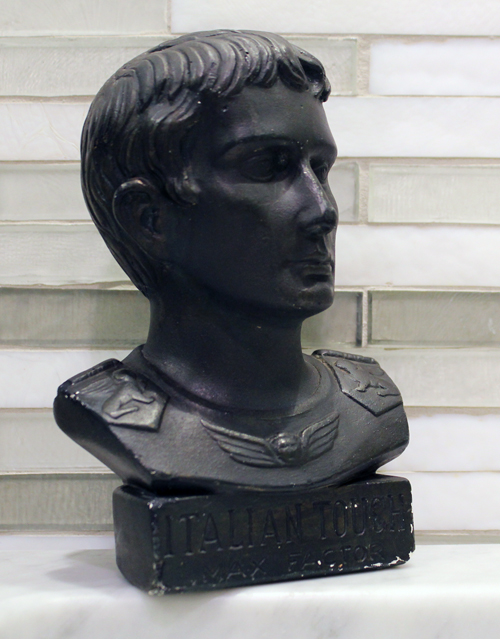
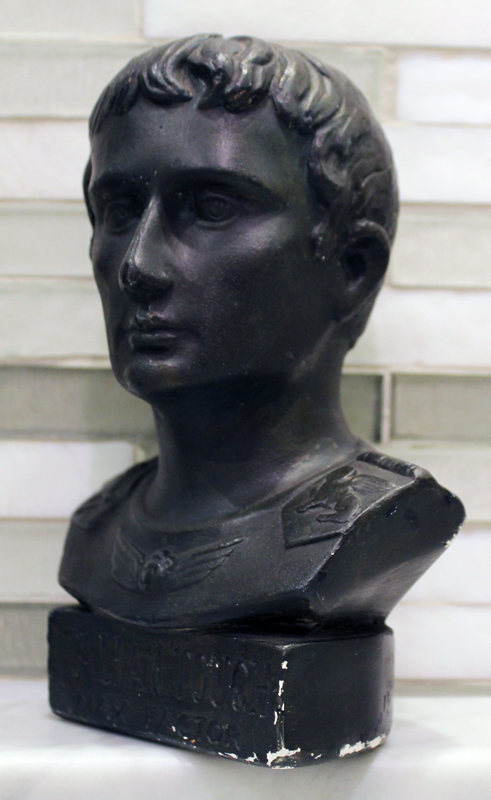
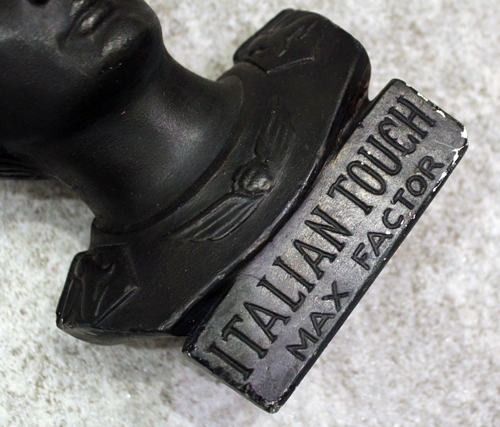
I love the sphinxes on each shoulder! Perhaps they were borrowed from the Augustus of Prima Porta.
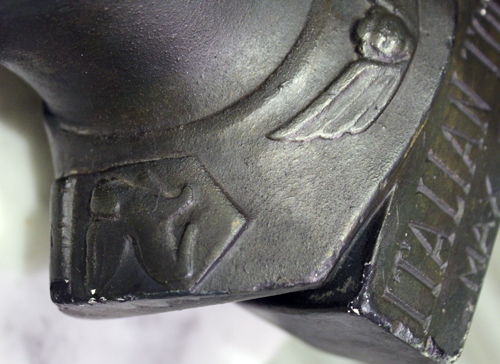
I couldn't find a complete history of the campaign but it must have been quite large, given that I've seen ads in various languages. In addition to plain old English, I also came across French:
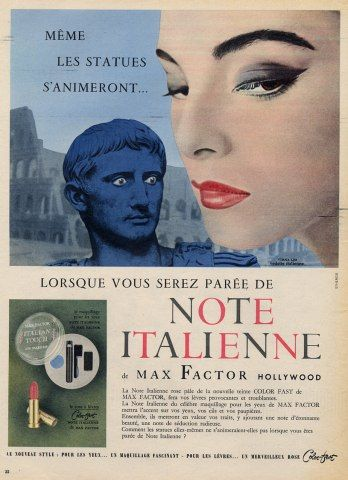
(image from hprints.com)
Italian (of course…additionally, Italian film star Virna Lisi starred as the model, which further demonstrates how calculated the campaign was):
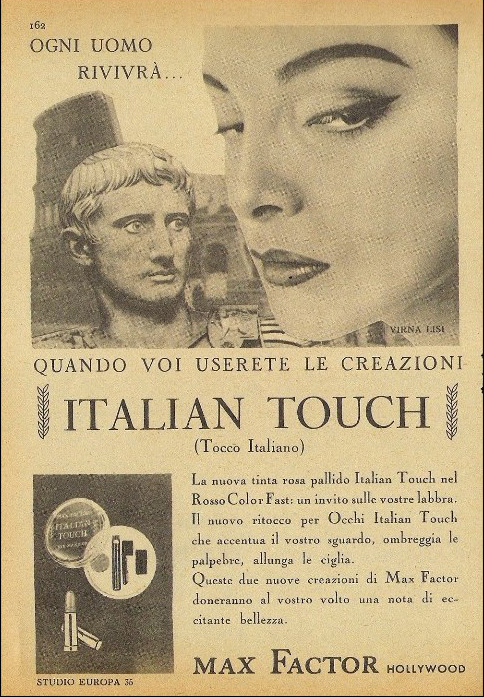
(image from delcampe.net)
And Dutch. This is particularly fascinating given that the e-bay seller Enrico was purchased from was located in the Netherlands. I also would have loved to get my hands on the little set pictured in these ads to round out a sort of capsule collection of the Italian Touch campaign, but I'm pretty satisfied with the bust.
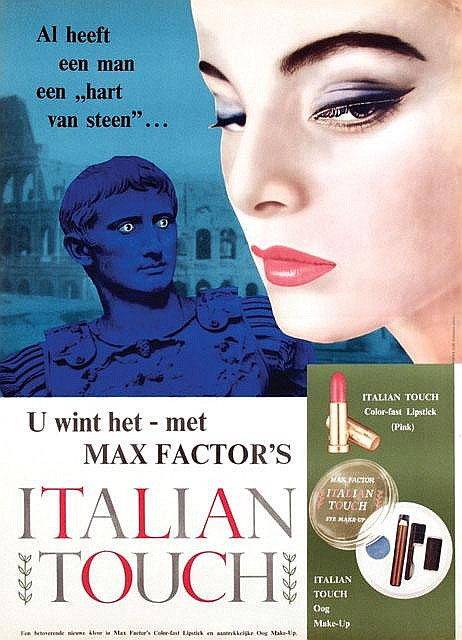
(image from invaluable.com)
I also found these two English-language ads from Canada and Singapore.
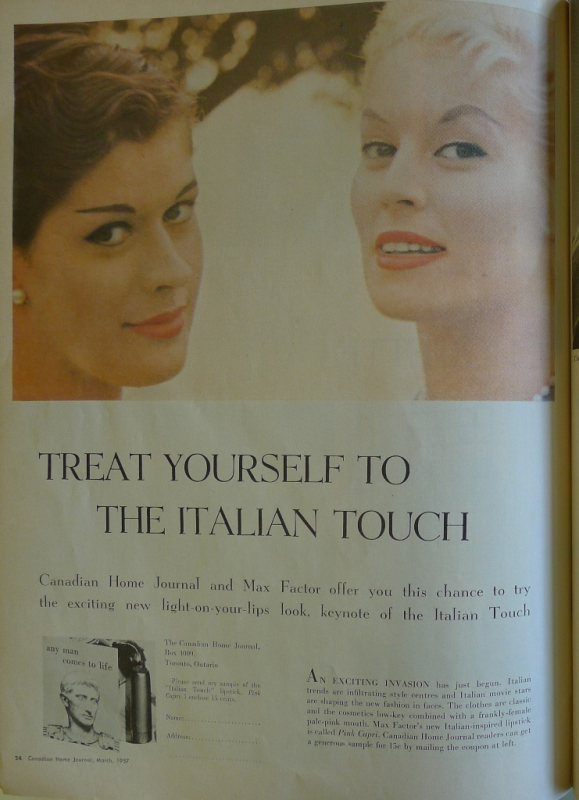 (image from middlebrowcanada.com)
(image from middlebrowcanada.com)
I couldn't remove the watermark from this but you get the gist.
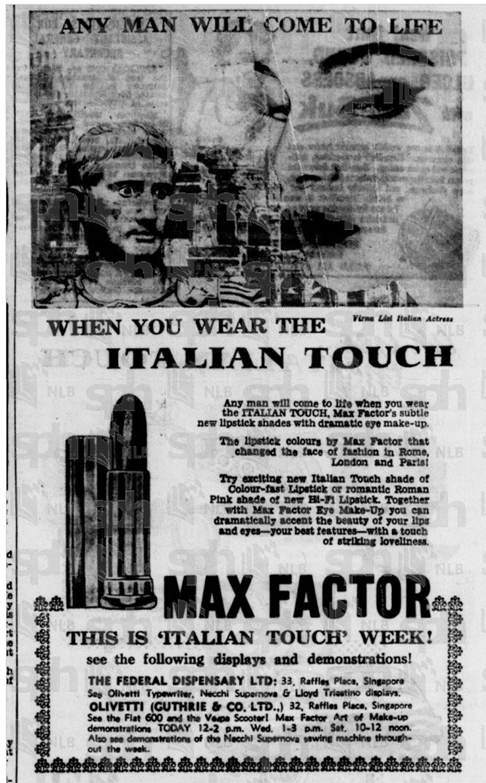
(image from eresources.nlb.gov.sg)
In the U.S., a new shade called Roman Touch was available in several products in addition to the Italian Touch collection.
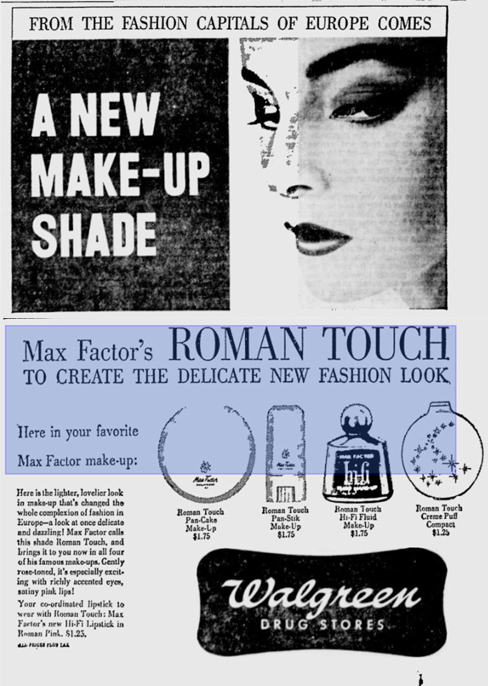
(image from news.google.com)
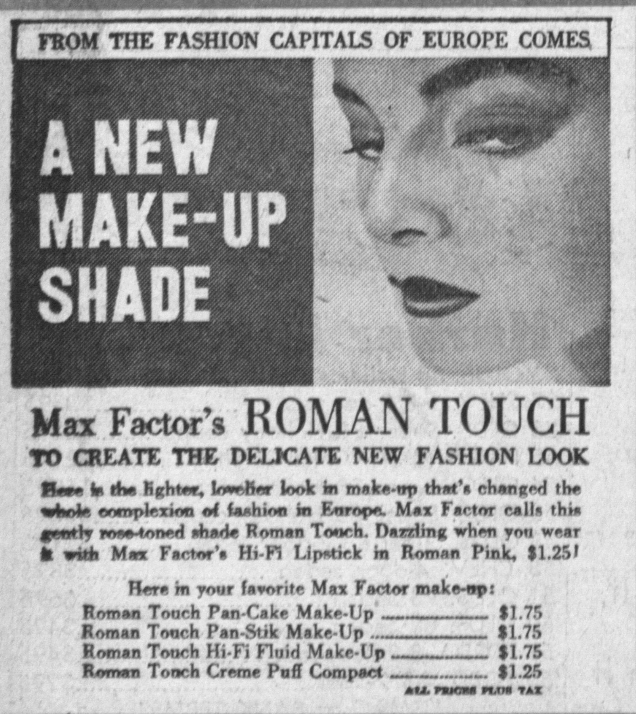 (image from arch.torranceca.gov)
(image from arch.torranceca.gov)
All in all, I think this is one of the strangest, yet well-planned advertising campaigns for a vintage collection I've come across. Normally I'd be creeped out by the idea of statues coming to life, but in this case I think the offbeat nature of it is quite amusing. And based on what Museum Advisory Committee member Sailor Babo has told me about his conversations with him, Enrico is totally harmless and has lots of interesting stories.
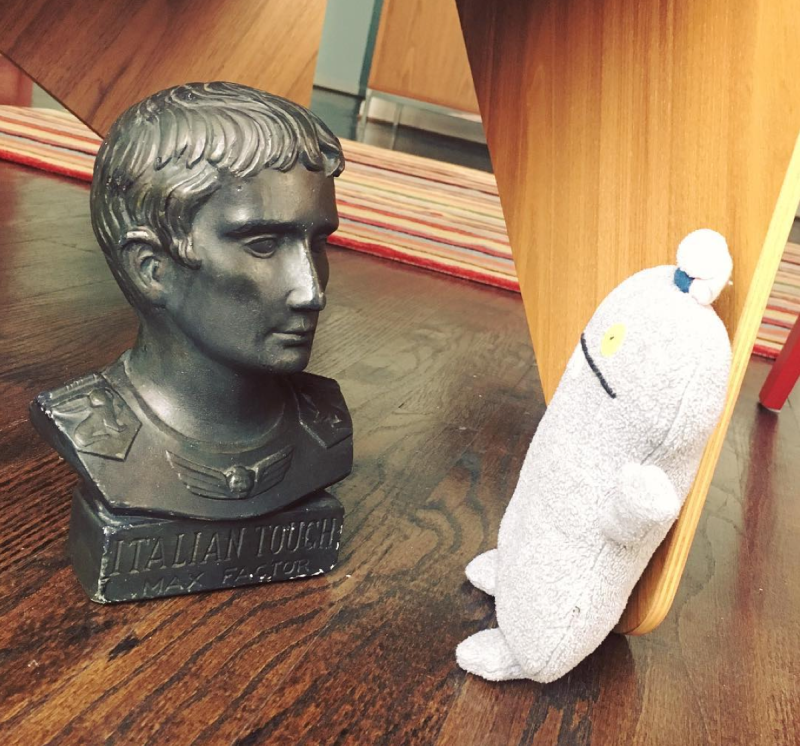
What do you think about this latest Museum gift? Big huge thanks to my awesome and supportive husband. 🙂
For St. Patrick's Day I originally thought I'd do a quick round-up of vintage compacts adorned with clovers and such. I was searching for a particular vintage Stratton compact, one that has more traditional lucky symbols, and came across this one instead. It was so delightfully strange I simply had to shove aside the other compact I was looking for to investigate this one further.
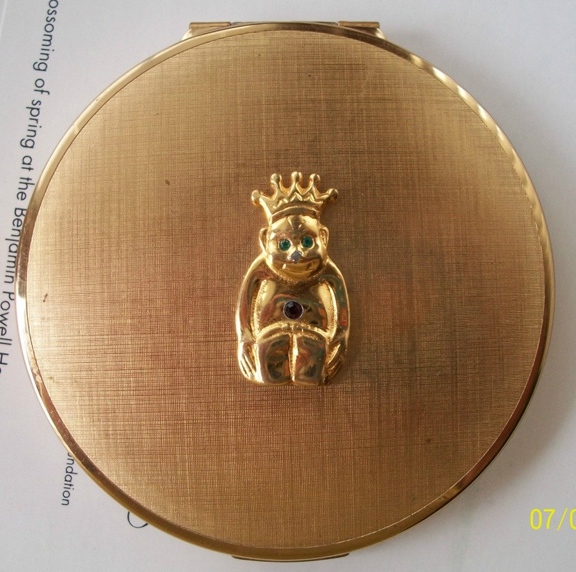 (image from etsy.com)
(image from etsy.com)
Here's another from a later date (ca. 1950s).
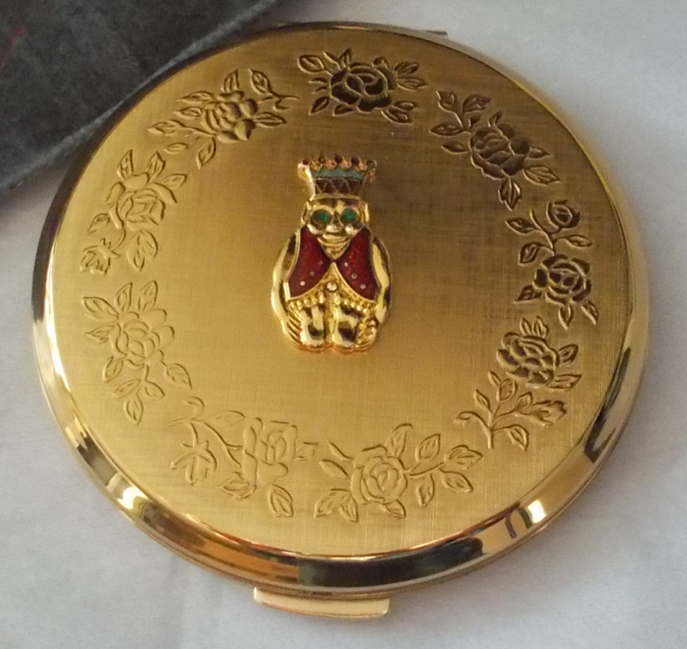 (image from etsy.com)
(image from etsy.com)
If you're all, "WTF am I looking at?", don't worry, I was too. Apparently the little fella on the front of these compacts is known as a billiken, a symbol of good luck. Both of the websites that list these compacts for sale point out that the Stratton compacts with a billiken on the front are very rare, and are on page 103 of Mueller's Overview of American Compacts and Vanity Cases. So off I went to consult my copy.
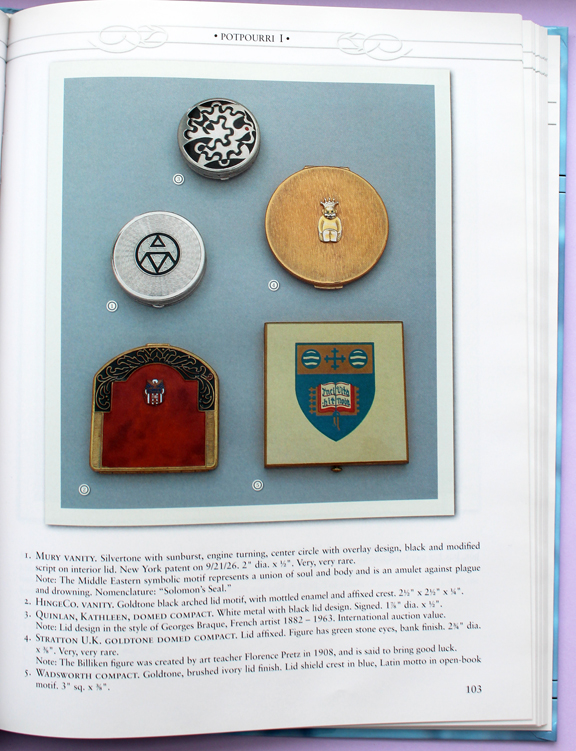
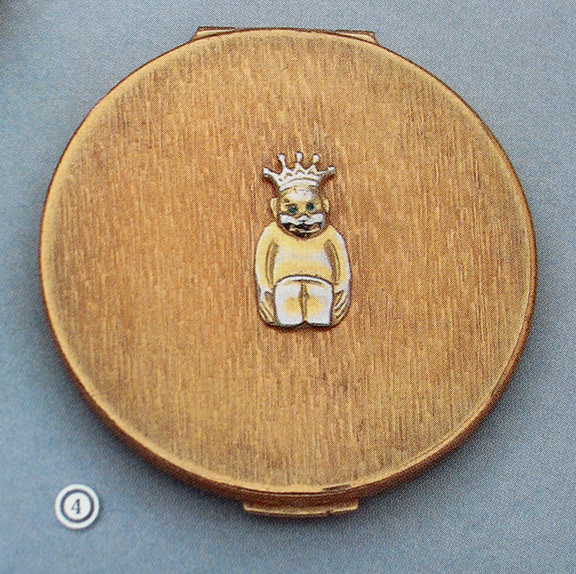
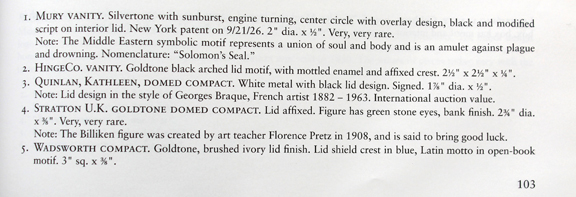
Okay, so the billiken was created by an art teacher in 1908 and is a lucky figure. That's a start, but not enough information for me. So I went searching and found myself down quite a bizarre rabbit hole. The billiken was created by Florence Pretz in 1908 after it appeared to her in a dream, while she found the name in an 1896 poem called "Mr. Moon: A Song Of The Little People" by Canadian poet Bliss Carman. The billiken represents "things as they ought to be." Buying a billiken for oneself brought luck, but receiving one as a gift brought even more good fortune. Pretz explained to the St. Louis Post-Dispatch, "I concluded if there is a chance that we shape our own lives, and my clay was mine to fashion as I would, I might as well make an image, which embodied hope and happiness to sort of live up to."
I found her original design patent at the Virtual Corkscrew Museum (the fact that a corkscrew museum exists is proof that a makeup museum is a completely normal and valid idea, yes?) Such a weird-looking little creature, what with the pointy head, prominent ears and compact body – not quite human but not animal-like either.
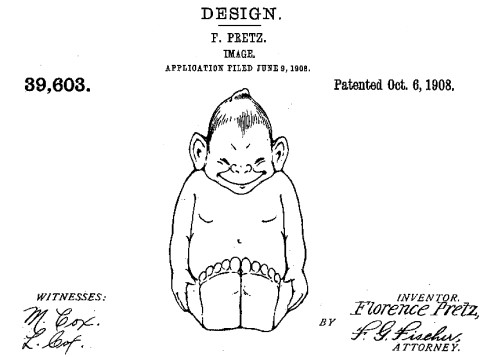
(image from bullworks.net)
And here's a sketch.
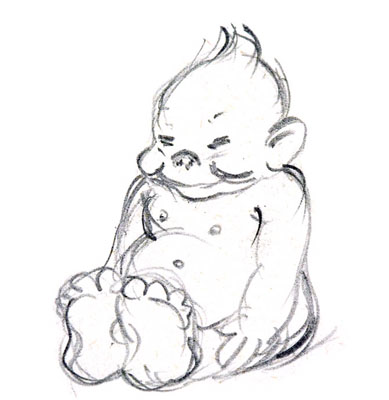
(image from slu.edu)
The billiken's popularity skyrocketed less than a year after the patent was filed and took off as a novelty across the U.S., its likeness appearing on all kinds of ephemera from basic figurines to salt shakers and belt buckles. St. Louis University even adopted the billiken as their mascot, which they still use today.
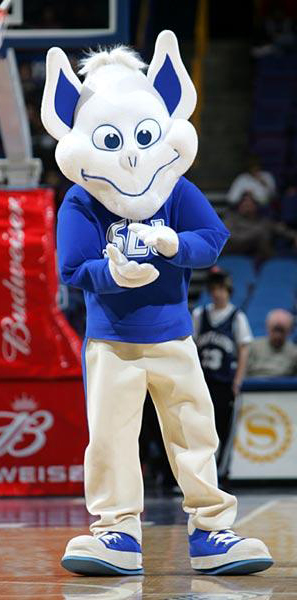
(image from stltoday.com)
The craze also spread to Alaska, where billikens were carved from whale bone/teeth or walrus ivory and sold as souvenirs. They're still made today, of course from different materials.
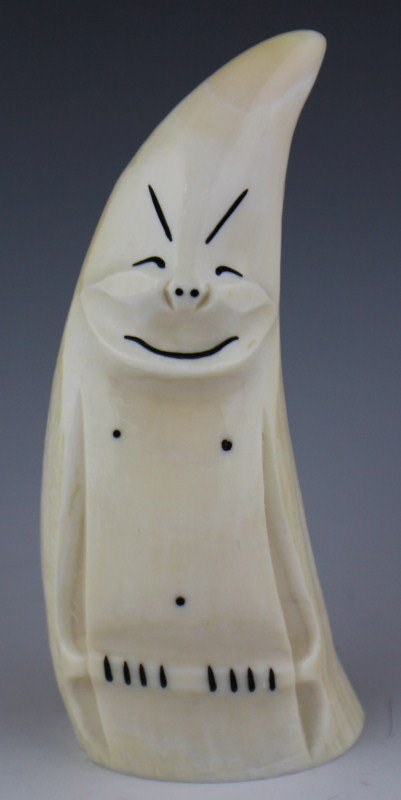
(image from liveauctioneers.com)
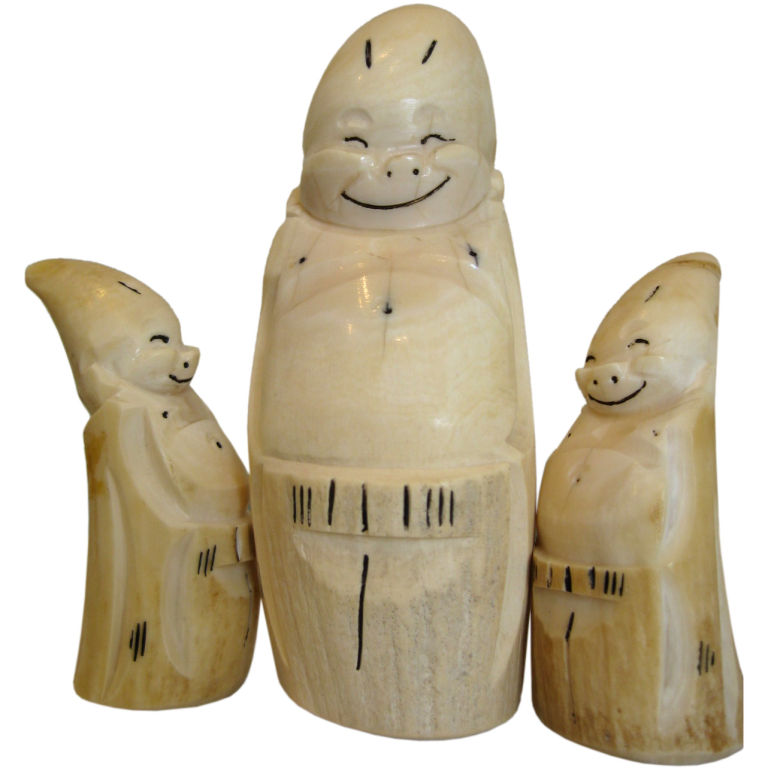 (image from 1stdibs.com)
(image from 1stdibs.com)
Finally, the Royal Order of Jesters, a group belonging to the larger entity of Freemasons, adopted the billiken as their symbol in 1911. The billikens associated with the Jesters differ from other figures as they're usually wearing crowns.
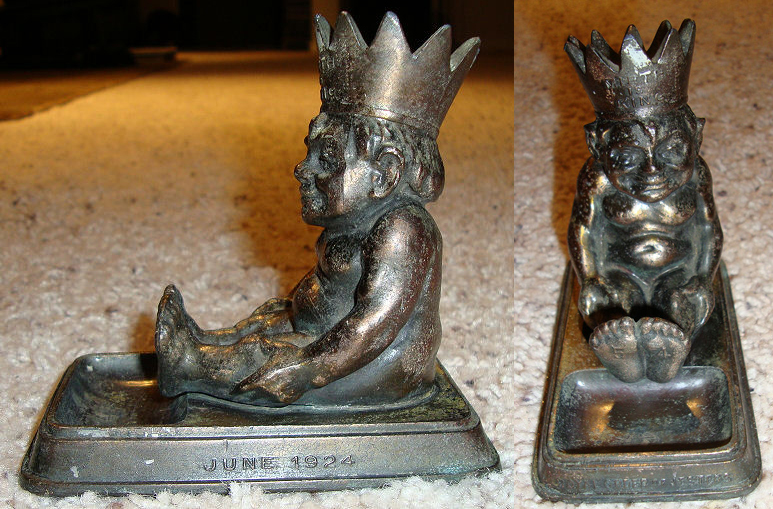 (image from phoenixmasonry.com)
(image from phoenixmasonry.com)
This lapel pin especially makes me think that the billiken on the Stratton compact was related to the Royal Order of Jesters, as the design is nearly identical.
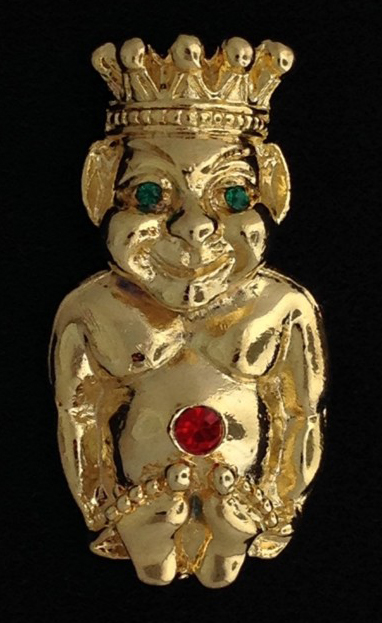
(image from fratline.net)
And Stratton did make other Freemason-themed compacts.
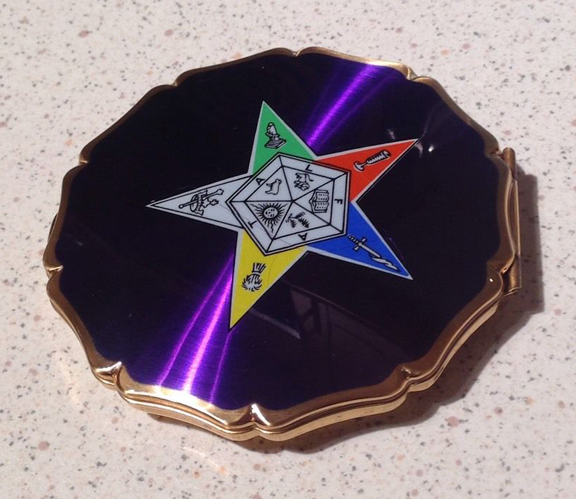 (image from etsy.com)
(image from etsy.com)
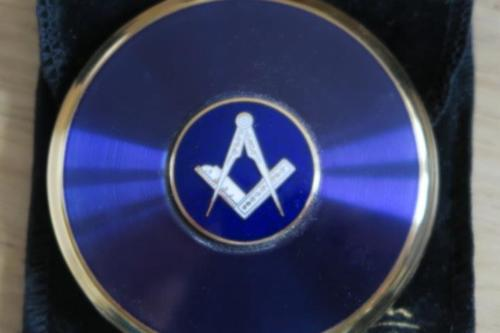
(image from ebay.co.uk)
I guess what I'm still trying to figure out is how the billiken ended up on the Stratton compacts. Were these part of a custom order for the Royal Order of Jesters? What kind of relationship, if any, did Stratton have with the Freemasons and their associated bodies? Or did Stratton simply decide to put a billiken on their compacts at several points throughout the early 20th century since the billiken was so wildly popular and appearing on nearly every object one could think of? I really can't answer any of these with any certainty. Plus, if the billiken on the Stratton compact is somehow related to the Royal Order of Jesters, it doesn't make a lot of sense to put it on an item primarily used by women. Near as I can figure, the Royal Order of Jesters is your typical boys' club (with some rather sordid, remarkably misogynist moments throughout their history to boot, though I don't know if can trust the sources I linked to.) However, according to the British Compact Collectors Society, Freemason compacts were in fact "presented as gifts on Masonic Ladies’ Nights, when wives of Masons were invited for a special dinner." So maybe the ROJ had similar ladies' nights in the U.S. and these were gifts?
I also found this compact, which just leads to more questions.
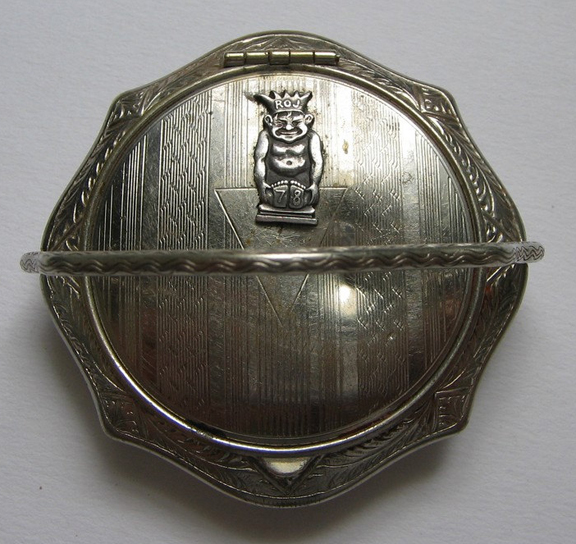
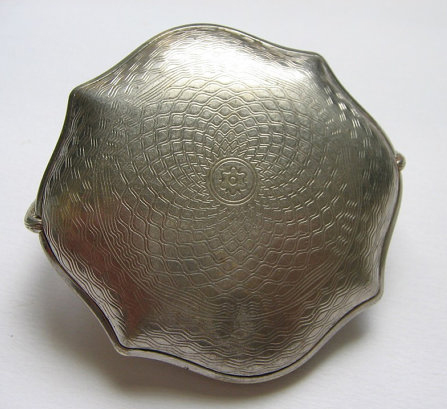
(images from etsy.com)
Unlike the Stratton billiken compacts, this one is unmistakably related to the Royal Order of Jesters given the initials on the billiken's crown. No maker is listed but the shape, embossing and the handle are all identical to these enameled compacts. So I'm wondering if this was just a generic compact and you could have it customized. In this case, I'm guessing someone belonging to the Royal Order of Jesters had it made and inscribed with the year they were inducted, given the "78" on the billiken's feet. But again, why a compact? I can only assume it was a gift, since I don't think women can be members of the ROJ.
Anyway, I don't think I'll ever get to the bottom of how a billiken that looks similar to the one used by the Royal Order of Jesters ended up on a vintage compact, but I'm glad I at least found a very interesting, if not totally weird, piece of history. And I always welcome learning about benevolent beings such as the billiken, as we could use a little more good luck and positivity in this world.
Had you ever heard of a billiken? And have you ever dreamed up a totally mythical creature? I have – a few months ago I dreamed of flying rabbits that were called angel bunnies. Their wings were not like feathered bird wings but covered in soft white fur, like the rest of their bodies. They were so cute and fluffy and they only came out at night…I wish they existed, or that I at least had some artistic skill so I could sketch them! Who knows, maybe if I file a patent for them the way Ms. Pretz did with billikens, they could be the next craze sweeping the U.S. 🙂
As I've said before, I think Valentine's Day is kinda dumb so the husband and I don't celebrate it, but I do love any sort of holiday-themed makeup. Vintage compacts are especially fun to browse for V-day, as there's no shortage of lovey-dovey designs.
If I had to guess, I think Elgin's heart-shaped compacts were originally created for Valentine's Day (and eventually marketed for Mother's Day and Christmas), since the earliest ad I've seen for them was from February 1947. I'm greatly amused by the fact that this one appeared in Esquire magazine. Clueless men, here's what to get your girl for Valentine's Day!
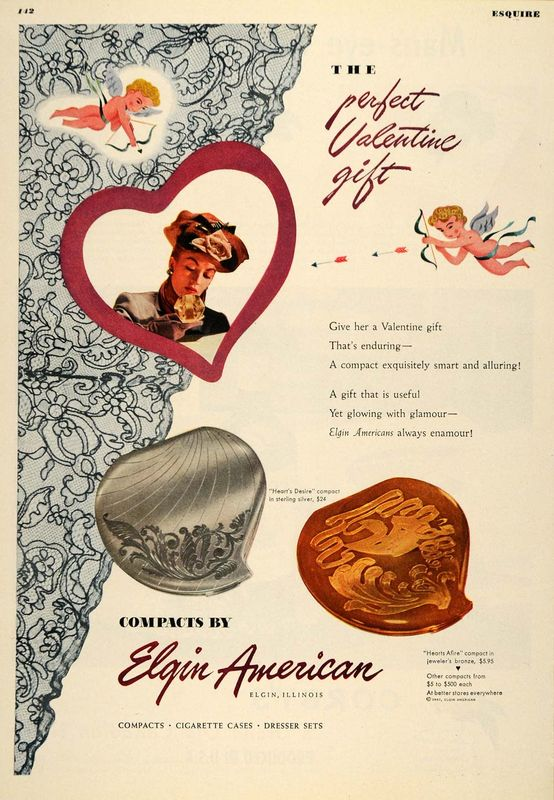 (image from elgintime.blogspot.com)
(image from elgintime.blogspot.com)
I always love it when I can find the item that I spotted in a vintage ad.
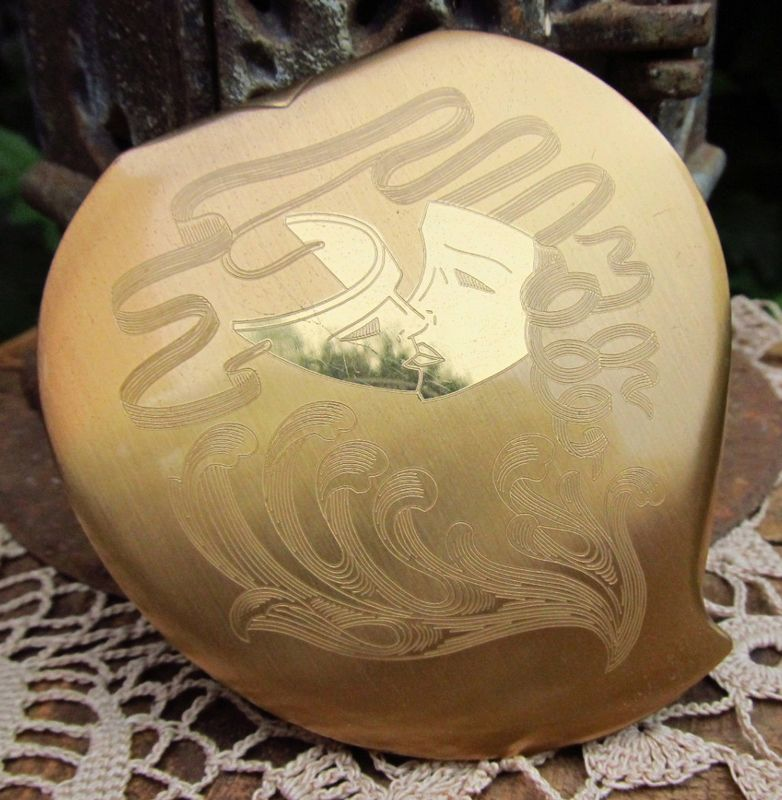 (image from etsy.com)
(image from etsy.com)
Here's another ad from February 1948. While it seems to be targeting women, it does mention the compacts as Valentine's Day gifts.
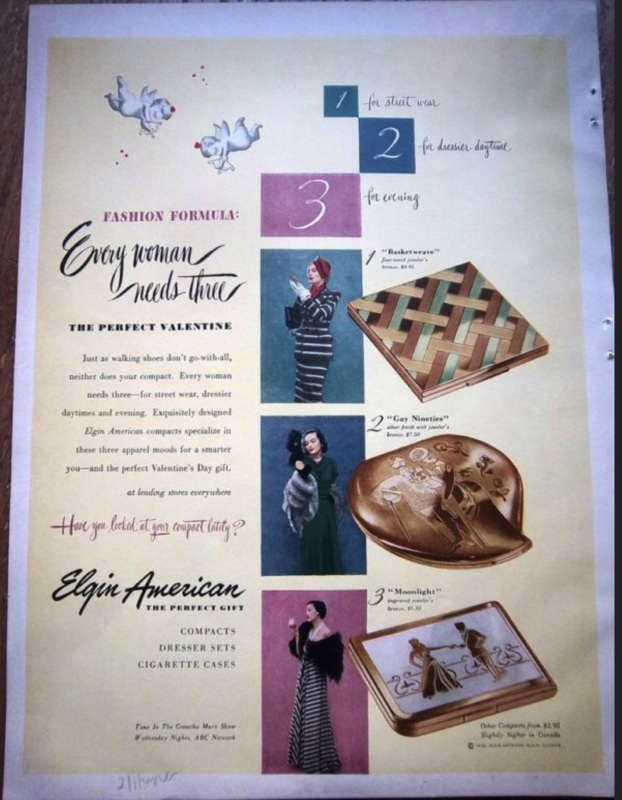 (image from pinterest.com)
(image from pinterest.com)
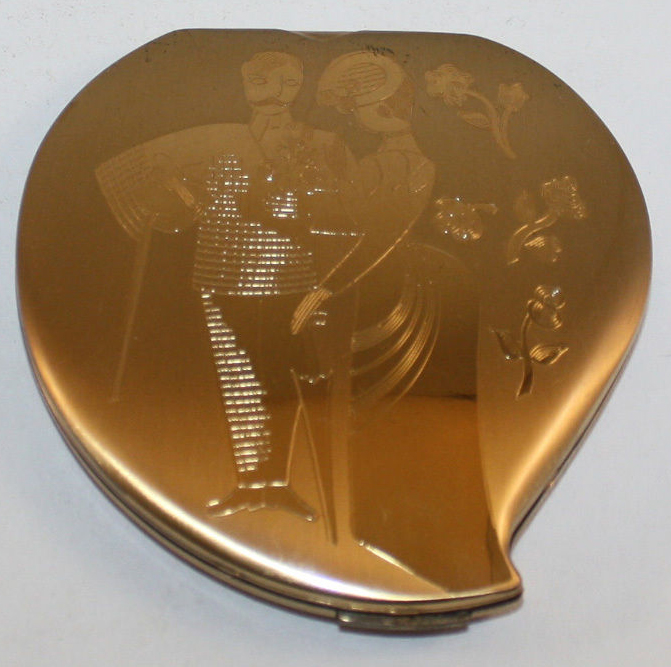
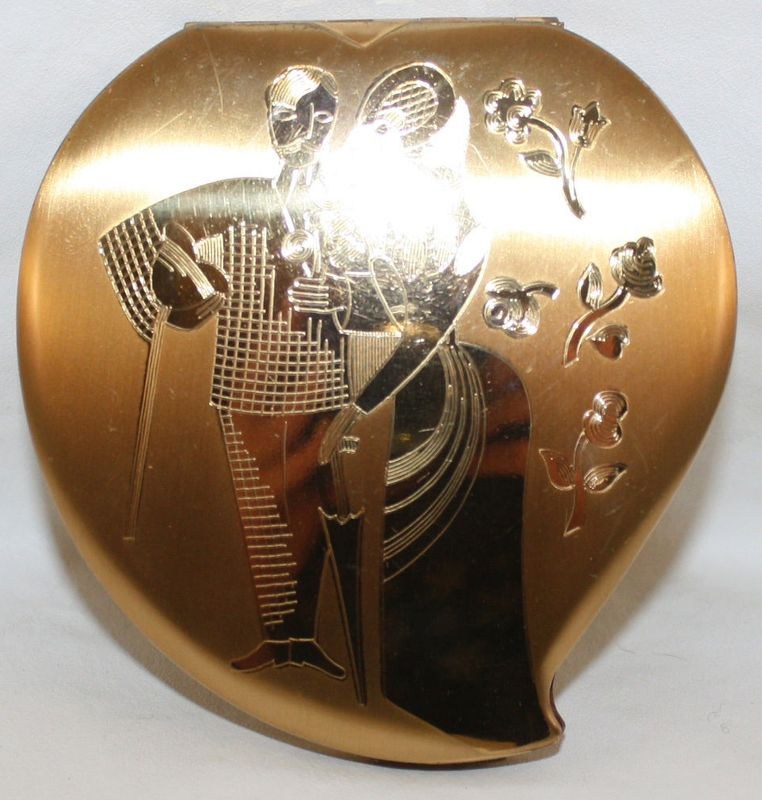 (images from ebay.com)
(images from ebay.com)
Some other Elgin compacts that would have been appropriate for Valentine's Day:
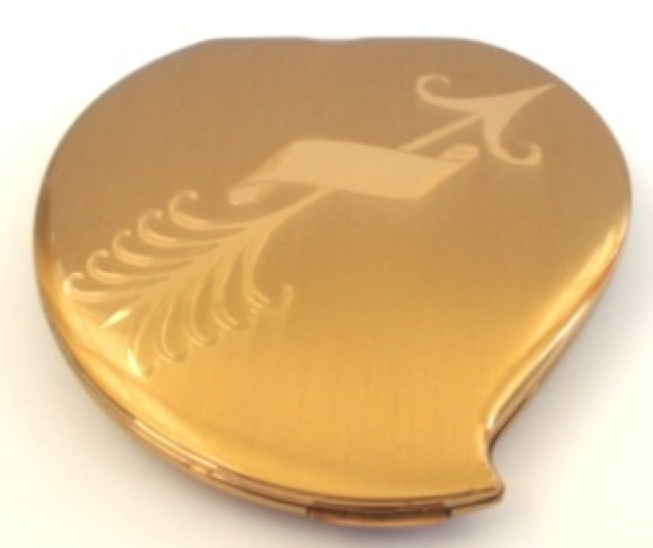 (image from rubylane.com)
(image from rubylane.com)
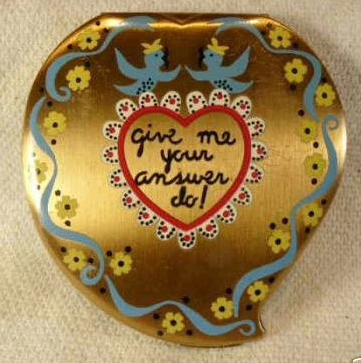
(image from worthpoint.com)
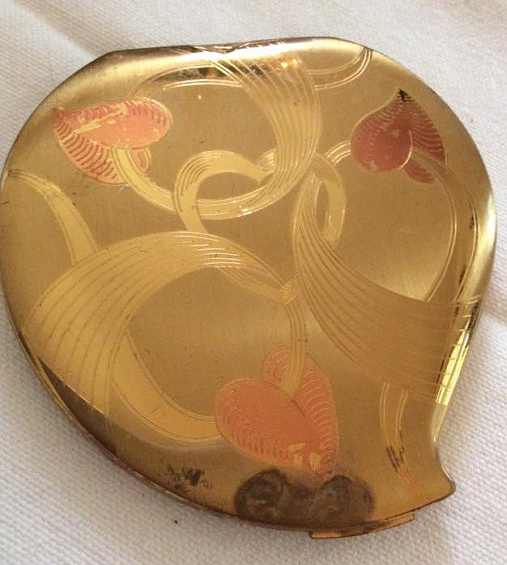 (image from etsy.com)
(image from etsy.com)
It looks like some of them had space for engraving so you could customize them.
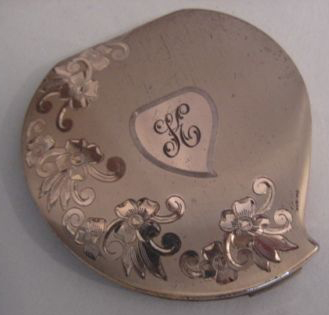
This one is my favorite. Like I said, I'm not really into Valentine's Day crap, but this is precious. It really hits all the love notes – Cupid, flying hearts, and "I love you" in several languages. At least, I think that's Cupid…he doesn't have wings, which is a little odd.
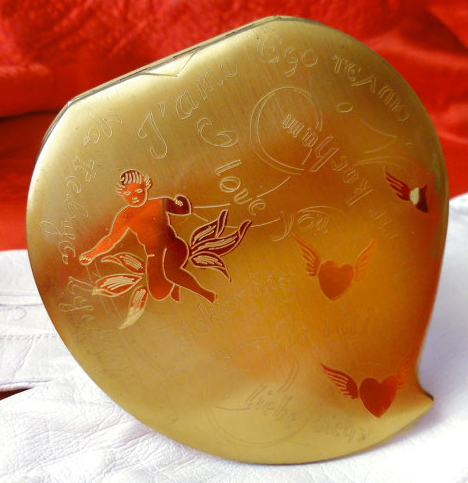
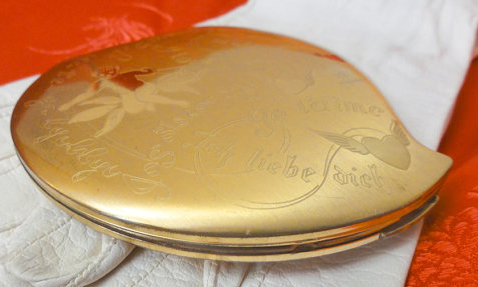
(images from etsy.com)
If I had been more organized I would have gotten one for the Museum in time for V-day. Fortunately there are lots of this particularly design floating around so I can still get it.
What do you think of these? And do you celebrate Valentine's Day? (I won't judge if you do!)
A few years back I explored makeup that visually resembled sweets. But what about makeup that actually smells like desserts and other foods? Sure, bath and body products and skincare items with foodie aromas have been popular for years, but I found it interesting that color products, i.e. items worn on the face that usually aren't scented at all or with the typical floral/herbal scents, are being made to smell like chocolate and other edible delights. So let's take a look at when this phenomenon started and where it's headed.
The earliest evidence of flavored/scented makeup that I could find is from the late '1930s. I'm not sure whether these lipsticks were eventually released for sale or even what brand they were, but here are some happy ladies testing them in the May 1939 issue of Popular Science.
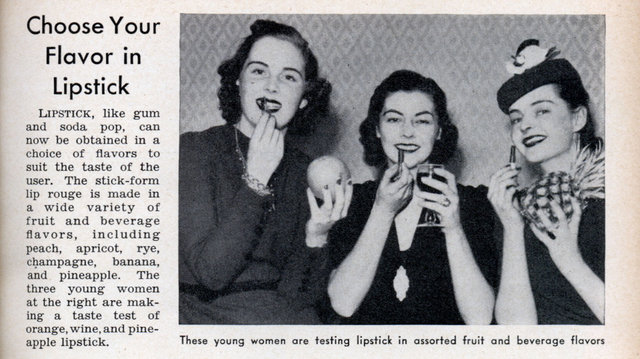 (image from blog.modernmechanix.com)
(image from blog.modernmechanix.com)
Roughly a decade later Harriet Hubbard Ayer released a clove-flavored lipstick.
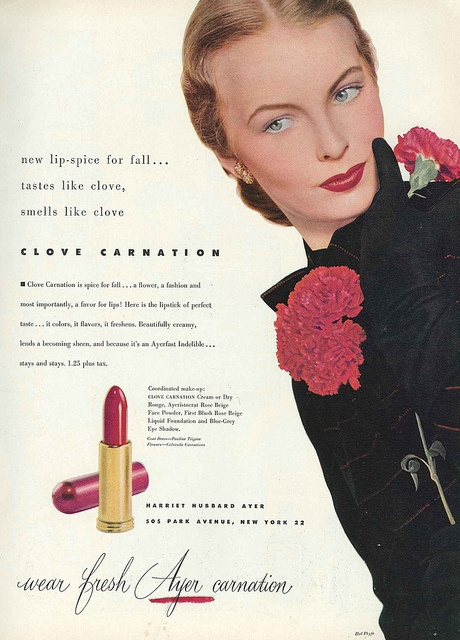
It was followed by this mint-rose scented lipstick in 1951.
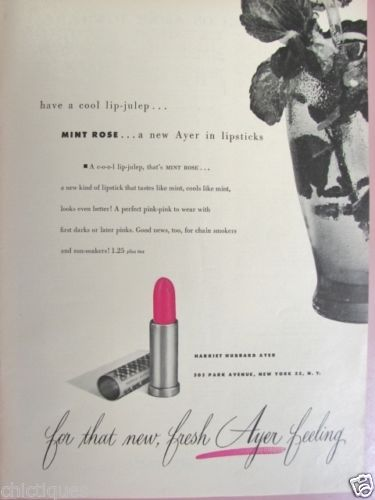
(images from ebay.com)
Slightly less sophisticated but extraordinarily popular among the teenage crowd, fruit-scented lip products really took off in the early '60s. Cutex claims to be the first company to offer fruit-flavored lipsticks in this 1964 ad. (You might remember this from my fruity ad round-up.)
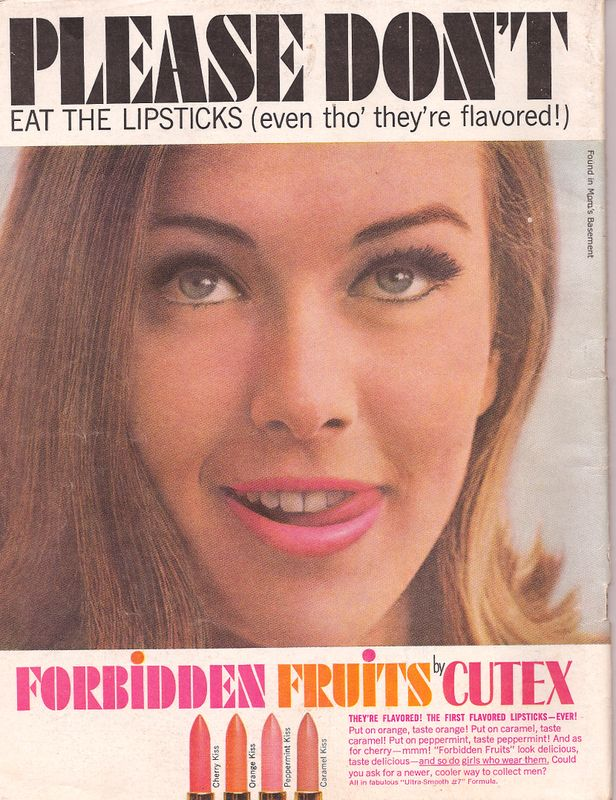 (image from buzzfeed.com)
(image from buzzfeed.com)
Soon after, in 1971, Yardley jumped on the fruit-scented lipstick bandwagon. I also remembered this one from the fruit ad post.
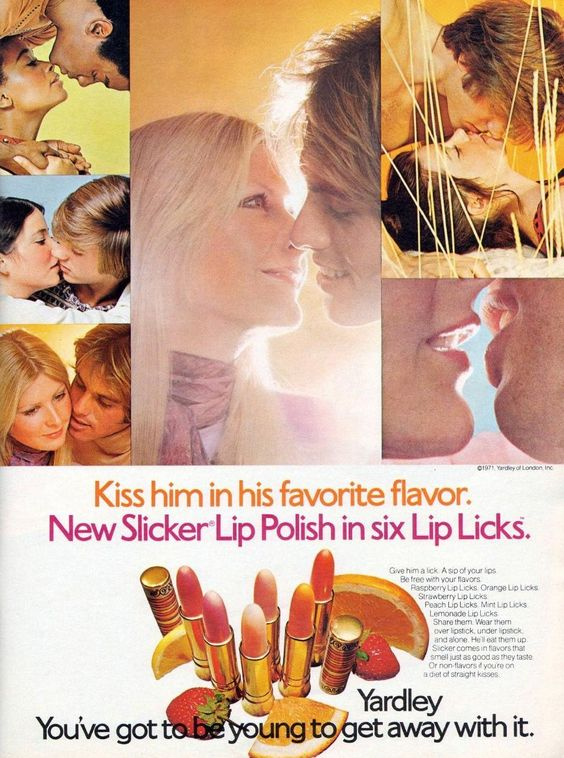
And in 1972, the company expanded the Lip Licks line to include dessert-inspired flavors (you might remember this ad from the Sweet Tooth exhibition.)
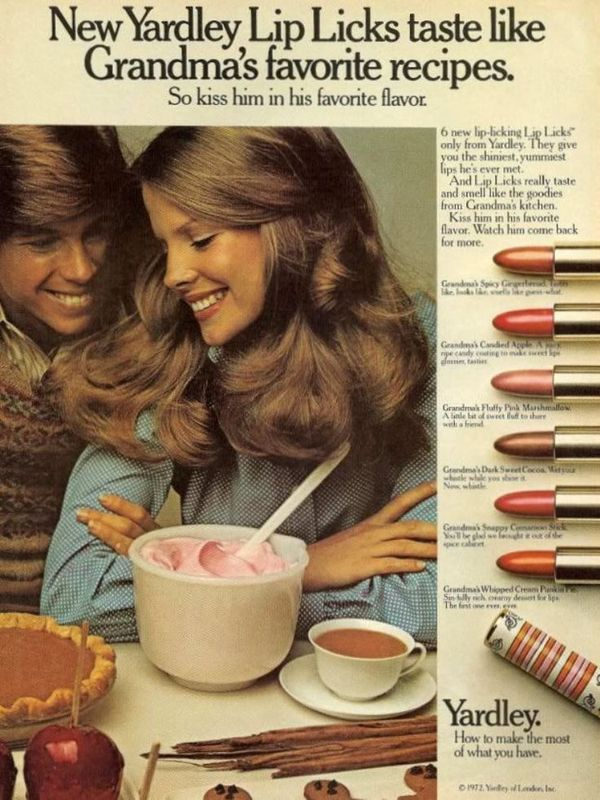 (image from flickr.com)
(image from flickr.com)
The foody-scented lip balm craze reached new heights in 1973, when a company named Bonne Bell introduced their Lip Smackers flavored balm. Starting with just 3 flavors, (strawberry, green apple and lemon), the company debuted their Dr. Pepper-scented balm in 1975, and soon Lip Smackers became a staple for tweens and teens everywhere. By 2012 the company offered 400 flavors worldwide. (Bonne Bell was purchased by Markwins in 2015, a company that still produces Lip Smackers today sans the Bonne Bell name).
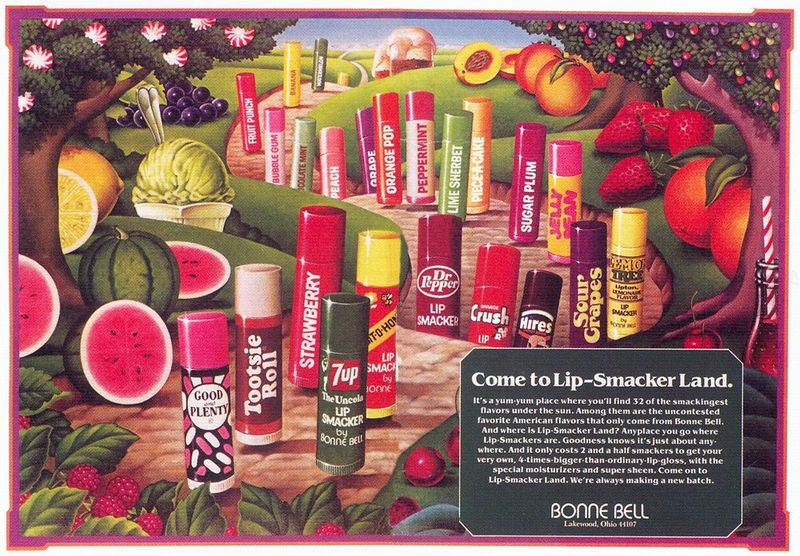 (image from oldadvertising.blogspot.com)
(image from oldadvertising.blogspot.com)
Avon wanted in on the action, as evidenced by these dessert-flavored balms that were released throughout the '70s and '80s. (I'm not sure exactly who these were being marketed to – I imagine it was mostly kids, but maybe some teenagers and adults bought them too.)
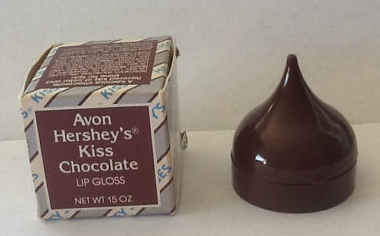
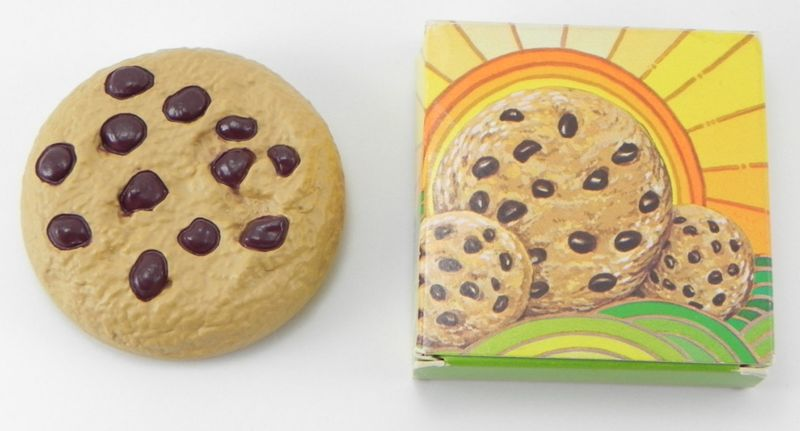
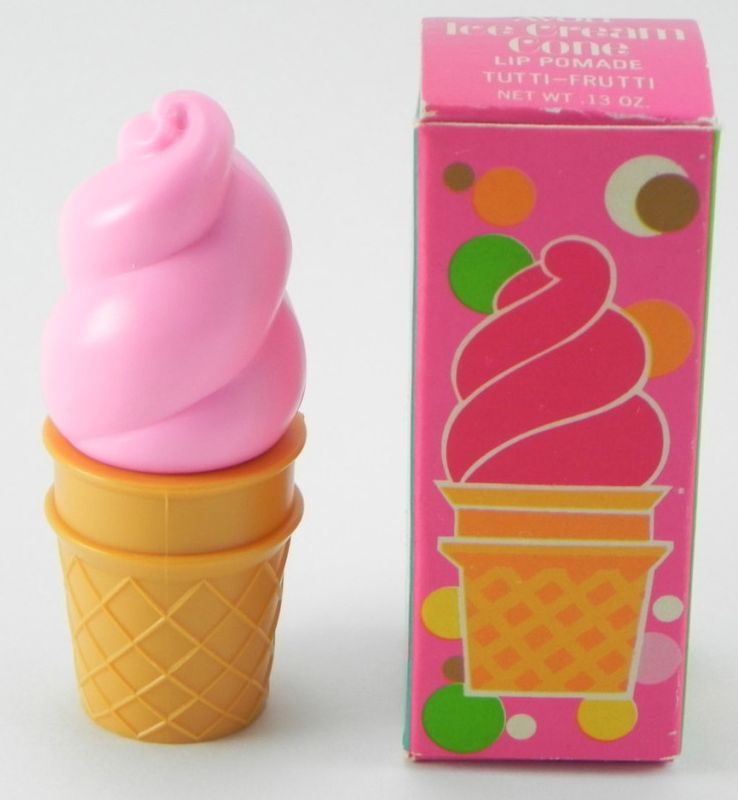
(images from etsy.com)
Thanks in large part to the enormously popular Lip Smackers line, other companies proceeded to try to get a piece of the teenage demographic by cranking out flavored lip products through the '80s.
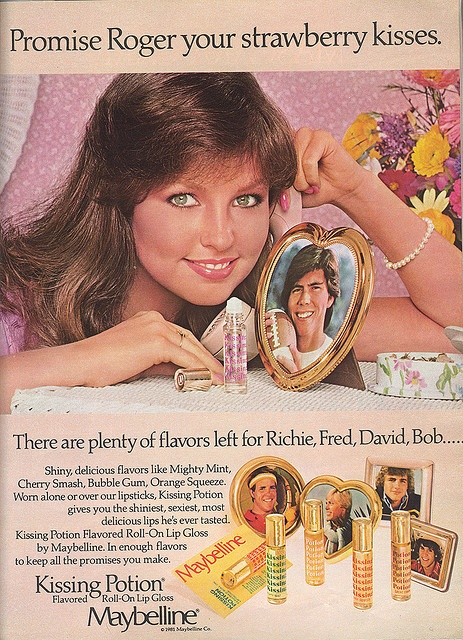
(image from liketotally80s.com)
By the early aughts, products like Philosophy's Lip Shines and On 10's vintage-inspired lip balm tins came in more upscale, less teenybopper-esque packaging and at a higher price point to appeal to a more grown-up crowd, but retained a few of the same scents as the inexpensive likes of Bonne Bell. In 2004 Tinte Cosmetics revived popular flavored balms that were known as "Lip Lickers" and produced by a Minnesota-based company from 1977 through 2002. In an effort to appeal to older women's nostalgic side, Tinte retained both the original sliding tin packaging and graphics. The food-scented balm market started to achieve full saturation around this time, especially when a company named Lotta Luv began partnering with big food and beverage companies like Hershey's, Pepsi, and Dairy Queen, along with a variety of other well-known snack, candy, cereal, and chewing gum brands. Novelty companies offering their own crazy food flavored balms soon sprung up afterwards. By 2012 one could find balms flavored in foods ranging from Cheetos and beer to pickles and corn dogs.
My hypothesis is that since foodie lip balms had officially jumped the shark with all these wacky flavors, coupled with the fact that makeup companies were only including lip balms among their scented cosmetic offerings, makeup brands had to get more creative when it came to adding fragrance to their products. No longer were clear lip balms enough – it was time to branch out into face and eye products, along with lip products that actually contained color. Chocolate and other desserts were still the reining favorites. But items like Stila Lip Glazes and Becca Beach Tints, both of which offered a variety of fruity scents, as well as Benefit's peach-scented Georgia blush, also proved popular. Some items unintentionally offered a subtle food aroma as a natural byproduct of the ingredients used, such as Bourjois's and Too-Faced's cocoa-powder based bronzers and 100% Pure's fruit-pigmented makeup line.

- Bourjois Bronzing Powder, 2006
- Benefit Georgia blush, 2004*
- MAC Lip Glass Tastis, 2004*
- 100% Pure Fruit-Pigmented Mascara, ca. 2007
- Urban Decay XXX Slick in Cocoa, 2004*
- Becca Beach Tint, ca. 2006
- Benefit SugarBomb blush, 2009
- Stila Lip Glaze, ca. 1999
- Jane Iredale Chocoholicks lip palette, ca. 2009
- Too-Faced Soleil Matte Bronzer, 2009
By 2012, foodie-smelling products were becoming less novel and more expected, but this familiarity among consumers didn't seem to diminish their popularity; even chocolate-scented makeup bags made an appearance. Additionally, as Asian brands became more visible and available to the Western world, sales of their chocolate-scented products took off as well.
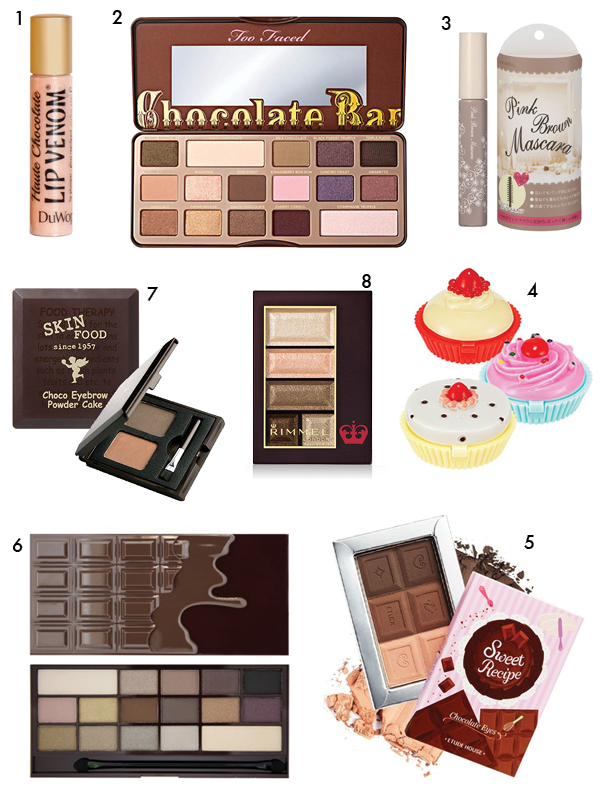
- DuWop Haute Chocolate Lip Venom, 2014
- Too-Faced Chocolate Bar palette, spring 2014
- Love Switch Pink Brown mascara, 2012
- Holika Holika Dessert Time Lip Balms, 2012
- Etude House Chocolate Eyes, spring 2013 (it should look familiar, as it was a key exhibition piece)
- Makeup Revolution Death by Chocolate palette, 2014
- Skin Food Choco Eyebrow Powder Cake, 2013
- Rimmel Chocolate Sweet Eyes, 2014
Face products weren't the only ones getting the food scent treatment, however. While scented nail polishes were previously the sole domain of children, nail companies soon seized on the demand among adults for these products. From Color Club's Pumpkin Spice Latte scented polish to Butter London's berry-scented polish remover, fingernails were now able to join in on the foodie fun. Whether it was partially Dior's rose-scented polishes from their spring 2012 collection or the influence of Rosalyn Rosenfeld's (played by Jennifer Lawrence) vivid description of a nail polish top coat's odor in the 2013 film American Hustle, scented nail products rose to prominence in the past 5 years. And the most popular ones smell not "like flowers, but with garbage"; rather, foodie polishes prove to be the best sellers.
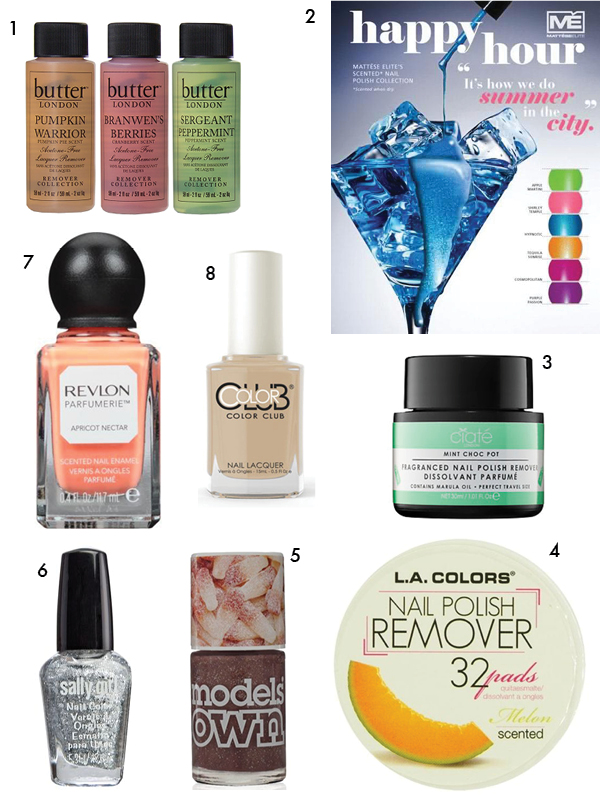
- Butter London polish remover trio, 2012 (I REALLY miss those Butter London polish removers – they were the best!! They smelled great and worked even better. They had another limited edition set that contained a pina colada-scented remover called Beach Bum, which I loved.)
- Ad for Mattese Happy Hour cocktail-scented polishes – if you can't make it out, the scents were Apple Martini, Shirley Temple, Hypnotic, Tequila Sunrise, Cosmopolitan, and Purple Passion.
- Ciaté Mint Choc Pot, 2015 (I think the Choc Pots are the reincarnation of Ciaté's previous foray into scented polish removers, which sucked – I wonder if the Choc Pots are any better).
- L.A. Colors Melon nail polish remover pads, ca. 2011
- Model's Own Sweet Shop Fizzy Cola Bottles, 2014 (the Sweet Shop collection is a follow up to Model's Own popular Fruit Pastel collection released the previous year)
- Sally Girl Vanilla scented polish, holiday 2014
- Revlon Parfumerie scented polish, 2013
- Color Club Pumpkin Spice Latte polish, ca. 2011 (this company has also released holiday-themed scented polishes)
Companies continue the foodie fad today. Too-Faced is leading the way with a whopping 5 new food-scented products in their spring/summer 2016 lineup. Japanese brands Lunasol and RMK both offered sweet-scented items in 2015, while Etude House built on their previous dessert-y releases with their Give Me Chocolate spring 2015 collection, a gingerbread cookie scented bronzer in their holiday 2015 collection, and strawberry-scented cream blushes and nail polishes for their spring 2016 collection. Finally, this spring Physician's Formula gets tropical with a coconut-scented bronzer.
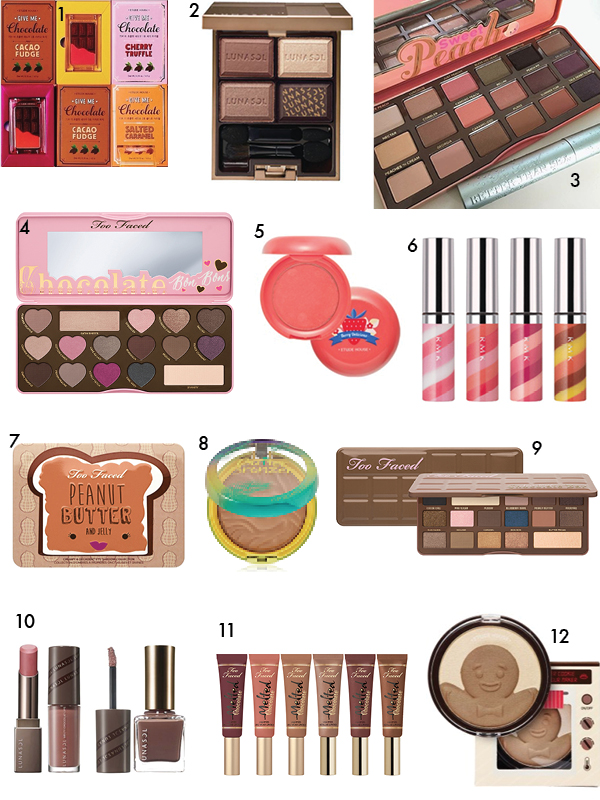
- Etude House Give Me Chocolate collection, spring 2015
- Lunasol Selection de Chocolat eyes, fall 2015
- Too-Faced Peach palette, spring/summer 2016
- Too-Faced Chocolate Bon Bons palette, winter/spring 2016
- Etude House Berry Delicious Cream Blush, spring 2016
- RMK Vintage Sweets collection lip glosses (flavors included Maple Syrup and Butterscotch), spring 2015
- Too-Faced Peanut Butter and Jelly palette, spring 2016
- Physician's Formula Butter Bronzer, spring 2016
- Too-Faced Semi-Sweet Chocolate Bar palette, spring 2015
- Lunasol Melty Chocolat lip glosses, fall 2015
- Too-Faced Melted Chocolate liquid lipsticks, spring 2016
- Etude House Gingerbread Cookie Contour Maker, holiday 2015
So, my questions are why companies are continuing to produce food-scented makeup, why we're buying it, and the significance of these items. There's the obvious need among makeup brands to offer novel products, plus the desire to capitalize on the success of foodie bath and body lines. Food-scented makeup is a natural expansion of the dessert-scented beauty product craze. There's also the tactic of engaging the sense of smell as well as sight (shiny makeup in pretty colors) and touch (texture is key when creating an attractive makeup product – people love dipping their fingers in testers). Appealing to 3 senses instead of two might make consumers more likely to buy the product. Why simply wear a buttery-soft, chocolate-colored eye shadow when your lids could also smell like it?
More generally, I suppose the same basic reasoning behind the allure of dessert-smelling bath and body items applies to cosmetics. I touched briefly on why women may want to smell like chocolate, cake or other food previously in this post and in the Sweet Tooth exhibition, and there have been plenty of news articles, but the most articulate and comprehensive exploration of the topic comes from Autumn of The Beheld. Her points regarding dessert-inspired beauty products, such as the negative implications of marketing of sweet-smelling products to grown women and the remarkable appeal they continue to maintain, carry over to food-scented makeup. She writes, "Foodie beauty products are designed to serve as a panacea for women today: Yes’m, in the world we’ve created you have fewer management opportunities, the state can hold court in your uterus, there’s no law granting paid maternal leave in the most powerful nation on the planet, and you’re eight times more likely to be killed by your spouse than you would be if you were a man, but don’t worry, ladies, there’s chocolate body wash!…[foodie products] do smell good, after all; that’s the whole point. And they trigger something that on its face seems harmless: Part of their appeal lies in how they transport us back to an age when all we needed to be soothed was a cupcake. At the same time, they don’t actually transport us to being that age; they transport us to a simulacrum of it." Indeed, nostalgia can be a tricky thing to navigate in this context. As with kids-themed cosmetics from brands that primarily sell to adult women, the notion of foodie makeup could be seen as an infantilizing pacifier meant to placate and distract women from serious societal issues.
Another aspect to consider is the advertising for these products. Today's foodie makeup isn't advertised the same way as their predecessors, who suggest these products are a good way to snag a guy. "Could you ask for a newer, cooler way to collect men?" asks the Cutex ad. "Kiss him in his favorite flavor," says Yardley. (Side note: the notion of making a guy think of his grandmother while kissing is really bizarre to me, and I'm not the only one.) "Promise Roger your strawberry kisses," implores Maybelline. Heck, the product is even named Kissing Potion!
While the insinuation of catching a man isn't present in the vast majority of contemporary makeup ads, the idea is still vaguely floating around when it comes to food-scented items. A reviewer for Too-Faced Chocolate Soleil bronzer titles her review, "Even my boyfriend loves the smell." And the model for Switch's Pink Brown mascara remarks, "You can feel the chocolate scent from my lushes! [sic] And I love it when the scent flows as your face getting close to your boyfriend, like when kissing." (The translation wasn't great but you get the gist.) The notion of luring a guy with a scrumptious dessert scent certainly isn't unique to makeup, but it's slightly different. Unlike bath and body products or perfumes, one has to be up close to get a whiff of a flavored balm or cocoa bronzer.
But this fact is also why one could argue that people who wear these items are only doing it for themselves, and that we may be reading too much into these: perhaps they really are just food-scented makeup and nothing more. Like Autumn, ultimately I don't see anything wrong with enjoying makeup that smells like fruit or chocolate or any other food. She notes, "[Sometimes] a candy cigar is just a candy cigar…I don’t want to imply that any of us should stop using lemon cookie body souffle or toss out our Lip Smackers—joy can be hard enough to come by plenty of days, and if it comes in a yummy-smelling jar, well, that’s reliable enough for me not to turn my nose up at, eh?" Speaking from personal experience, I loved Benefit's Georgia – something about having my cheeks smell faintly like peach was incredibly fun – but I can tell you I didn't consider, not for a second, my then boyfriend's (now husband) reaction to how my face smelled. At the moment I'm tempted by Too-Faced's Peanut Butter and Jelly palette because not only is the smiley pb & j face ridiculously cute, the palette is scented with peanuts. That is a fragrance I haven't seen in eye shadow before; the sheer novelty of it brings a smile to my face. I'm not even a palette person, but the idea of inhaling a light peanut aroma while applying eye shadow is the aspect that makes me want to buy it. I imagine that for most women, it's not about getting close to a significant other, it's about the multi-sensory pleasure you experience when applying these products. I'd say that given how subtle and ephemeral the scents in foodie makeup are, they're actually intended to be enjoyed at a personal, individual level rather than something to be shared. As one reviewer for Revlon's Parfumerie nail polish notes, "It's funny because you forget about it, and then I guess I don't realize how many times a day I touch my face, because I keep getting a whiff of it, and each time I'm totally surprised!” Overall, no matter what makeup companies have in mind when creating these products, I think it's okay to perceive them simply as brief, fleeting pick-me-ups rather than as ways to entrapping a man or treating grown woman like children. Of course it's a subject worth questioning and we must continue to be mindful of how makeup is marketed, but no one should feel bad for liking chocolate-scented mascara or nail polish that smells like cookies.
What do you think? Are you down with food-scented makeup? This very unscientific 2008 poll says that people are fairly evenly divided on the subject, so I'm curious to hear your thoughts.
*Limited edition/discontinued
I've always been fascinated with the zodiac, so I'm drawn to any products that feature the 12 signs. And obviously since I love makeup I have a special affinity for compacts with zodiac imagery. There's also something deeper going on – perhaps because of my ever-present need to create order out of the cluttered chaos that is my brain, I like anything calendar-related, whether it's the 12 months of the year or the 12 zodiac signs. Twelve is such a nice neat number, and each month or zodiac sign signifies a particular time of year, making it easy to recognize its passage. And January seems like a good a time to talk about the 12 months/zodiac signs as they all start in January. But enough of my ramblings and onto a very cool find. I stumbled across this while looking for vintage compacts for my own personal use (more on that next week).
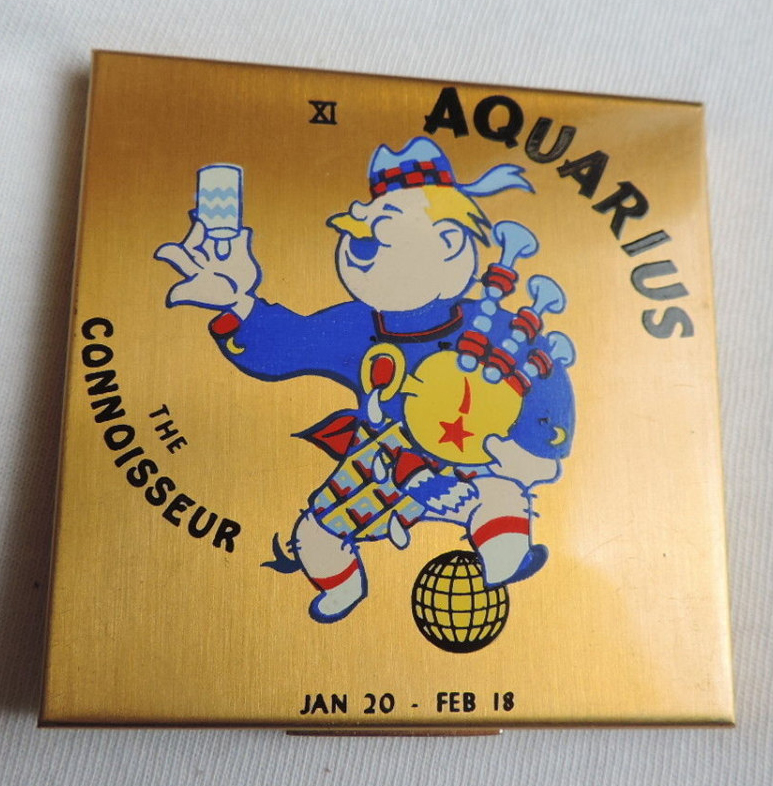
I liked the strange cartoon character representing the Aquarius sign and thought the little rhyme on the back of the compact was genius. I also appreciated both the traditional zodiac symbol above the rhyme and the corresponding element (water, earth, wind, fire) beneath – such great details. But what really caught my eye was the artist's signature on the lower right. I definitely wanted to see more work by this S. MacNiel, and I also wanted to find out how he ended up doing these illustrations for Elgin.
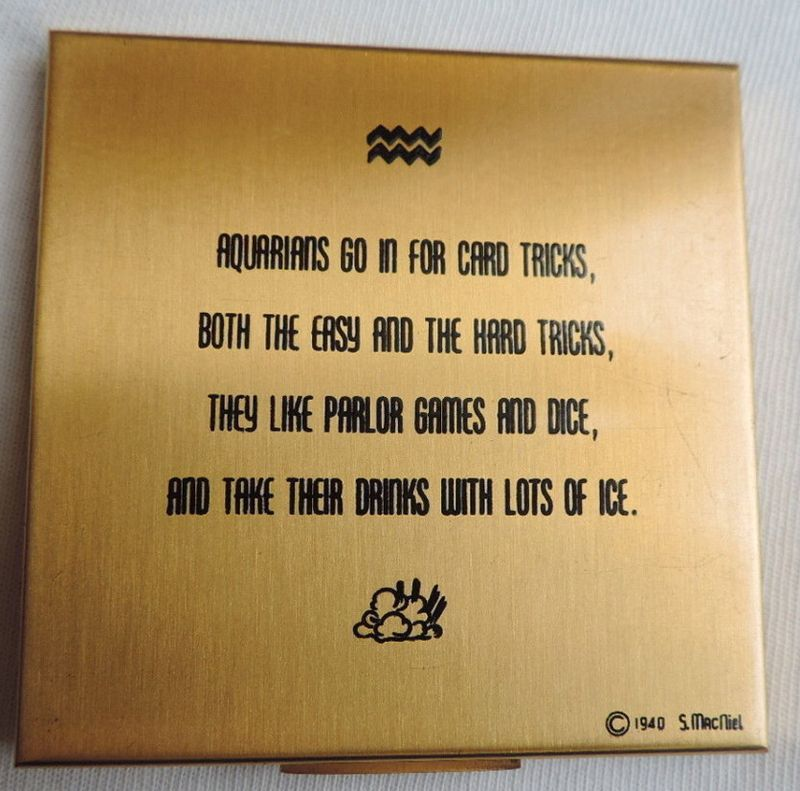 (images from etsy.com)
(images from etsy.com)
I set about finding as many images of these compacts as I could. Here's Aries:
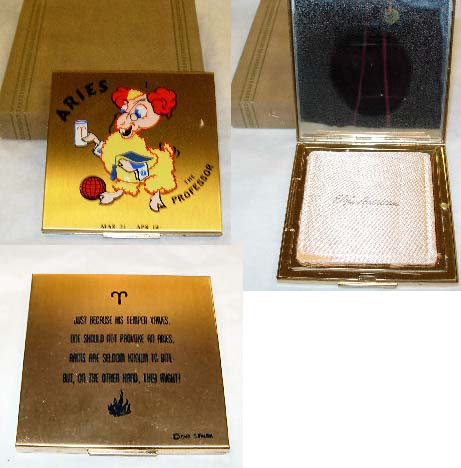
(image from onegiantyardsale.com)
Taurus:
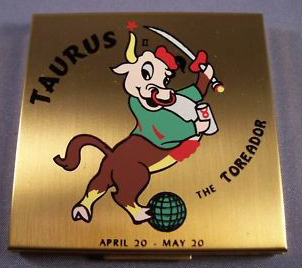
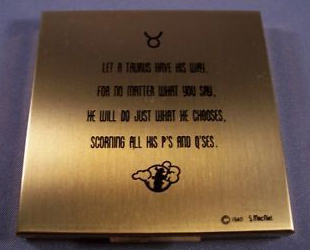
(images from worthpoint.com)
Gemini:
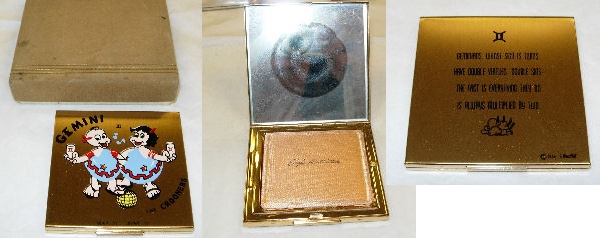 (image from onegiantyardsale.com)
(image from onegiantyardsale.com)
Cancer:

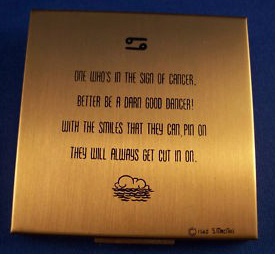
(image from worthpoint.com)
Leo:
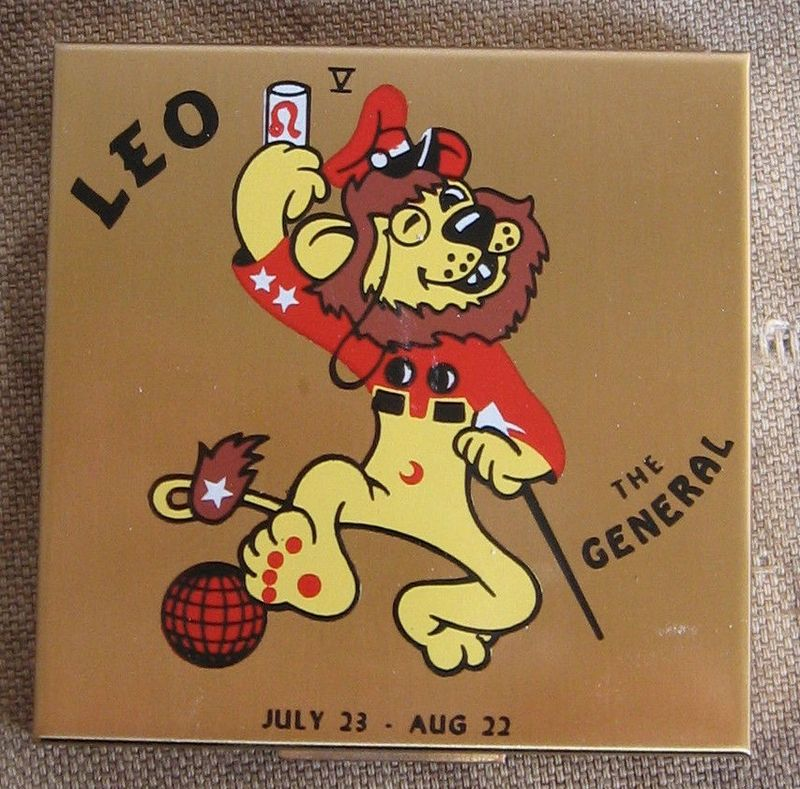
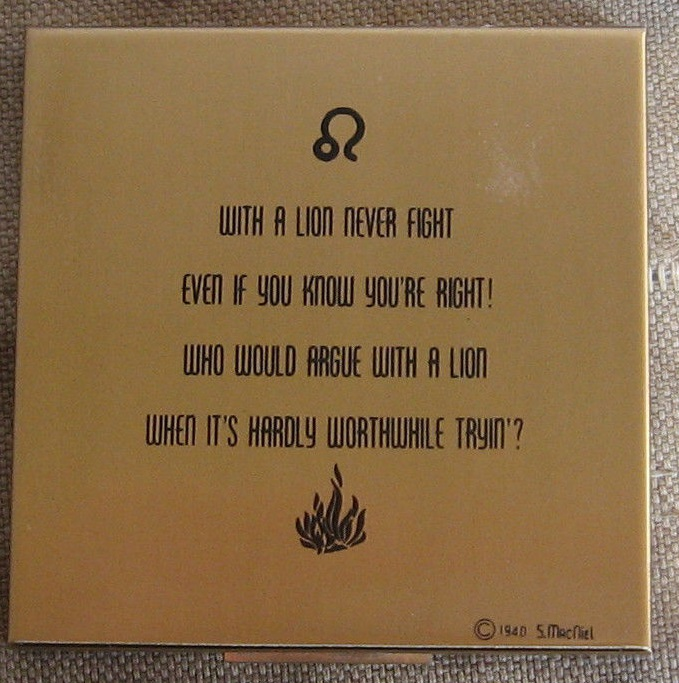 (images from ebay.com)
(images from ebay.com)
Virgo:
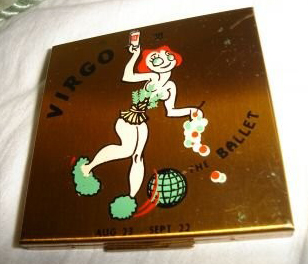
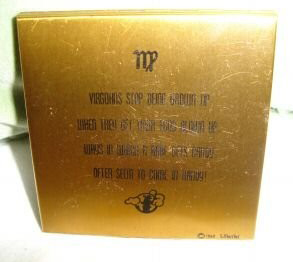
(images from worthpoint.com)
Libra – no pictures of the back, but the seller included the rhyme: "Libra people love nice things/Lollypops and diamonds rings/ They're happiest when they have bought/A lot of stuff they hadn't ought."
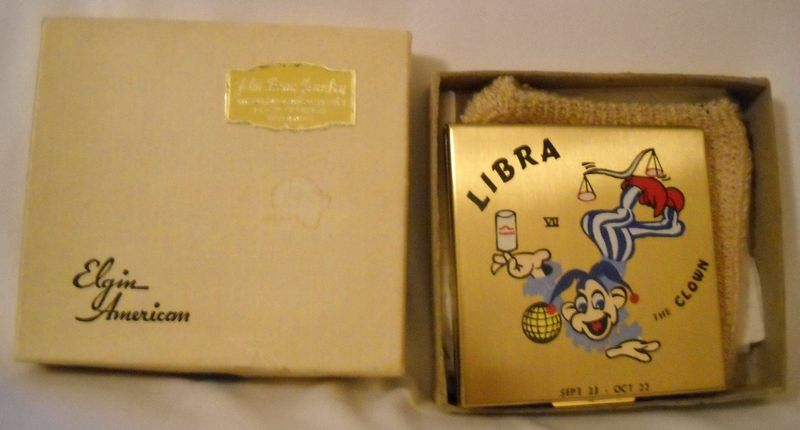 (image from ebay.co.uk)
(image from ebay.co.uk)
I couldn't find a photo of the actual compact, but here's an ad from a Pittsburgh newspaper from May 7, 1948 for Scorpio – based on the ad copy, they were playing these up as a Mother's Day gift. What I was confused about is why these were advertised in 1948 and the date near MacNiel's signature on the compact is 1940.
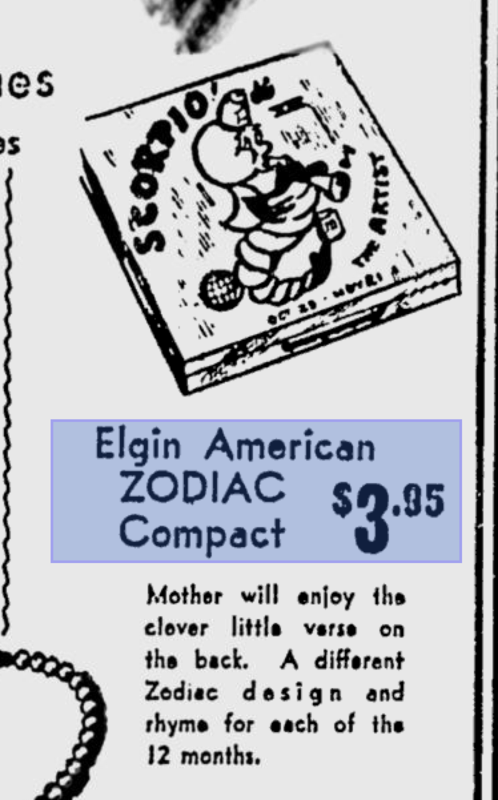
(image from news.google.com)
I was determined to reconcile the dates, so I went digging in search of information on man of mystery S. MacNiel. I found out the S. stands for Stanley, and MacNiel was a Scotsman who traveled the world but ended up in New York City. In 1940 he published a book of cocktail recipes based on zodiac signs. This wood-bound book fetches hundreds of dollars at various auction sites. The cover image is bizarre, but I have to admit quite creative. Grapes for hair, orange slices for ears, lemons for eyes, cherry nostrils, and I particularly love the way the cocktail glass becomes her mouth.
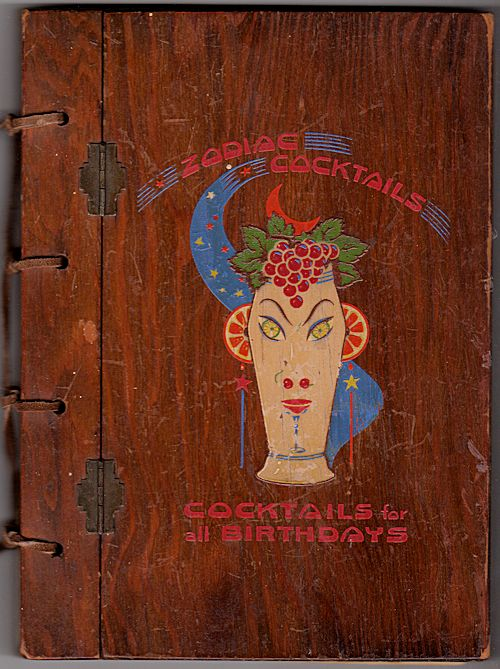
I can't believe he mentions Mussolini as a Leo of note. Uhh…
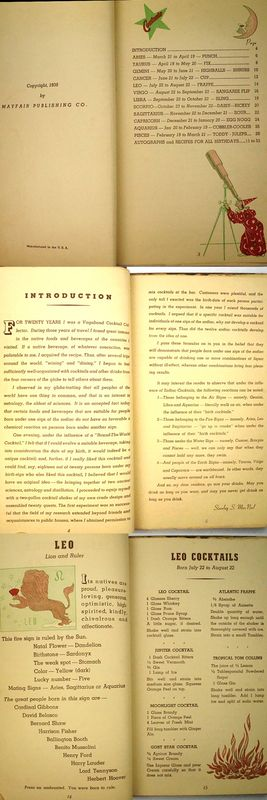
(images from read-em-again.com)
The book might not have been strange at all if our buddy Stan was a known author and artist, but he didn't seem to have a defined career. He was described as a "lecturer and leader of the Ambassadors of Good Cheer," whatever that is. (I googled and didn't find much – may have been something alcohol-related.) The book's introduction doesn't give much of an idea of what he actually did for a living either. MacNiel says, "For twenty years I was a Vagabond Cocktail Collector. During those years of travel I found great interest in the native foods and beverages of the countries I visited. If a native beverage, of whatever concoction, was palatable to me, I acquired the recipe. Thus, after several trips around the world, 'wining', and 'dining', I began to feel sufficiently well-acquainted with cocktails and other drinks from the four corners of the globe to tell others about them." So he's very well-traveled, but what did he actually do? How did he get into illustration and design? I do like the title of "vagabond cocktail collector" though. That must have been a pretty sweet gig.
Anyway, equally peculiar was MacNiel's creation of a very ornate jeweled brooch in the shape of the head of the "fruit lady" that appears on his cocktail book's cover. I don't know why the patent spells his name incorrectly. I also have no idea why he made this piece of jewelry.
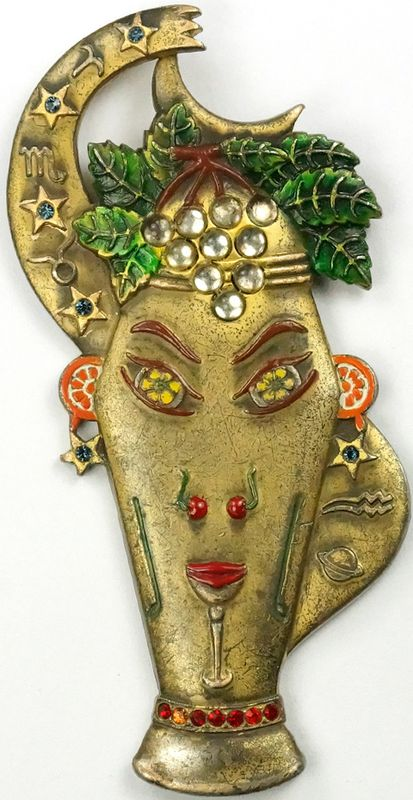
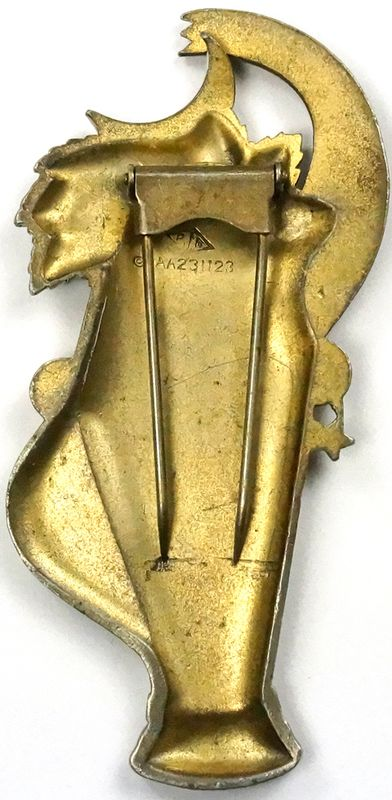
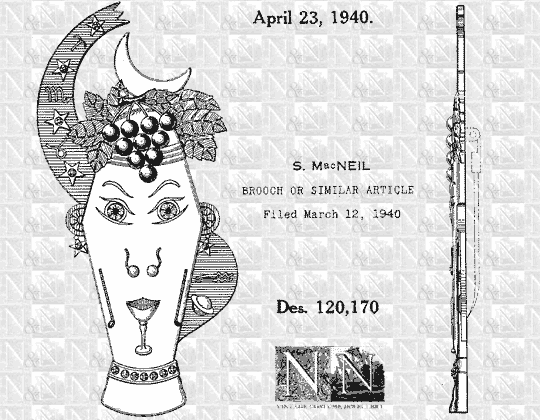 (images from trifari.com)
(images from trifari.com)
The brooch (a.k.a. a "fur clip" – fancy!) was apparently sold at Saks in New York and, like MacNiel's book, sells for hundreds of dollars.
So that's interesting, but what does all this have to do with the compacts? And what about the fact that the book was released in 1940 and the compacts seemingly weren't released until 1948? Well, here's the connection: the same rhymes that appear on the back of the compacts are in the book under each sign. The illustrations are different but the rhymes are the same. Compare the rhyme at the bottom of this page with the Virgo compact above.
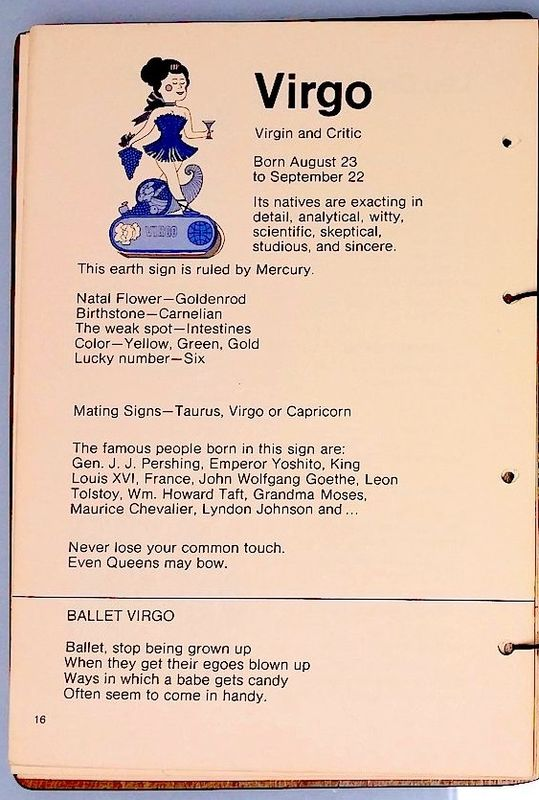
(image from winkbooks.net)
So my best guess is that he patented everything in 1940 (see his copyright for "Zodiac Humor" that year) and in 1948 allowed use of his illustrations and rhymes for the compacts, so they weren't created specifically for Elgin. Also, he lent his work not only to Elgin, but to several other endeavors as well: tiles (that could be used as trivets or wall decorations), cocktail glasses and napkins. This article in a Brooklyn newspaper from April 15, 1948 sheds a little light on the various zodiac collections, but still doesn't explain what Mr. MacNiel did for a living other than he was a "man of varied careers". It does mention that he once hiked across the entire U.S. in 90 days and took credit for introducing mens' shorts as casual wear in the States. Near as I can figure, given these facts and his seemingly endless globe-trotting, he was simply a nomadic (possibly often drunk) jack of all trades who wasn't content doing one thing or being in one place very long. (Why is his name is spelled wrong again?)
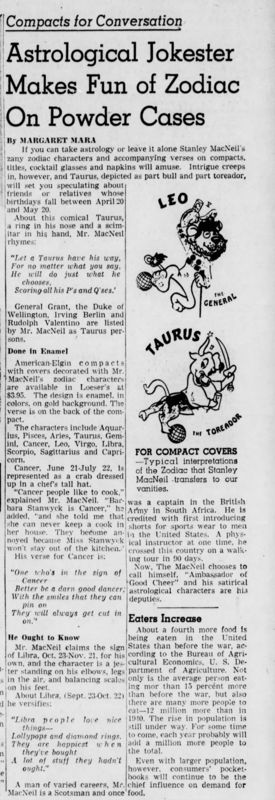
(image from newspapers.com)
Additionally, it looks like in 1953 MacNiel licensed his images to be used for a set of mugs produced by a ceramics company called Rossini Japan.
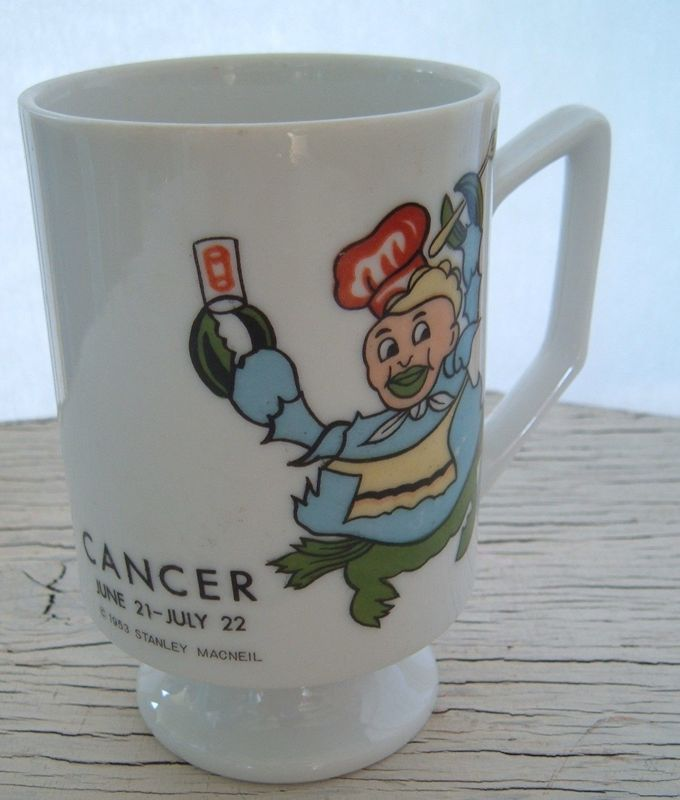 (image from ebay.com)
(image from ebay.com)
I also searched for some tiles in hopes of unearthing more images that would have appeared on the compacts, and I found some I couldn't find in compact form: Sagittarius, Scorpio and Pisces.
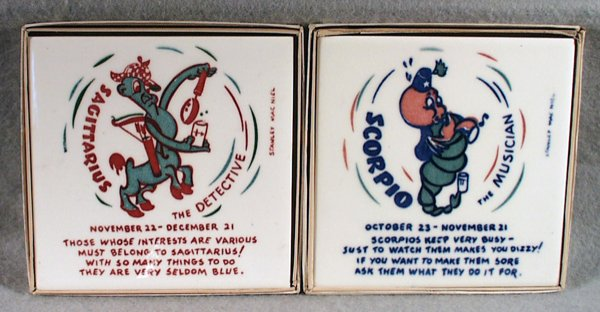 (image from liveauctioneers.com)
(image from liveauctioneers.com)
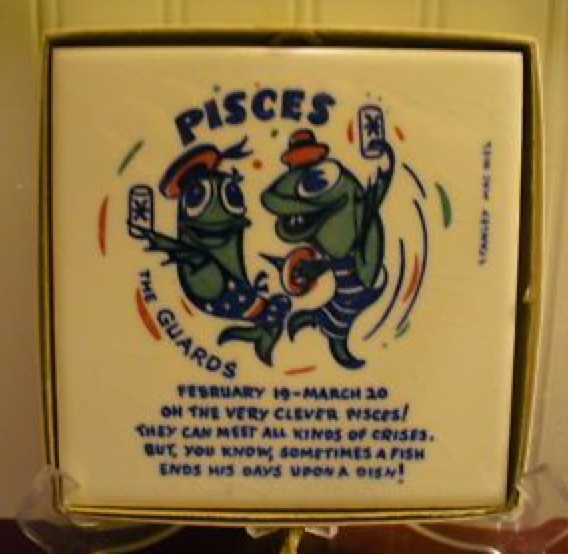 (image from pinterest.com)
(image from pinterest.com)
For the life of me though, sadly I couldn't find any images of Capricorn. I guess 11 out of 12 isn't bad, but that's going to drive me crazy. Hopefully one will surface eventually.
While I've figured out the release date of the compacts and a little more about the person behind the illustrations, I'm still not sure how the collaboration came about, i.e. whether MacNiel approached Elgin or the other way around. I also wonder whether he was an Aquarius, since the character for that sign seems to be Scottish (given the kilt and bagpipes) and is labeled as the "Connoisseur" while examining a drink in his hand. We know MacNiel was Scottish and considered himself a cocktail expert, since he mentions mixing "thousands" of drinks as research for his book, so perhaps the Aquarius fellow is meant to be a self-caricature. Unfortunately I can't find a date of birth anywhere for him. But overall, I was pleased with my detective work and I love these compacts, silly and cartoonish though they are. And MacNiel sounds like a hoot – I would have loved to have a drink with him.
What do you think of these? My collector's itch is definitely acting up and wants me to start hunting down all of them…if I ever come across a Scorpio one I'm going to pounce for sure!
The Makeup Museum’s collection contains over 2,500 objects from the late 19th century through the present year, and eventually will incorporate artifacts dating prior to the 1800s. From renowned and iconic vintage objects to unique contemporary pieces, the Museum is home to an eclectic, one-of-a-kind collection that spans all categories of makeup and related memorabilia from all over the globe.
Digitization of the Museum’s collection is ongoing. In the meantime a PDF of the inventory is available for viewing and download.
Download MM inventory
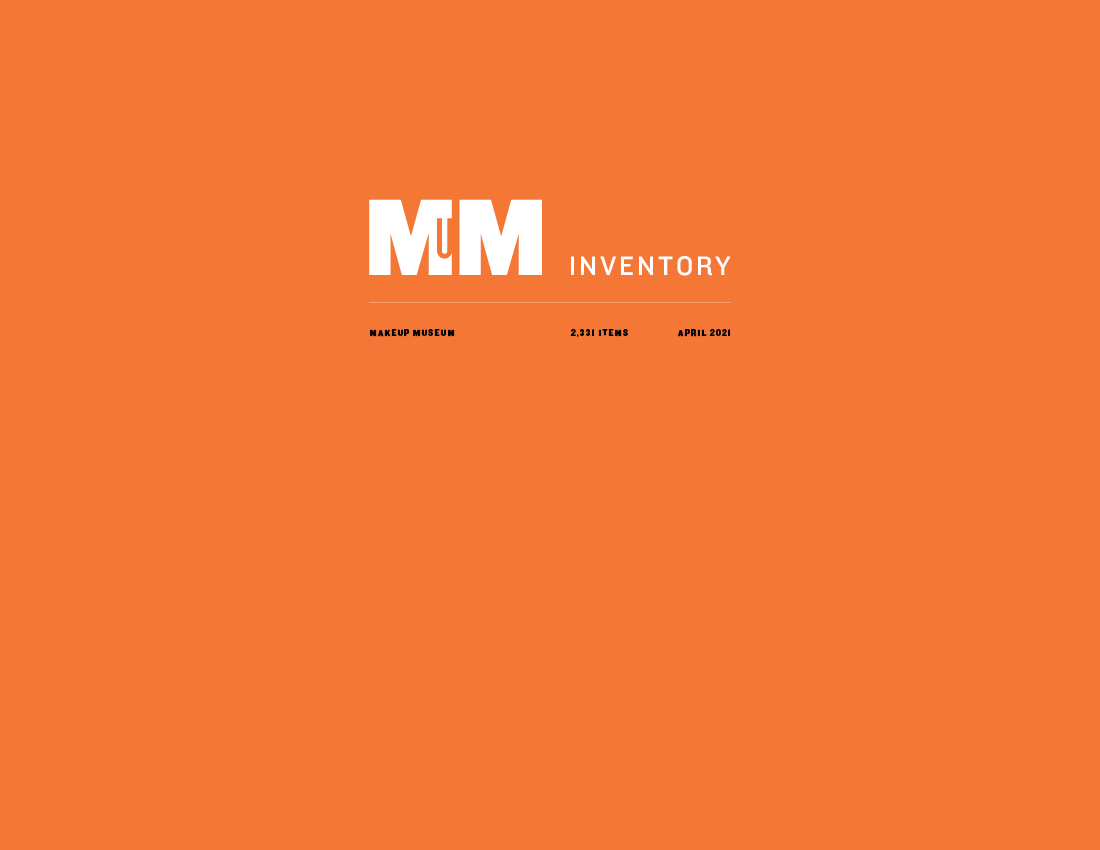
Collection Highlights
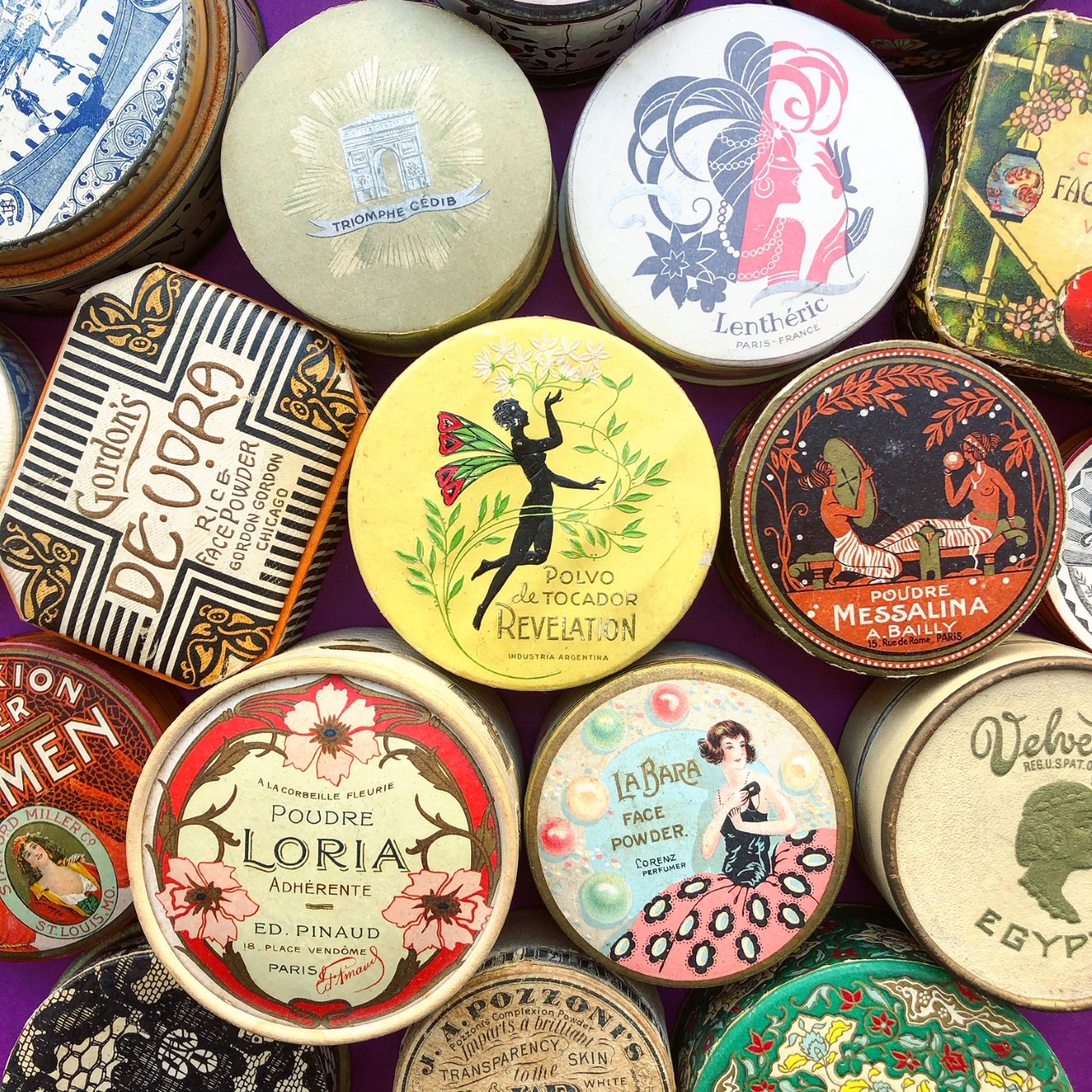
A selection of powder boxes, 1920-1930s
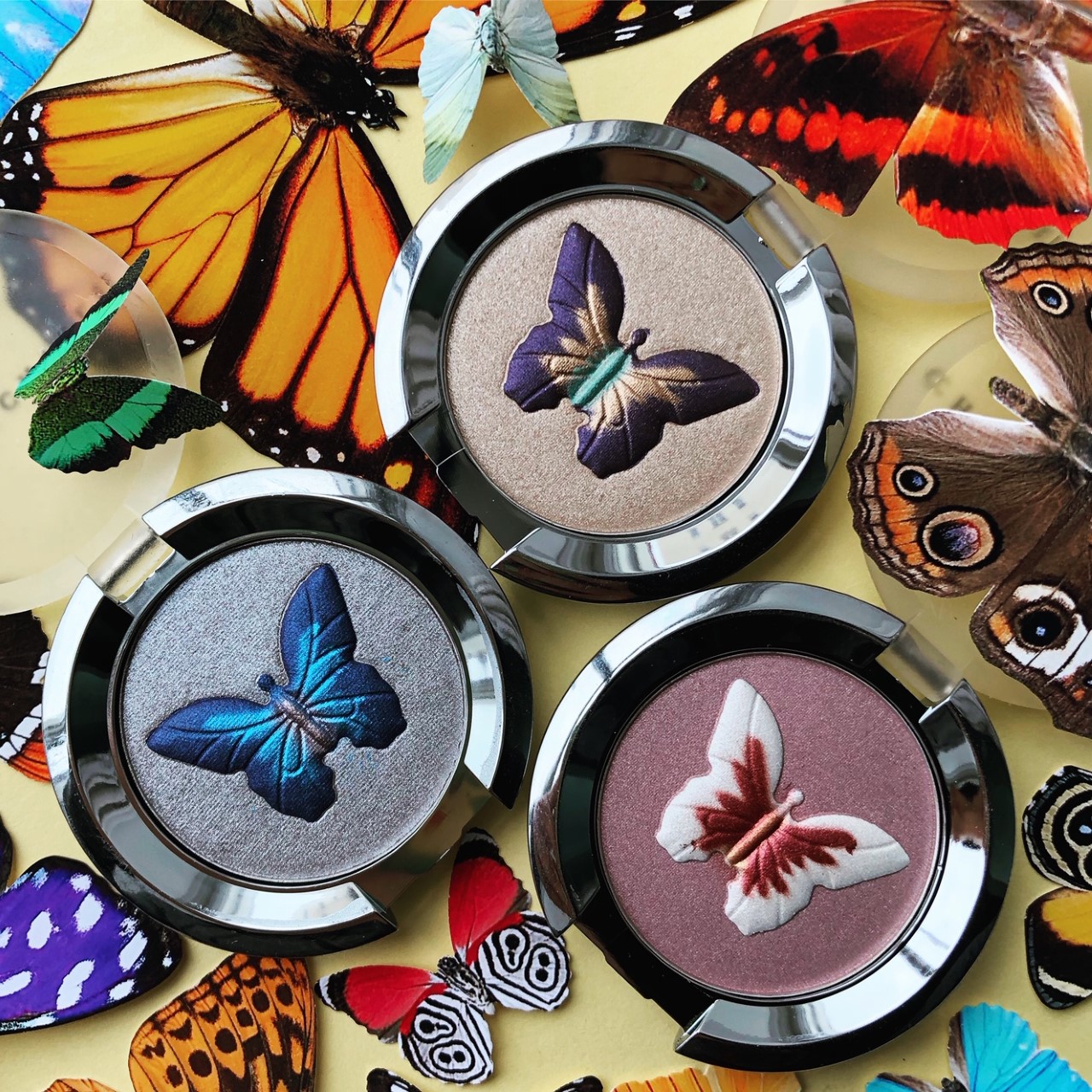
Chantecaille Butterfly eyeshadows, spring 2006
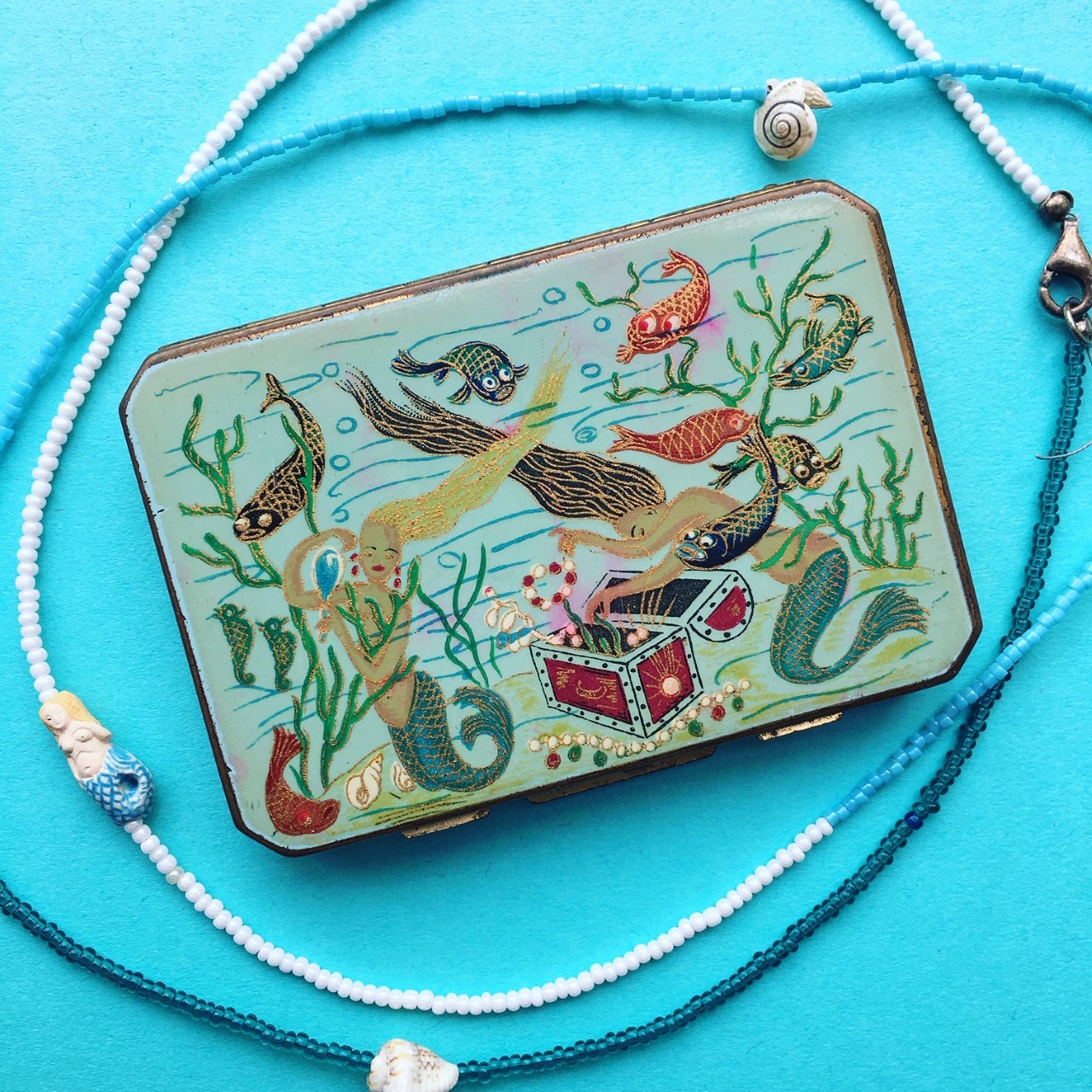
Stratton mermaid compact, ca. 1940s
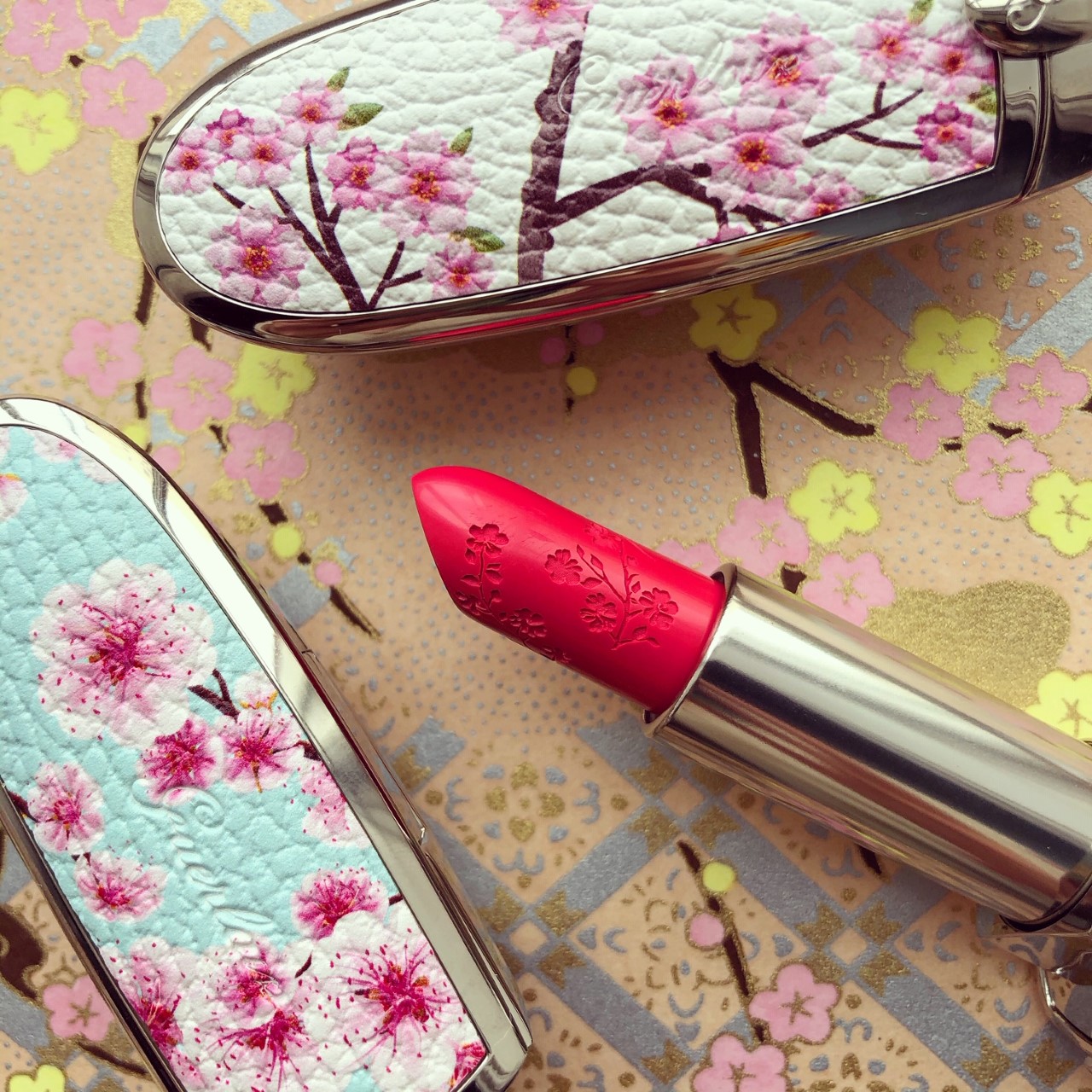
Guerlain Cherry Blossom lipstick and cases, spring 2020
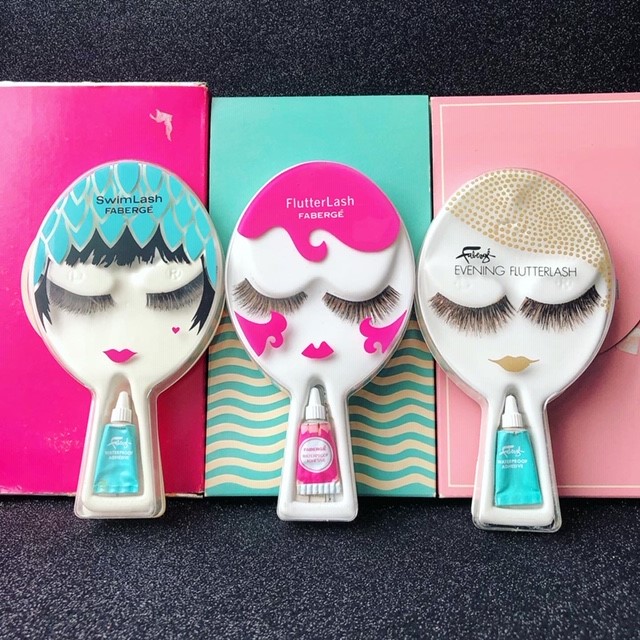
Faberge false eyelashes, mid to late 1960s
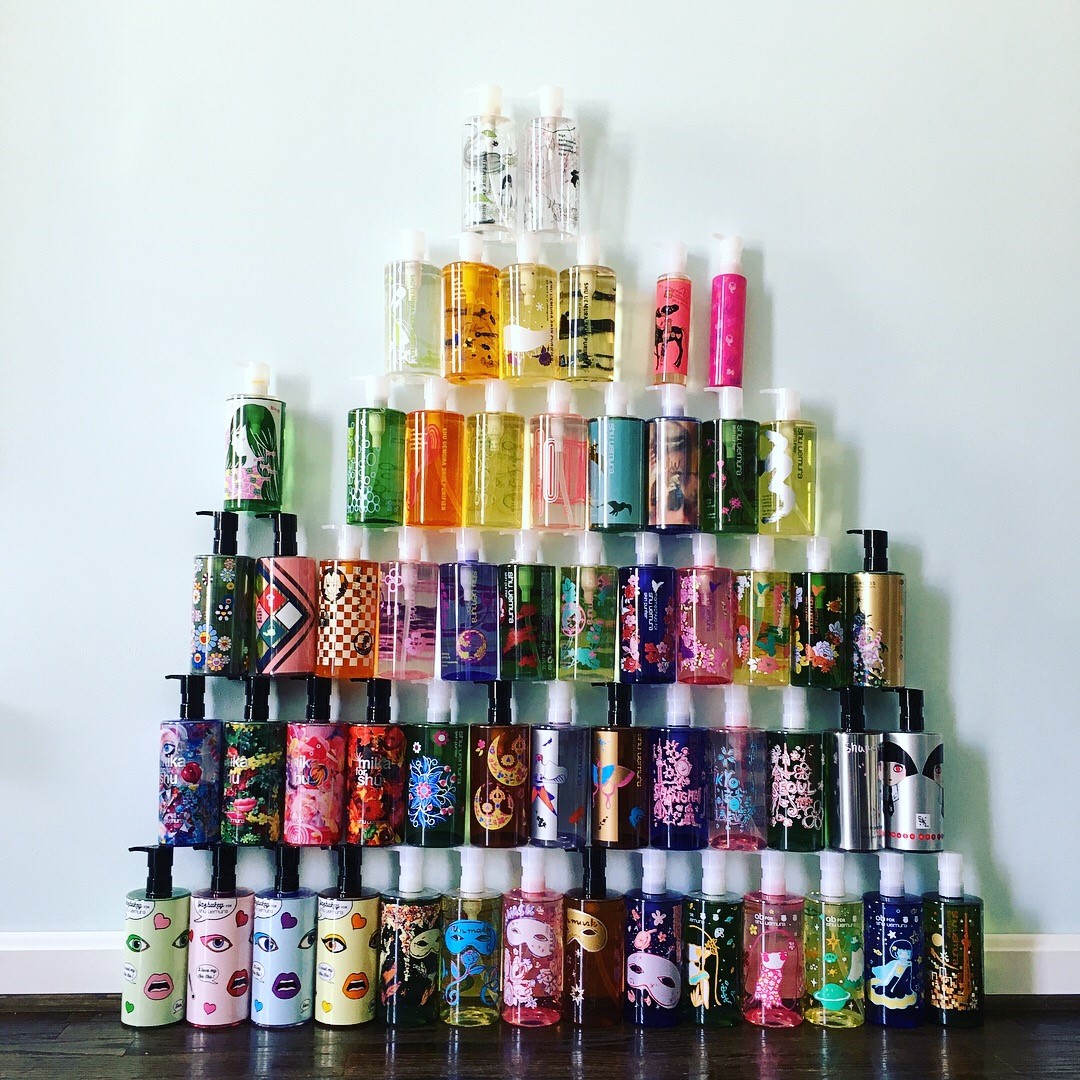
Shu Uemura cleansing oils, 2004-2018
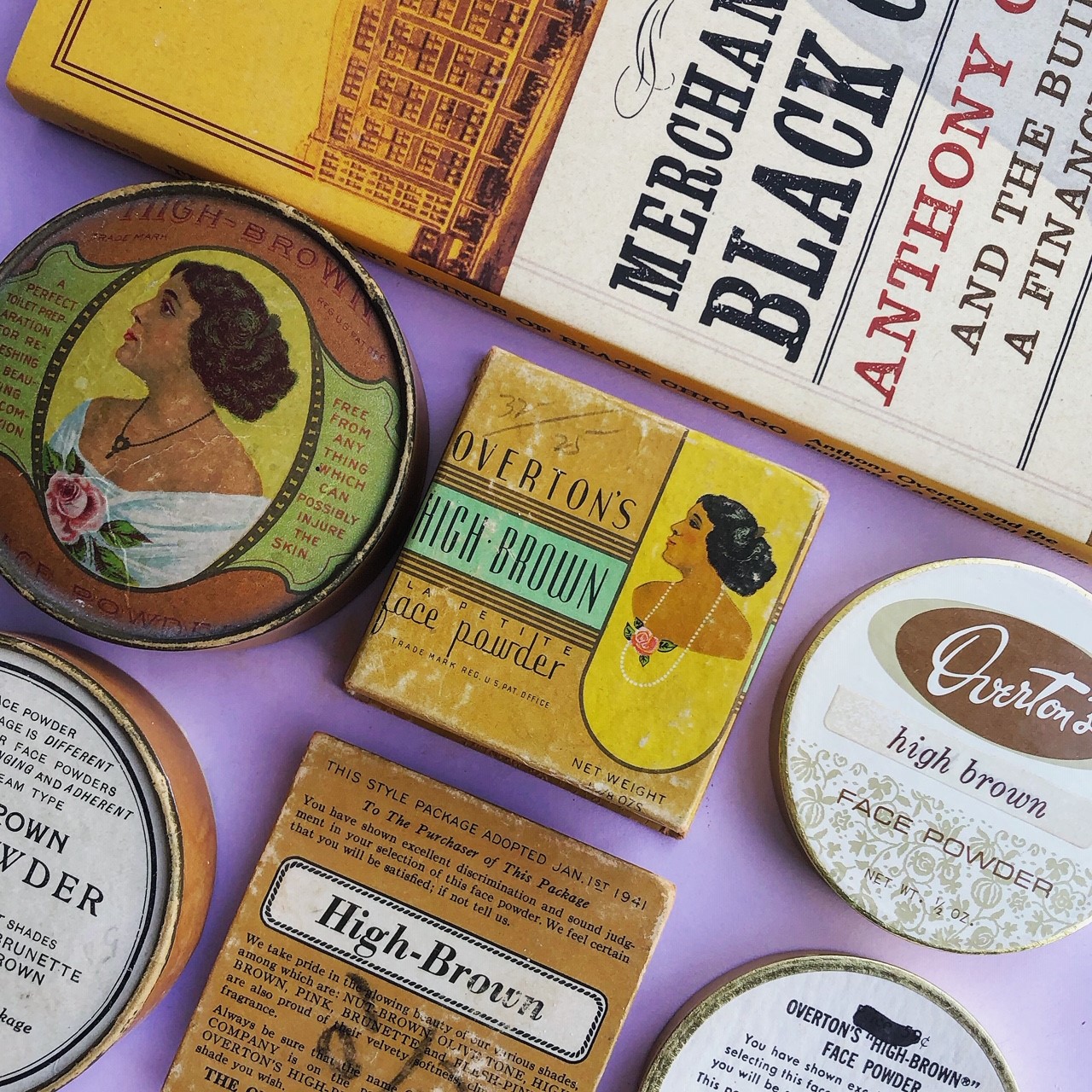
Overton’s face powder boxes from the 1920s through the early 60s
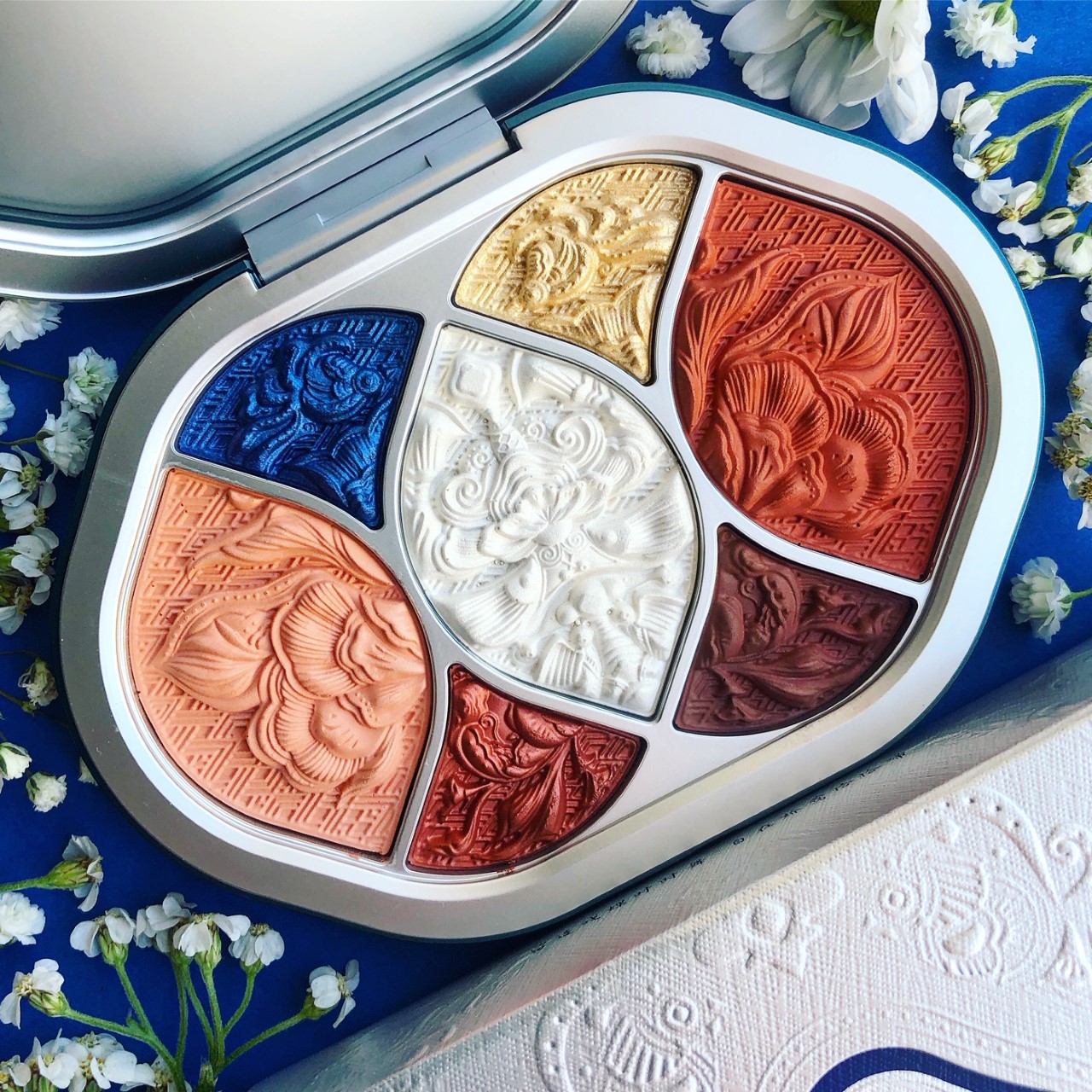
Florasis Miao palette, fall 2020
At a recent trip to the dermatologist, I asked if there was any treatment that could lighten the freckles I have dotting my face. Many of my formerly cute, small freckles are quickly becoming larger, unattractive splotches (a.k.a. "age spots") so I thought it would be better to nip them in the bud. (Of course, I could just buy a bejeweled elephant brooch to distract from them.) The experience jarred my memory of Lancôme releasing a "freckle pencil" many years ago that would allow one to paint one's face with as many specks as they wished. With that, I thought I'd look into the history of freckles from a beauty standpoint, starting in the 20th century, with an emphasis on the rise of creating faux freckles with makeup. I found that, much like Sgt. Pepper's Lonely Hearts Club Band, they've been going in and out of style (but they're guaranteed to raise a smile).
From the late 19th through the early 20th century, freckles were seen as unsightly blemishes that needed to be banished from the complexion, as demonstrated by this Pond's Vanishing Cream ad from1910.
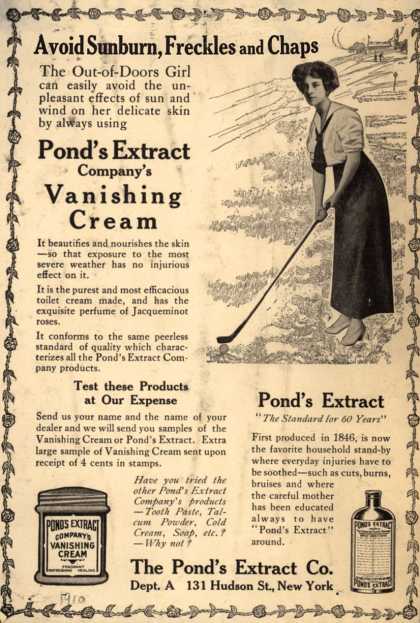
(image from vintageadbrowser.com)
Some ads, like these for a potion known as Othine, were downright harsh – freckles are "homely" and shameful. These are from 1914 and 1928.
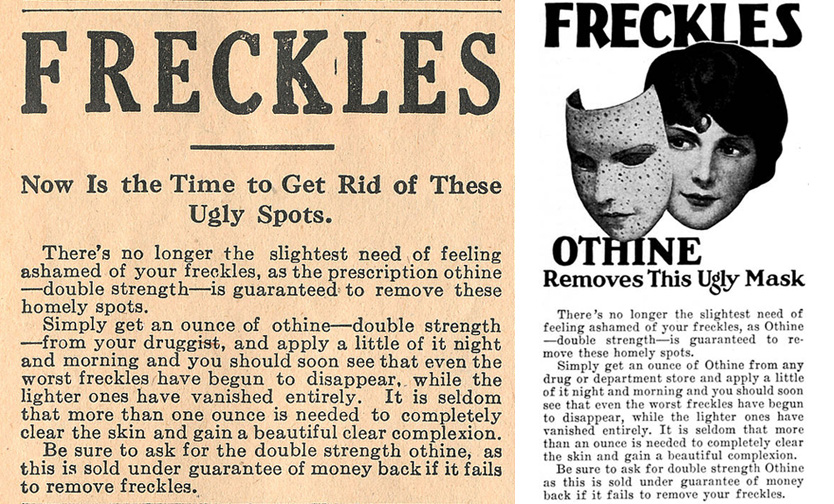
(images from flickr.com and cosmeticsandskin.com)
Perhaps the most well-known freckle antidote was Stillman's Freckle Cream. Below are ads from 1925 and 1934.
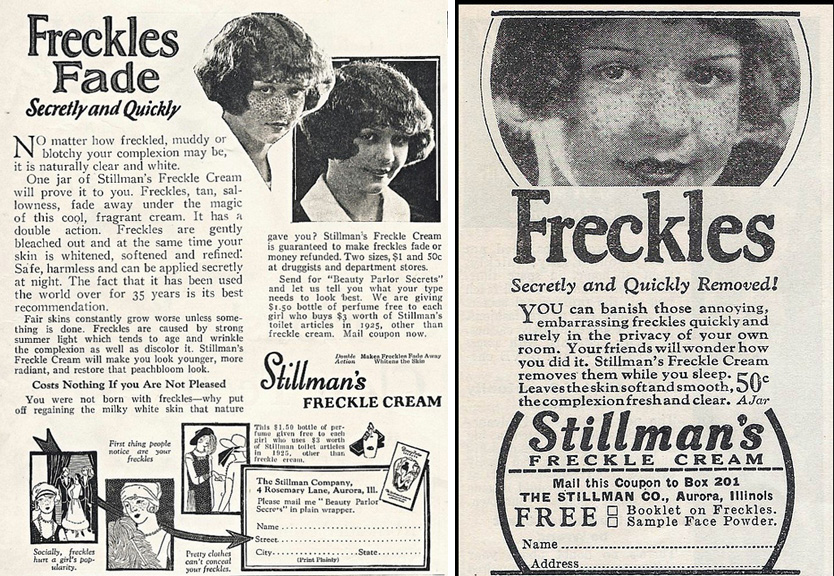
(images from tothetwenties.blogspot.com and flickr.com)
Stillman's continued selling their freckle cream throughout the 20th century and, oddly enough, the company exists today (although they mostly sell an alternative lightening cream to the Middle Eastern market). Here's an ad from 1956 and a picture of their contemporary freckle cream.
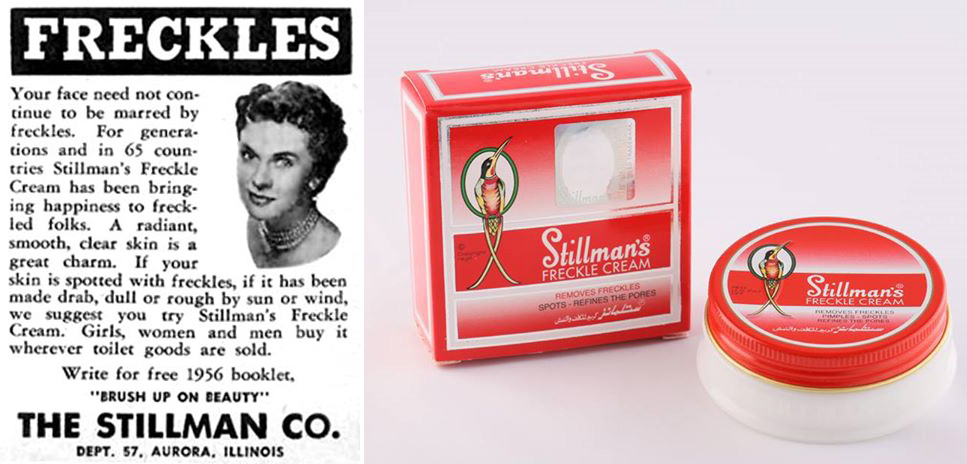
(images from cosmeticsandskin.com and facebook.com)
I can't explain exactly how or why a shift occurred in the perception of freckles, but somewhere in the mid to late 20th century they became acceptable and even desirable (see this article for possible reasons). Perhaps the rise of the tan's popularity was a factor – as early as the 1950s, tans correlated to health and a life of leisure, and a byproduct of spending quality time in the sun is the production of freckles. By the '90s, freckles were also linked to a more youthful appearance, an association that continues over 20 years later.
It seems that Chanel was the first company to market a product designed to create faux freckles. Released in 1995, Le Crayon Rousseur was "part of Chanel's effort to gain a high-fashion profile," according to Chanel's then market development manager Timothy Walcot, who added that "the `little girl' look is quite in. This is intended as a bit of fun." The instructions that came with the pencil recommended that it be used to "emphasize a light tan" as well.
Indeed, freckles quickly became a symbol of a carefree summer spent lounging under the sun's rays, as this Lancôme ad from 1995 can attest.
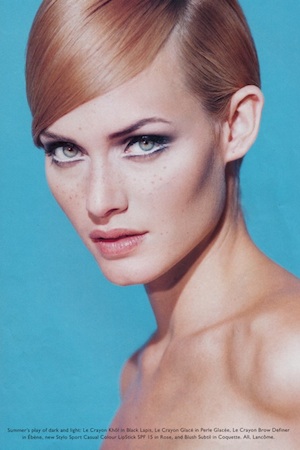
(image from style.com)
Lancôme followed in Chanel's footsteps 8 years later by releasing a Freckle Crayon as part of their summer 2003 collection. The mind behind the pencil, then artistic director Ross Burton, declared that "freckles are a symbol of freedom". Instead of trying to hide their spots with several inches of caked-on foundation, women were encouraged to "free" themselves from makeup and embrace their natural skin. And, of course, they were again associated with a summer vacation: "The natural, sun-kissed look is set to be big for spring/summer,'' stated a Lancome beauty counter rep. The company wasn't necessarily trailblazing – freckles had been "in" at least since 2001, when celebrities like Lucy Liu and top models Maggie Rizer and Devon Aoki proudly displayed their spots.
Sephora followed suit some time later, releasing a "My Lovelii Freckles" pencil as part of their now-defunct Piiink line. In the spring of 2009, makeup artist Charlotte Tilbury used a MAC lip pencil to draw dots on the models' faces for Matthew Williamson's spring 2009 runway show.
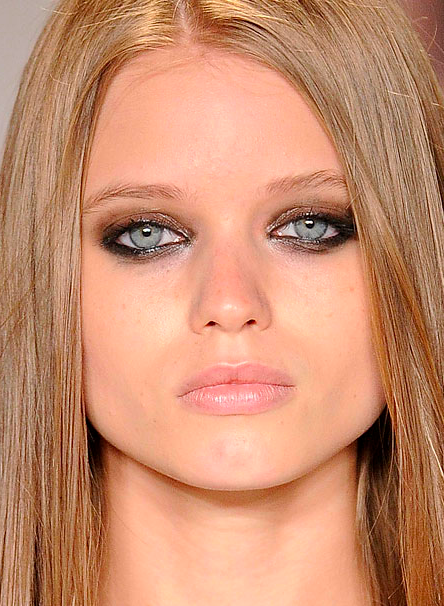
(image from style.com)
Each year since then, faux freckles made an appearance in at least one runway show. Let's take a look at some examples.
A model right before Rachel Comey's spring 2010 show:
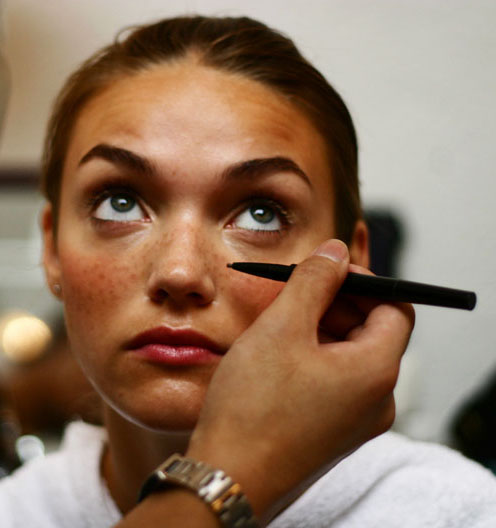
(image from lederniercri.it)
Chloe Fall 2011 (also by Charlotte Tilbury):
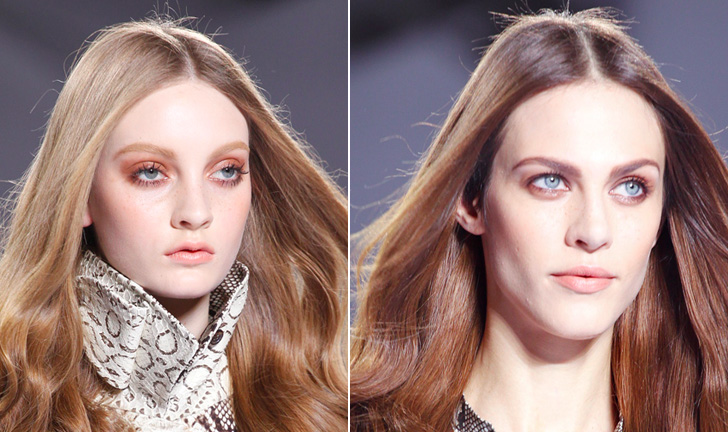
(images from style.com)
The trend grew by 2012, where faux freckles dotted the faces of models at the spring shows for Jeremy Scott, Dsquared, Emmanuel Ungaro, D&G, and Donna Karan.
Donna Karan, where Tilbury struck again.
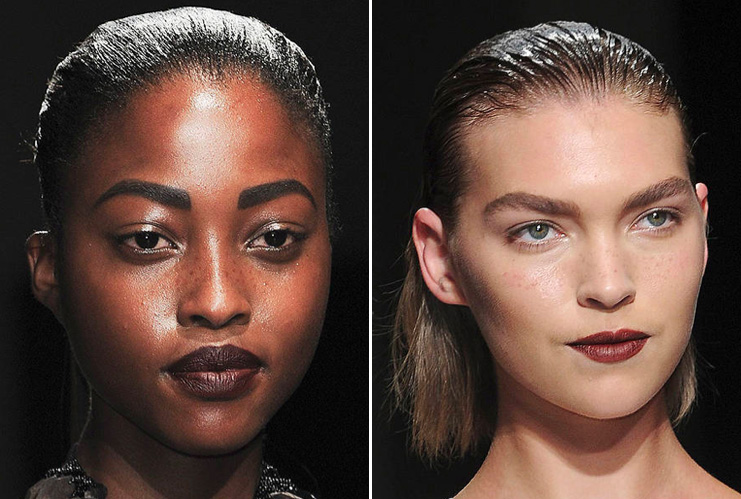
(images from elle.com)
Dsquared and Emmanuel Ungaro:
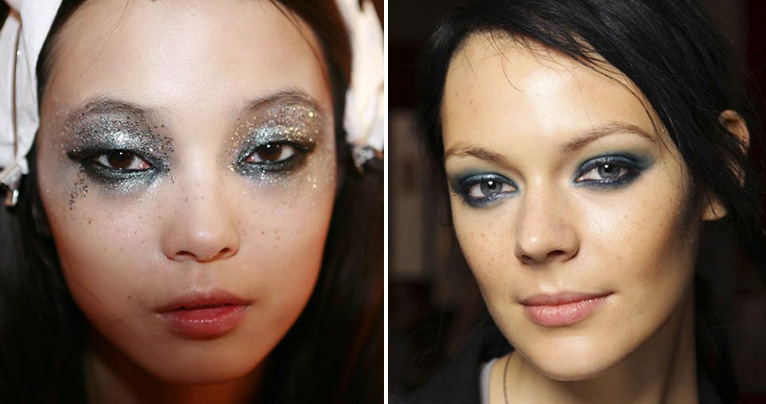
(images from makeupforlife.net and beautyeditor.ca)
Jeremy Scott:
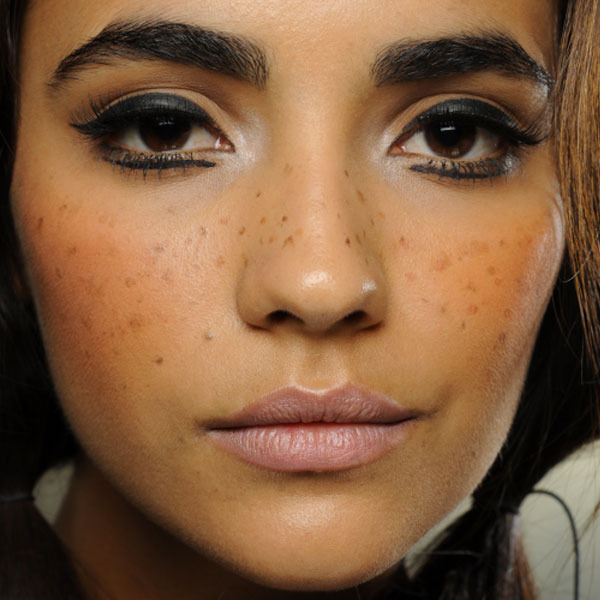
(image from beautylish.tumblr.com)
D&G:
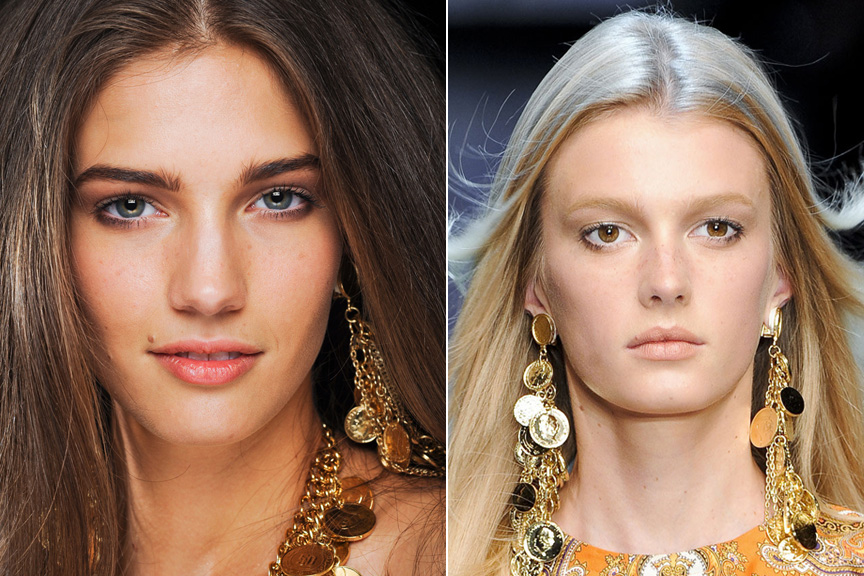
(images from foros.vogue.es)
By 2013, freckles had firmly established their role as an anti-aging strategy. "According to makeup pro Ruth Crilly, the easiest way to keep your youthful visage is to fake a few freckles," states an article at Refinery29. Adds Pixiwoo.com makeup artist Sam Chapman, "There’s something youthful and fresh about freckles." The spring 2013 shows further cemented the trend, with freckles proving especially popular at London Fashion Week (where, notably, Tilbury referred to the MAC pencil she uses to create the freckles as a "youth stick".)
Kinder Aggugini:
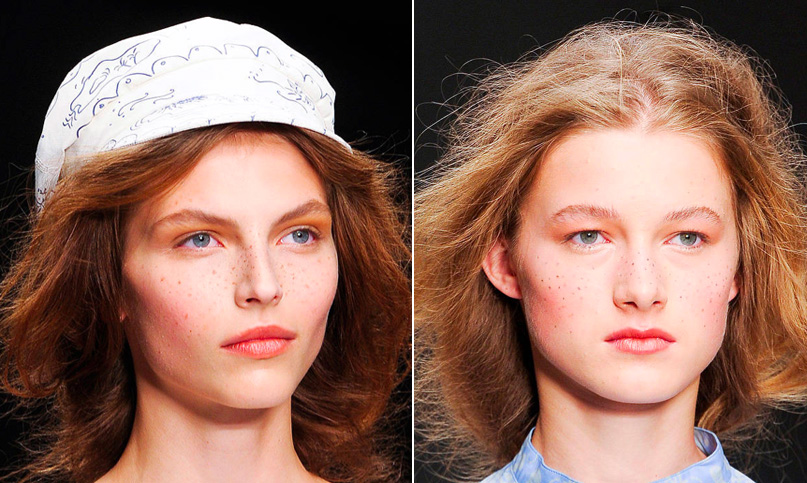
(images from elle.com)
Antonio Berardi (the makeup was done by Gucci Westman, who also allegedly painted on fake freckles for both Rag & Bone's spring 2012 and 2013 shows – however, the models' complexions looked totally clear in the pictures I found.)
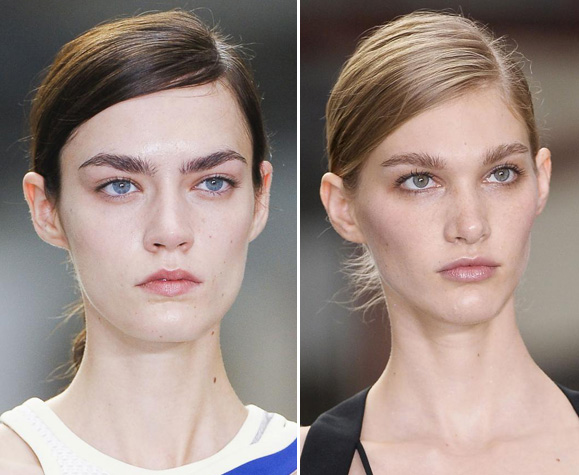
(images from fashionising.com)
Moschino Cheap and Chic:
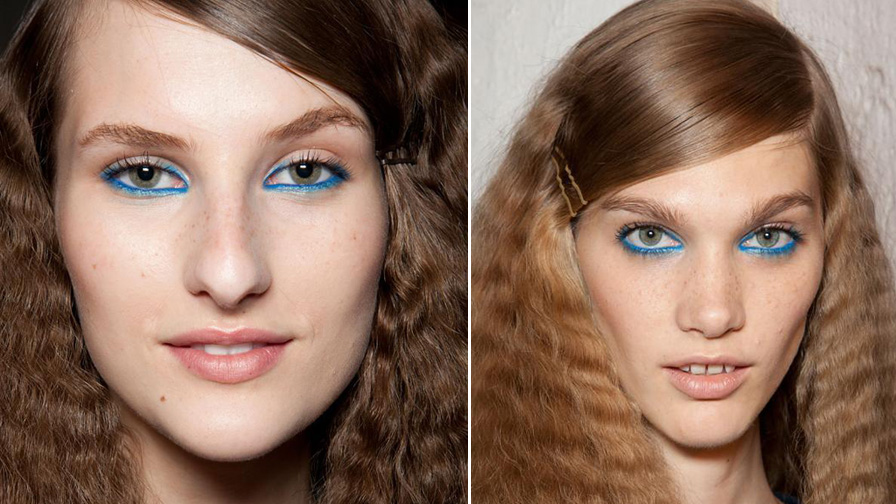
(images from fashionising.com)
Holly Fulton:
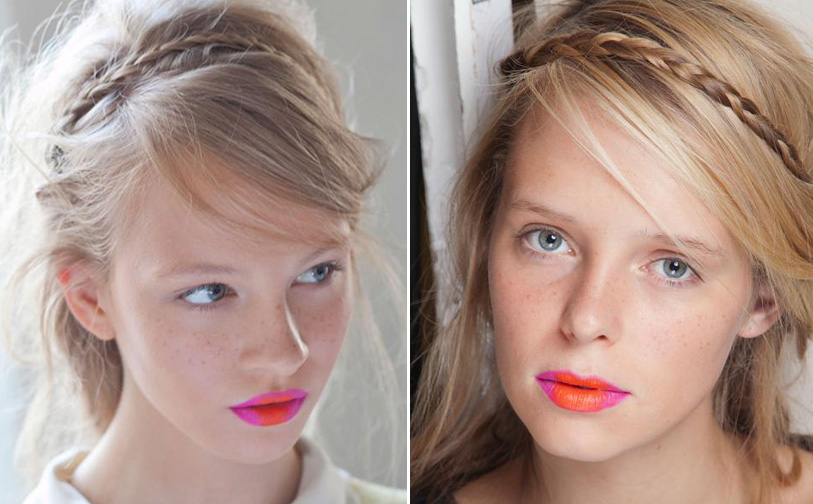
(images from makeupforlife.net and thelookbookphilosophy.com)
Pucci Fall 2013:
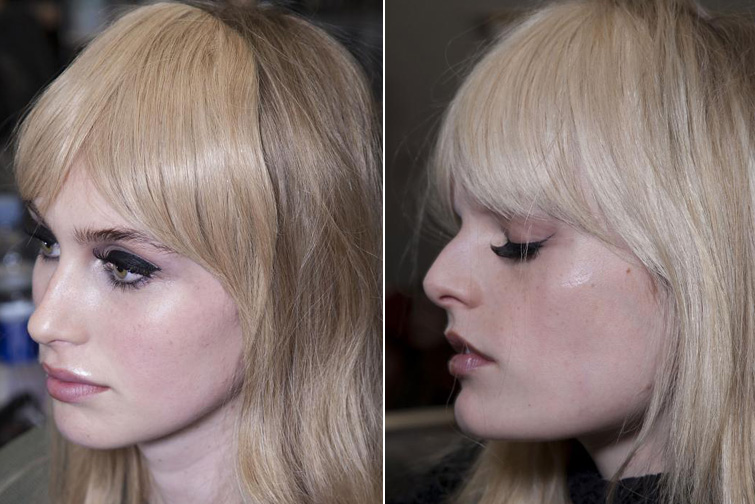
(images from fashionising.com)
Lisa Perry Fall 2013 – makeup by Westman (I'm beginning to think both she and Tilbury are a little obsessed with freckles!):
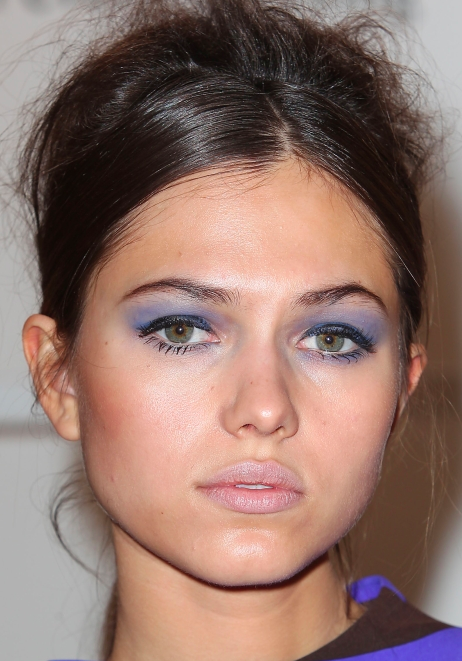
(image from socialvixen.com)
However, the addition of faux freckles isn't solely to give a youthful touch. At many shows, fake spots served an additional purpose: giving the overall look a retro twist. Tilbury cited the styles of Anita Pallenberg and Charlotte Rampling for the slightly '70s look she created at Chloe's fall 2011 show. For the 2012 D&G show, Pat McGrath said her inspiration came from a '60s style icon: "The look is all about the girls looking beautiful. We were looking at photos of Talitha Getty…the way she looks with the beautiful eyebrows and the freckles and fabulous eyes and we've done a very modern, fresh version of that." And MAC makeup artist Andrew Gallimore created a “cool California L.A. 50’s girl with a toasted tan, summer freckles, and a sunblock-neon lip” for Holly Fulton's spring 2013 show.
Meanwhile, Westman referred to several '90s types for her work at various spring 2013 shows. For Antonio Berardi, she says, "The Antonio Berardi girl is sporty, very clean and fresh…a girl reminiscent of a 90s Helmut Lang girl…we used Brown ColorStay Eyeliner to add freckles which gave the girls a youthful look." For Rag and Bone, she was inspired by "the iconic supermodels of the 90’s and the great structure of their brows." She adds, "I kept the makeup very pure, adding just a touch of natural flush to the lips by mixing two lip products together, and I used a brow pencil to create subtle freckles and a dramatic brow to top the whole look off.” Finally, for Lisa Perry, Westman went further back in time to the '60s: – "I focused on the eyes and went for something retro…I kept the skin simple and natural and created subtle freckles on the nose with a nude pencil."
Despite the popularity of freckles on the runway, there has been some ambivalence in the beauty community as to whether it translates to the real world. While in May 2013 Refinery29 was touting freckles' seemingly miraculous anti-aging properties, just a year and a half prior they were asking their readers whether they'd embrace the trend. The Gloss asked whether it was even appropriate to try to poach something that occurs naturally in many peoples' skin. Says the author, "This trend reminds me of my redheaded high school friend who despised bottle redheads, or my glasses-wearing friend’s rancor towards people who wore prescription-less glasses." As of spring 2013, The Gloss is definitively in the no-fake-freckle camp.
Additionally, the fact that makeup companies have not recently seized the opportunity to cash in and re-introduce freckle pencils might point to a dislike of, or perhaps disinterest in, the fake freckle trend. The lack of freckle pencils on the market could also be in part the result of Tilbury's and Westman's divulgence of the exact products they use to create a speckled effect, which already exist – it would be difficult to convince people to buy a new, specialized product when they can already buy something that would give the same look. Similarly, there's a wealth of tutorials on how to draw fake freckles using a variety of products, from eyebrow pencils to self-tanner painted on with a tiny brush.
My final thoughts: Personally, I'm indifferent to natural freckles. Some people have them, some don't, and I don't think people are more or less attractive because of them. I never really noticed mine, even, until Lancôme came out with that pencil! Now that they're getting bigger and starting to take over my face due to ever-advancing age, I'm more aware of them, but overall they're just another part of one's face. My indifference to real freckles means that I do find it strange that people would want to fake them, as I don't see them as a beauty trend one way or the other. They just…exist. Still, the makeup junkie in me can understand fake freckles – theoretically, it's not really much different than partaking in other makeup application. Why does anyone wear blue eyeshadow or paint their nails?
What do you think of both naturally-occuring freckles and the drawn-on ones seen on the runways? And what do you think caused the shift in the past 100 years from their perception as ugly blemishes to indicators of youth? Have you ever or would you paint on some fake specks?
No posts for this week and no Curator's Corner today, but I'm pleased to announce that Ada Calhoun, one of the authors behind the awesome 90swoman.com blog, asked me to write a piece on 90s womanhood!! I was so honored. Naturally my thoughts went to makeup and 90s beauty trends. And also naturally, I was extremely long-winded so the piece was edited ever so slightly so as not to bore readers. However, I have no issue with boring my own readers (all 2 of them, ha), so here it is in its entirety. Enjoy! And do check out 90swoman.com, even if you're not of that generation – it's truly a fascinating look at the era. :) Thanks again, Ada!

Uma Thurman rocking Chanel Vamp nail polish in 1994's Pulp Fiction.
(image from movieretriever.com)
Matte brown lipstick. Heroin chic. White eye shadow. The grunge look. These were the major beauty trends of the 90s. And they’ve been earning the attention of the fashion and beauty world in the past year or so. In January 2010 Selfridges staged an in-store exhibition devoted to the 90s, complete with a vintage M.A.C. Cosmetics face chart showcasing their (at the time) wildly popular brown lip liner named, appropriately enough, Twig. Fashion and beauty bloggers have also been covering the revival of the decade’s trends. “Messy plaids, patchwork and the overall look of 90’s grunge is back for Fall 2010, and we aren’t just talking about the fashion. The beauty industry is taking its cue from the Courtney Love days of dark, red lipstick paired with overdone, smoky eye make-up…A disheveled plaid tee layered under a floral dress and dirty boots are the perfect balance with a dramatic ‘I don’t care’ make-up look,” wrote Jessica Ciarla at The Fashion Spot. Last summer beauty blog Lovelyish provided a nostalgic look at 90s makeup trends. This year, fashion blog Refinery29 reports that the “sleeper hit” of summer 2011 is 90s grunge lip color: “Even though summer is currently awash in happy, vivid corals and pinks, there's another lip trend we've been tracking, too: A modern version of grunge-inspired lips. Mixing deep magenta-red with a little shimmer, they're like the love child of a '90s era Drew Barrymore and Married with Children's Kelly Bundy… pair your tribute-to-the-nineties lip with extra dark brows and matte skin. So angst-y!” Finally, retailer Urban Outfitters named Cher from 1995’s Clueless their latest beauty icon.
Fashion trends, and by extension, beauty trends, are cyclical – usually about 20 years after the initial phenomenon began, it becomes in vogue once again and is slightly updated. So it’s not surprising that the 90s are making a comeback now.
But the point I want to make isn’t that the 90s are back fashion and makeup-wise. Rather, I want to take a look at the transformation the beauty industry underwent in the 90s as a direct response to the new notions women had about makeup. In 1995, the L.A. Times quoted a beauty newsletter editor as saying, "The creativity the department stores had 10 years ago doesn't exist today…the top five brands control 75% of the makeup business." Something had to give to meet the beauty needs of the 90s woman, and it did.
Between the influence of “lipstick feminism”*, Naomi Wolf’s The Beauty Myth, Riot Grrrl (and “girl power”, its co-opted, commercialized, mainstream offshoot made popular by the Spice Girls), and the smeared red lipstick of grunge poster child Courtney Love, more and more 90s women began wearing makeup not with the simplistic goal of looking pretty, but rather as a means of self-expression and empowerment. They also didn’t want to feel as though they were being brainwashed by cosmetic companies telling them that they wouldn’t be beautiful without makeup – wearing it had to be their decision alone, and they would wear it (or not) on their own terms. This outlook represented a huge shift in thinking about cosmetics, and beauty and business gurus pounced on it.
In 1994 makeup artist Jeannine Lobell created a makeup line called Stila. The name coming from the Italian word “stilare”, which means “to pen”, Lobell believed every woman’s makeup should be as unique as her signature. The cardboard containers (this environmentally-friendly packaging was a breakthrough at the time) also displayed quotes from famous women that could be seen as empowering: Elizabeth Cady Stanton’s “The best protection any woman can have is courage,” and "Failure is impossible" by Susan B. Anthony are just a few of the quotes that made an appearance on Stila’s eye shadows. These marketing strategies encouraged the idea that women could let their individuality shine through their makeup, and that it could even make them feel powerful.
1995 and 1996 saw the introduction of “alternative” makeup lines Hard Candy and Urban Decay, respectively. Both got their start by introducing non-traditional nail polish colors that the founders first mixed themselves – Sky, a pastel blue, in the case of Hard Candy, and a purple color from Urban Decay. And both were revolutionizing the beauty industry and filling in the gaps left by mainstream cosmetic companies by offering non-traditional hues. From the Urban Decay website: “Heaven forbid you wanted purple or green nails, because you’d either have to whip out a marker, or risk life and limb with that back alley drugstore junk…The first magazine ad [for Urban Decay] queried ‘Does Pink Make You Puke?,’ fueling the revolution as cosmetics industry executives scrambled to keep up.”
A 1998 New York Times profile of Hard Candy founder Dineh Mohajer, states that she was a leader in providing the modern teenage girl with the daring makeup she wanted to use to express herself. “Ms. Mohajer's timing couldn't have been better: young women were ready for hard-edged, ‘ugly’ colors, which were a departure from the powdery, harmless pinks that once accompanied every American girl's journey to womanhood. Suddenly, blue lips, blue hair and blue fingernails became a statement about independence — even if independence might make you look as if you were suffering from frostbite.” Still, in the article Mohajer insists that ''I didn't make that first batch of blue nail polish so I could stand up to men or be outrageous…or so I could make some sort of stand for women.” She continues: “[what] it's really about is self-esteem, women being able to do whatever they want and look stylish and attractive and cute at the same time.” Mohajer, who was all of 22 when she founded Hard Candy, clearly represented the new way in which women were viewing makeup.
The decade culminated in the 1999 release of celebrity makeup artist Kevyn Aucoin’s iconic book Making Faces. The book offered details of makeovers performed on “real” women, and provided step-by-step instructions to create a myriad of looks. Women could essentially try on personalities like “The Diva” or “The Siren” through makeup. Aucoin writes in the introduction, “…it is my hope that you will find yourself, or rather, your selves inside.” His book was illustrative of the sweeping change that took hold in both the general population’s notion of cosmetics and the beauty industry.
Where does all of this leave us now? I’m of the opinion that if you asked teenagers and women today, most would say they don’t wear makeup for anyone but themselves. Personally I wear it because it makes me happy and because I think it’s fun to play with color, not because I feel as though I have put on my “face” before going out in public. While I can’t know for sure what other women think, I have a feeling most of my generation and younger generations share this perspective. That is one of the indisputable legacies of the 90s.
So, girls and women of today, bear in mind that your perception of cosmetics is in some way descended from ground-breaking beauty philosophies that were set in motion some 20 years ago. The notions that makeup can be a creative outlet and a way to express your individuality were forged back then. And if you’re a true 90s woman, relish the current comeback of makeup trends from your decade…everything except the matte brown lipstick.
*The debate between lipstick feminists and second-wave feminists is far too broad to discuss in this post. I’m leaving out the argument as to whether women should or shouldn’t be participating in beauty rituals; I’m only mentioning lipstick feminism as one of the many reasons for the change in women’s perception of wearing makeup in the 90s.
About and History
Dedicated to the preservation, research and exhibition of cosmetics from antiquity through the 21st century, the Makeup Museum® is a progressive, unique space that explores makeup history, culture, design and packaging from all eras. The Makeup Museum is the first museum in the U.S. devoted exclusively to cosmetics and a leader in conceptualizing new ways of thinking about makeup and its cultural and artistic significance. Particular focus is given to previously hidden or little-known about histories and topics, offering an alternative account of makeup that challenges conventional narratives and highlights the voices of marginalized communities. Using an interdisciplinary approach that blends a variety of fields, especially material culture, art history, sociology, business, race and gender studies, the Makeup Museum offers a truly original perspective on makeup that goes beyond the canon.
In 2006, the Museum’s founder and curator had the idea to develop a coffee table book devoted to the most beautiful makeup from the 1990s and early 2000s. From that idea grew the bigger notion of an entire museum to display these objects, along with older pieces and a visual history of the makeup industry. In 2008 the Museum’s website was launched as a way to chronicle new makeup releases, research cosmetic objects and champion the idea of a dedicated cosmetics museum on a global scale. Over time the Museum evolved from a repository for well-designed makeup to a vital educational resource and agent for change.
The Makeup Museum is a 501 (c) (3) nonprofit organization and a member of the International Perfume Bottle Association, the British Compact Collectors Society, the American Alliance of Museums, and a co-founding member of the Cosmetics History and Makeup Studies Network.
Location and hours
There is no public physical space for the Museum yet, but private in-person tours of the collection can be arranged and admission is FREE! (Donations are greatly appreciated but certainly not expected.) As of September 2022, private in-person tours are no longer available due to COVID. But the magic of the internet means you can visit online 24/7. The collection as well as most exhibitions are displayed in the Curator’s Baltimore, Maryland home, while more in-depth exhibitions can be found here. Temporary/pop-up spaces are continually being explored. Subscribe to the blog feed or sign up for email updates for Museum news and announcements.
Museum Services and Inquiries
The Museum welcomes all inquiries. Please contact the Curator with any loan requests or photography permissions. The Curator is also available for press interviews, speaking engagements, consulting, research assistance, book contributions and other projects.
If you have an object you’d like to learn more about, please email the Curator with photos and any information you have. However, the Museum cannot provide valuations of artifacts. See the FAQ’s for details on object inquiries.
Mission Statement
The mission of the Makeup Museum is to:
– Preserve and document cosmetic objects from all eras and cultures for a variety of audiences: scholars, historians, makeup artists and enthusiasts, and the general public.
– Promote these objects as legitimate artifacts by examining the history, design, and artistic inspiration behind them.
– Explore the sociological and cultural impact of cosmetic artifacts, including their usage and advertising, along with makeup artistry and trends.
– Study and record the history of makeup, and serve as a worldwide research hub.
– Educate the public on the artistic, cultural, and historic value of makeup through exhibitions, publications, presentations, and workshops.
– Effect social change by displaying problematic artifacts and styles, discussing the harmful aspects of makeup history and beauty culture – both past and present – and recommending ways to take action.
Land Acknowledgement
The Makeup Museum is situated on the unceded ancestral land of the Susquehannock, Nentego (Nanticoke) and Piscataway peoples, now commonly known as Baltimore, MD. Please join the Museum in acknowledging the Native community, their elders both past and present, as well as future generations. The Makeup Museum recognizes the continued oppression of our country’s Native peoples and the role museums often play in this oppression. It also acknowledges the painful history of genocide and forced occupation of their territory, and that the Museum was founded upon exclusions and erasures of many Native peoples, including those on whose land this institution is located. This acknowledgement demonstrates a commitment to beginning the process of working to dismantle the ongoing legacies of settler colonialism. We strive to establish The Makeup Museum as an institute that develops and nurture positive relationships with the Indigenous peoples of this region as well as globally.
FY 2022 Annual Report
Download Makeup Museum FY 2022 annual report
 (image from baltimoreshoeseum.com)
(image from baltimoreshoeseum.com)  (image from etsy.com)
(image from etsy.com) (image from etsy.com)
(image from etsy.com)

 (image from library.duke.edu)
(image from library.duke.edu)  (image from library.duke.edu)
(image from library.duke.edu)  (image from periodpaper.com)
(image from periodpaper.com) (image from etsy.com)
(image from etsy.com)  (image from flickr.com)
(image from flickr.com)
 (image from etsy.com)
(image from etsy.com) (image from library.duke.edu)
(image from library.duke.edu) (image from library.duke.edu)
(image from library.duke.edu)  (image from pinterest.com)
(image from pinterest.com) (image from mudwerks.tumblr.com)
(image from mudwerks.tumblr.com) (image from pinterest.com)
(image from pinterest.com) (image from adweek.com)
(image from adweek.com)  (image from pinterest.com)
(image from pinterest.com)






























































































